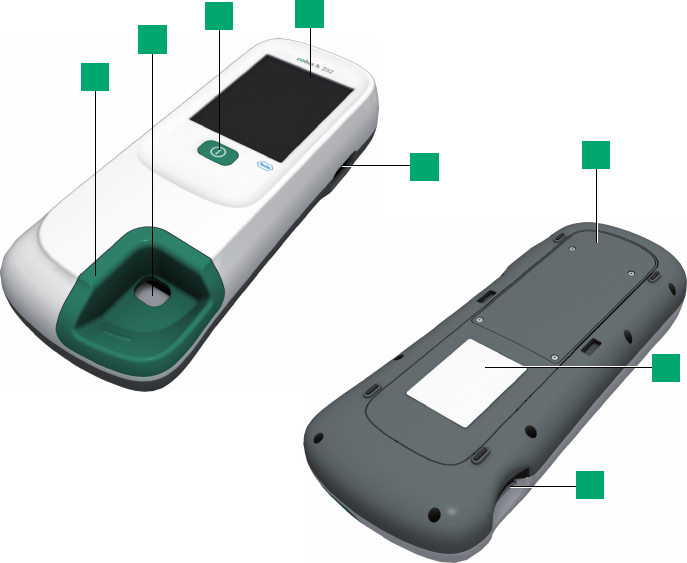Roche Diagnostics UU18 Medical Device with WLAN b/g User Manual UserManual EN
Roche Diagnostics GmbH Medical Device with WLAN b/g UserManual EN
Contents
- 1. InstallationInstructions.pdf
- 2. UserManual.pdf
- 3. UserManual_EN.pdf
- 4. UserManual_FR.pdf
UserManual_EN.pdf
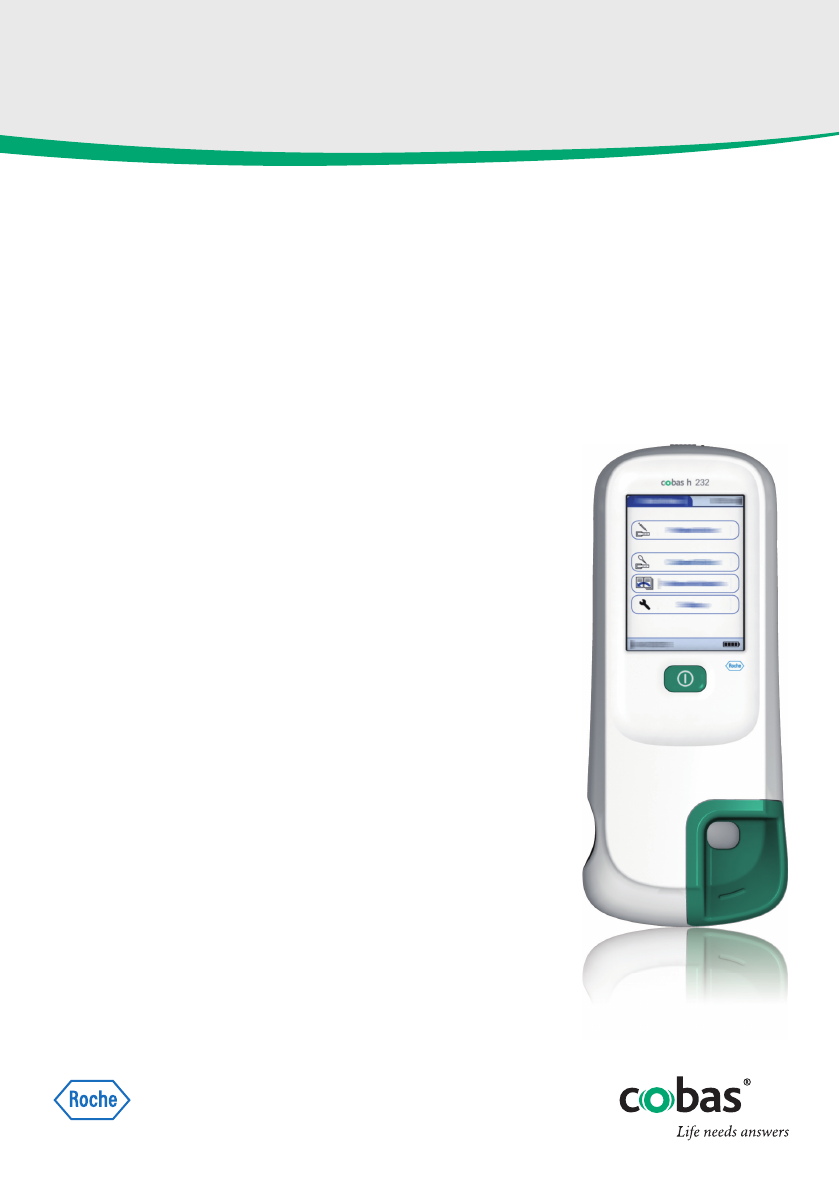
cobas h 232 POC system
Operator’s Manual

Manual version Revision date Changes
Version 1.0 2006-10 New document
Version 2.0 2009-09 Minor revisions from internal review
Version 3.0 2011-09 Update to SW 03; enhanced error messages
Version 4.0 2014-05 Added description of new OTS functionality,
miscellaneous minor revisions
Version 5.0 2015-xx Transition to new meter hardware: 2D barcode
scanner; wireless LAN option; new battery
pack. Update to SW 04.00. Update of cleaning
and disinfection section; added safety informa-
tion on battery packs; deleted appendix for
addresses; misc. editorial revisions.

0 7469101001 (01) 2015-XX EN
cobas h 232 POC system
Operator’s Manual
Version 5.0

© 2006-2015, Roche Diagnostics GmbH. All rights reserved
The contents of this document, including all graphics, are the property of Roche Diagnostics.
Information in this document is subject to change without notice. Roche Diagnostics shall not be
liable for technical or editorial errors or omissions contained herein. No part of this document
may be reproduced or transmitted in any form or by any means, electronic or mechanical, for any
purpose, without the express written permission of Roche Diagnostics.
Please send questions or comments about this manual to your local Roche representative.
ROCHE CARDIAC, COBAS, COBAS H and IQC are trademarks of Roche.
The Wi-Fi CERTIFIED Logo is a certification mark of the Wi-Fi Alliance.

5
On the packaging and on the identification plate of the meter you may encounter the following symbols,
shown here with their meaning:
On meters with WLAN capability:
For other WLAN certifications, see label on bottom of battery compartment and addendum for
information on WLAN registration.
The user is fully responsible for the installation, use and upkeep of the cobas h 232 meter.
Caution, consult accompanying documents. Refer to safety-related notes in the
instructions for use accompanying this instrument.
Temperature limitation (Store at)
Manufacturer
Catalogue number
In vitro diagnostic medical device
This product fulfills the requirements of the European Directive 98/79/EC on
in vitro diagnostic medical devices
The system fulfills the Canadian and U.S. safety requirements (UL LISTED, in
accordance with UL 61010A-1:02 and CAN/CSA-C22.2 No.61010-1-04).
This device complies with Part 15 of the FCC Rules and with RSS-210 of Industry
Canada
IVD
This page intentionally left blank.
Table of Contents
7
1 Introduction 11
The cobas h 232 meter................................................................................................................. 11
Test principle ..................................................................................................................................... 13
Contents of the Pack ...................................................................................................................... 13
1.1 Important safety instructions and additional information......................................................... 14
Safety information............................................................................................................................ 15
Disposal of the system ................................................................................................................... 17
Battery pack ....................................................................................................................................... 17
General care....................................................................................................................................... 19
Electrical safety ................................................................................................................................ 19
Electromagnetic interference ...................................................................................................... 20
Touchscreen....................................................................................................................................... 20
Local Area Network: protection from unauthorized access ............................................ 20
Wired network connection ........................................................................................................... 21
Wireless connectivity ...................................................................................................................... 22
Radiofrequency radiation exposure information.................................................................. 22
1.2 Overview of the meter and its accessories..................................................................................... 24
Meter ................................................................................................................................................... 24
Power supply...................................................................................................................................... 27
Test strip.............................................................................................................................................. 29
Handheld Base Unit ........................................................................................................................ 30
1.3 Overview of the Buttons and Icons used on Screen................................................................... 31
2 Putting the Meter into Operation 35
2.1 Installing or replacing the battery pack........................................................................................... 36
Removing the battery pack .......................................................................................................... 37
Installing the battery pack ............................................................................................................ 38
Powering the meter on and off................................................................................................... 41
3 Meter Setup 43
Settings summary............................................................................................................................. 44
3.1 Basics setup ............................................................................................................................................... 49
Contrast ............................................................................................................................................... 49
Language ............................................................................................................................................ 51
Setting the date................................................................................................................................. 53
Setting the time................................................................................................................................. 55
Setting the display options for date and time ....................................................................... 57
Sound.................................................................................................................................................... 59
Auto off ................................................................................................................................................ 62
3.2 Data Handling setup ............................................................................................................................... 64
Connection ........................................................................................................................................ 64
QR Code .............................................................................................................................................. 65
Computer............................................................................................................................................. 68
Printer ................................................................................................................................................... 69
Result memory .................................................................................................................................. 71
Result units......................................................................................................................................... 75
Result display mode........................................................................................................................ 78
Diagnostics......................................................................................................................................... 80
3.3 ID Setup setting ........................................................................................................................................ 82
Administrator ID ............................................................................................................................... 83
Operator ID......................................................................................................................................... 89
Patient ID............................................................................................................................................. 92
Table of Contents
8
3.4 Lockout setup............................................................................................................................................ 94
Operator lockout............................................................................................................................... 95
Quality control (QC) settings ....................................................................................................... 98
Quality control (QC) lockout ..................................................................................................... 100
Instrument quality control (IQC) lockout.............................................................................. 101
QC result format ............................................................................................................................ 102
Custom Range Troponin T......................................................................................................... 103
Reset test parameters.................................................................................................................. 105
Cleaning lockout............................................................................................................................ 106
STAT test configuration .............................................................................................................. 107
3.5 Optional Screens setup ....................................................................................................................... 109
4 Performing a Test 113
Sample material ............................................................................................................................. 115
4.1 Preparing to test .................................................................................................................................... 115
Code chip ......................................................................................................................................... 116
Inserting the code chip .............................................................................................................. 117
Test steps (overview) ................................................................................................................... 118
Powering on the meter................................................................................................................ 119
Logging in ........................................................................................................................................ 120
4.2 Performing a test................................................................................................................................... 123
Inserting a test strip .................................................................................................................... 127
Displaying, confirming or adding comments to results.................................................. 132
Displaying the test result as QR code ................................................................................... 135
STAT tests ........................................................................................................................................ 136
5 Control Testing and Quality Control 137
5.1 Preparing to run a quality control test .......................................................................................... 137
5.2 Performing a quality control test..................................................................................................... 139
Quality control (QC) ..................................................................................................................... 139
Displaying the QC result as QR code .................................................................................... 146
Instrument quality control (IQC).............................................................................................. 147
6 Review Results 151
Reviewing test results.................................................................................................................. 151
Patient history................................................................................................................................. 153
All results.......................................................................................................................................... 154
Quality control (QC) results....................................................................................................... 155
Instrument quality control (IQC) results ............................................................................... 156
Maintenance history .................................................................................................................... 157
7 Extended Functionalities 159
Data handling ................................................................................................................................. 159
Computer (Setup option)............................................................................................................ 160
Operator lists................................................................................................................................... 161
Patient lists....................................................................................................................................... 162
Barcode scanner............................................................................................................................ 163
Stored test results and comments .......................................................................................... 163
Table of Contents
9
8 Maintenance and Care 165
8.1 Conditions for storage and shipping ............................................................................................. 165
Storage.............................................................................................................................................. 165
Shipping............................................................................................................................................ 166
8.2 Cleaning and disinfecting the meter ............................................................................................. 167
Difference between cleaning and disinfecting.................................................................. 167
When should the meter be cleaned and disinfected? .................................................... 167
What to clean and disinfect?.................................................................................................... 167
Recommended cleaning/disinfecting agents..................................................................... 169
Cleaning/disinfecting the exterior (meter housing)......................................................... 169
Cleaning after contamination due to mispipetting........................................................... 170
Cleaning the test strip guide cover ........................................................................................ 171
Cleaning the visible area of the test strip guide................................................................ 172
9 Troubleshooting 173
Errors and unusual behavior without error messages .................................................... 174
Meter reset ...................................................................................................................................... 176
10 General Product Specifications 177
10.1 Operating conditions and technical data..................................................................................... 177
Technical data................................................................................................................................ 177
Sample material............................................................................................................................. 178
Storage and transport conditions ........................................................................................... 178
10.2 Further information............................................................................................................................... 178
Ordering information ................................................................................................................... 178
Product limitations........................................................................................................................ 180
Information about software licenses .................................................................................... 180
Repairs .............................................................................................................................................. 180
11 Warranty 180
A Appendix 181
A.1 Working with barcodes....................................................................................................................... 181
A.2 Operator and patient ID barcode masks...................................................................................... 182
A.3 Example of barcode symbologies ................................................................................................... 183
A.4 Supported characters in 2D barcodes .......................................................................................... 185
B Appendix 187
B.1 Option: Wireless network (WLAN) ................................................................................................. 187
Preliminary note............................................................................................................................. 187
Background..................................................................................................................................... 187
Technical implementation.......................................................................................................... 188
RF specific functionalities and effective performance claims...................................... 190
C Supplement for Observed Test Sequence 193
Observed Test Sequence (OTS) ............................................................................................. 193
Using the OTS function............................................................................................................... 194
D Contact Roche 197
Index 199
Table of Contents
10
This page intentionally left blank.
Introduction
11
1 Introduction
The cobas h 232 meter
The cobas h 232 meter is an instrument for the quantitative evaluation of immunoassays using
the gold-labeling technique. The rapid diagnostic tests in strip format available for this
meter support efficient diagnosis and assessment of cardiovascular diseases. The evaluation
of these tests with the cobas h 232 meter combines the advantages of a rapid diagnosis with
enhanced clinical interpretation of quantitative values (in comparison with qualitative tests). In addition,
automated evaluation provides more reliable results by eliminating the potential sources of error associ-
ated with visual reading. Refer to the package inserts accompanying the test strips for detailed
information on specific tests.
Readings may be carried out directly where the blood samples are taken. Therefore, the
cobas h 232 meter is ideal for use at the point of care in emergency rooms, intensive care units
and ambulances, as well as by cardiologists and general practitioners. The cobas h 232 meter is
rapid and easy to operate: Insert an unused strip in the meter and apply the sample. After the
reaction period, the meter provides a quantitative result; in addition, a qualitative result is pro-
vided prior to the end of some tests.
The cobas h 232 meter has the ability to connect to a data management system (DMS) by
means of wireless communication (if the meter is equipped with WLAN functionality) or through
the Handheld Base Unit from Roche Diagnostics (available separately). The cobas h 232 meter
supports data exchange via the POCT1A standard or directly via WLAN. Data management sys-
tems may have the ability to expand the security features of the meter, such as enabling operator
lockouts. Data management systems may also enable data transfer to an LIS or HIS. Refer to the
manuals of the Handheld Base Unit and of your DMS for technical details.

Introduction
12
Read this operator's manual, as well as the package inserts for all relevant consumables, before
using the system for the first time. You must configure the cobas h 232 meter according to your
needs before initial use. Refer to Chapter 3, “Meter Setup”. Be sure to read the “Important safety
instructions and additional information” section in this chapter before operating the system.
For all questions about the cobas h 232 system that are not answered in this manual, contact
your Roche representative (see “Contact Roche” on page 197). In order to expedite troubleshoot-
ing, please have ready your cobas h 232 meter, its serial number, this manual, and all related
consumables when you call.
If you connect your cobas h 232 meter to a cobas IT 1000 data management system or
another PC/DMS, you will not be able to print directly from the meter to a printer. In order to
print out meter data, use printers connected to the respective PC/DMS.

Introduction
13
Test principle
Two lines (signal and control line) in the detection zone of the test strip indicate whether the analyte to
be determined is present in the sample material. These lines are detected by the cobas h 232 meter
with the help of an LED (lighting the detection zone) and a camera sensor (imaging the detection
zone). The test signal (signal line) increases in intensity in proportion to the concentration of the
respective analyte. Integrated system software converts the signal intensity to a quantitative
result, which is then displayed on the screen at the end of the measurement.
The accuracy of the measurement is ensured through a simple principle: Every test strip box
includes a code chip that contains all test and lot-specific information in electronic format. The
test strips are labelled with a barcode on their underside and are hereby assigned to a specific
code chip. When you insert a test strip from a new strip lot for the first time, the meter prompts
you to plug in the corresponding code chip. The information is now read from the code chip and
stored for future tests.
Contents of the Pack
■cobas h 232 meter
■Power adapter
■Universal Battery Pack
■Operator’s manual in English
■CD-ROM with operator’s manual in other languages
Optionally available (not included in the scope of delivery):
■Handheld Base Unit (docking station) for data transfer within a network or via USB
(Universal Serial Bus)
For a personal printout of the operator’s manual in your language, contact your local Roche
organization (see Chapter A).
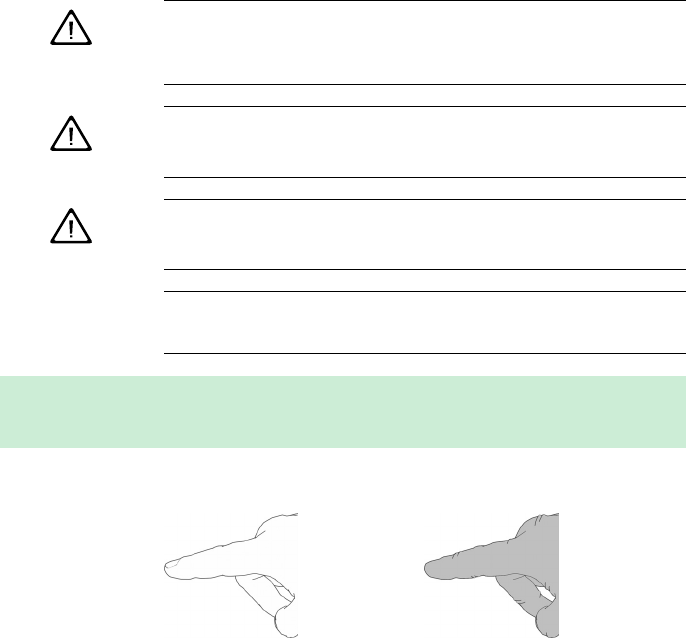
Introduction
14
1.1 Important safety instructions and additional information
This section explains how safety-related messages and information related to the proper
handling of the system are presented in the cobas h 232 Operator’s Manual. Please read these
passages carefully.
The safety alert symbol alone (without a signal word) promotes aware-
ness to hazards which are generic or directs the reader to related safety
information.
WARNING
Indicates a hazardous situation which, if not avoided, could result in death
or serious injury.
CAUTION
Indicates a hazardous situation which, if not avoided, could result in
minor or moderate injury.
NOTICE Indicates a hazardous situation which, if not avoided, may result in
damage to the system.
Important information that is not safety relevant is presented against a colored background
(without a symbol). Here you will find additional information on correct use of the meter or
useful tips.
Illustrations in this manual show two different kinds of hands:
Hand without glove Hand with glove
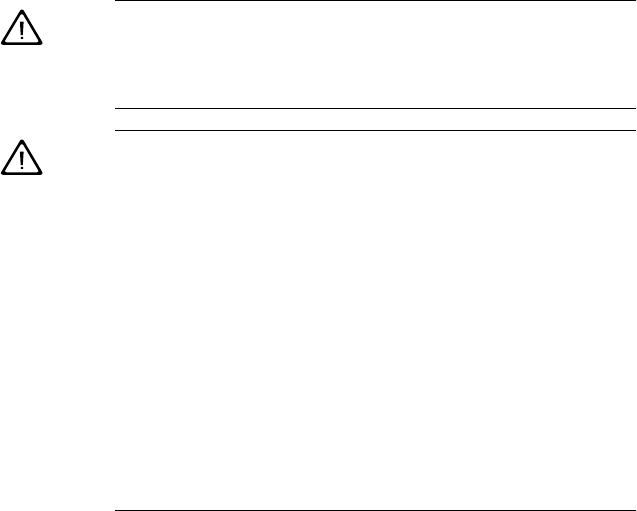
Introduction
15
Safety information
Operator qualification
Only trained healthcare professionals may operate the cobas h 232
meter. Operators must also have received comprehensive instruction in
the operation, quality control, and care of the cobas h 232 meter.
WARNING
Protection against infection and blood-borne pathogens
Healthcare professionals using the cobas h 232 meter to perform tests
must be aware that any object coming into contact with human blood is
a potential source of infection. Operators need to adhere to Standard
Precautions when handling or using the cobas h 232 meter. All parts of
this system should be considered potentially infectious and are capable
of transmitting blood-borne pathogens between patients and between
patients and healthcare professionals.
■Use gloves. Wear a new pair of clean gloves for testing each patient.
■Wash hands thoroughly with soap and water before putting on a new
pair of gloves and performing the next patient test.
■Dispose of used syringes, tubes, pipettes, test strips, and all other
materials coming into contact with blood according to your institu-
tion’s infection control policy.
■Follow all health and safety regulations in force locally.

Introduction
16
CAUTION
Allergy or injury caused by reagents and other working solutions
Direct contact with reagents, detergents, cleaning/disinfection solutions,
or other working solutions may cause skin irritation or inflammation.
■Always use protective gloves.
■Observe the cautions given in the package inserts of the reagents and
cleaning/disinfection solutions.
■If a reagent, control, or cleaning/disinfection solution comes into con-
tact with your skin, wash it off immediately with water.
■Follow all health and safety regulations in force locally.
WARNING
Avoidance of electrical shock, fire, and explosions
■Only use Roche Diagnostics original accessories (cables, power
supply units, battery packs, and spare parts). Third-party cables,
power supply units, and battery packs can cause the battery pack to
explode or the meter to become damaged.
■Do not use loose power sockets or damaged power supply units,
cables, plugs, or battery packs.
■Do not short circuit the power supply unit, the handheld base unit
contacts, or the battery pack.
■Do not drop the cobas h 232 meter, the power supply unit, or the
battery pack and protect these against shaking and vibrations.

Introduction
17
Disposal of the system
Battery pack
The meter contains a rechargeable battery pack that begins charging as soon as the power
adapter is connected or the meter is placed on an active Handheld Base Unit (i.e., one connected
to a power adapter).
WARNING
Infection by a potentially biohazardous instrument
The cobas h 232 meter or its components must be treated as potentially
biohazardous waste. Decontamination (i.e., a combination of processes
including cleaning, disinfection and/or sterilization) is required before
reuse, recycling, or disposal.
Dispose of the system or its components according to the appropriate
local regulations. Always remove the battery pack before thermal
disinfection.
NOTICE Use only the specially designed battery pack provided by Roche Diagnos-
tics. Using any other type of battery may damage the system.

Introduction
18
WARNING
Possible hazards posed by the battery pack
Damaged or swollen battery packs can overheat, catch fire, or leak.
Immediately cease use of cobas h 232 meters with damaged or swollen
battery packs and under no circumstances recharge them (do not place
in the Handheld Base Unit).
Overheating can cause the battery pack to catch fire or explode.
■Never throw the battery pack or the meters onto a fire. Do not dis-
mantle, compress, or pierce the battery pack as this could cause an
internal short circuit that leads to overheating.
■Do not place either the battery pack or the cobas h 232 meter on or
in heating appliances, such as a microwave, conventional oven, or
radiator.
■Avoid prolonged exposure to direct sunlight, e.g., when the meter is
docked in the Handheld Base Unit. Keep this in mind when position-
ing the Handheld Base Unit.
Battery fluid or materials leaking from damaged battery packs can irritate
your skin or cause burns due to high temperatures.
■Avoid contact with leaking battery fluid. In the event of accidental
contact with the skin, rinse with water. If you get battery fluid in your
eye(s), you should also seek medical attention.
Handle and dispose of battery packs with care.
Extreme temperatures reduce the charging capacity and usage period of the meter and the
battery pack.
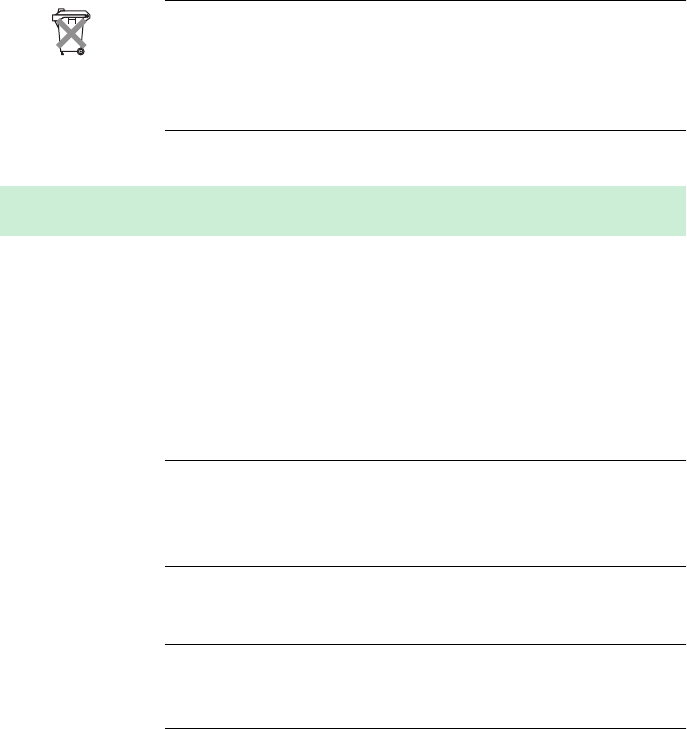
Introduction
19
Observe the following general safety instructions for handling the battery pack:
■When storing or disposing of the battery pack, use the manufacturer's original packaging.
■Always power the meter off before removing the battery pack.
■When the Battery Low warning is displayed, the meter must be returned as soon as pos-
sible to the Handheld Base Unit or connected to the power adapter for recharging.
■When the battery capacity is too low for further tests, the meter must be returned imme-
diately to the Handheld Base Unit or connected to the power adapter for recharging.
General care
Electrical safety
Disposal of used battery packs
Do not dispose of the battery pack with normal domestic waste. Dispose
of used battery packs in accordance with applicable local regulations and
directives and your facility’s guidelines on the disposal of electronic waste
equipment.
Save or download data from the meter prior to replacing the battery pack to prevent loss of
data (see Chapter 7).
NOTICE Clean the meter only with the solutions recommended (see page 165).
Using other solutions may result in incorrect operation and possible fail-
ure of the system. Make sure that the meter is thoroughly dried after
cleaning and disinfecting.
NOTICE Never run the meter if the electrical power adapter or the attached cable
is visibly damaged. If there is any visible damage contact your local Roche
service for inspections.
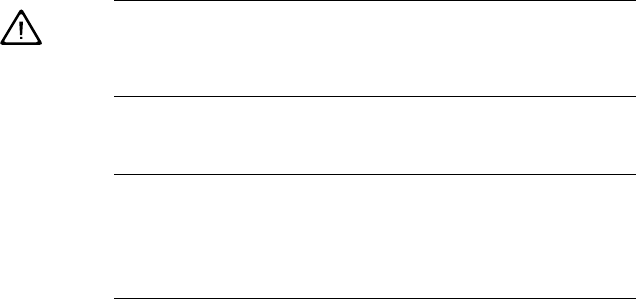
Introduction
20
Electromagnetic interference
The meter fulfills the IEC 61326-2-6 requirements for emitted interference and interference
immunity.
Touchscreen
Local Area Network: protection from unauthorized access
If this product is connected to a local area network, this network must be protected against
unauthorized access. In particular, it must not be linked directly to any other network or the Inter-
net. Customers are responsible for the security of their local area network, especially in protect-
ing it against malicious software and attacks. This protection might include measures, such as a
firewall, to separate the device from uncontrolled networks as well as measures that ensure that
the connected network is free of malicious code.
Do not use the meter near strong electromagnetic fields, which could
interfere with the proper operation of the meter.
Electrostatic discharges may cause malfunction of the meter.
NOTICE ■Use only your finger (even when wearing gloves) or special pens
designed for use with handheld devices to touch the screen elements.
Using pointed or sharp-edged objects can damage the touchscreen.
■Do not use the system in direct sunlight. Direct sunlight may reduce
the life expectancy and functionality of the screen.

Introduction
21
Wired network connection
If connected to a local area network, the cobas h 232 Handheld Base Unit must be protected
against unauthorized access by means of a strong password management. Observe your own
facility guidelines on password management where available, or apply the following rules:
Characteristics of strong passwords
■Passwords must not contain the user’s account name or parts of the user’s full name that
exceed two consecutive characters.
■Passwords must be at least eight characters in length.
■Passwords must contain characters from at least three of the following four categories:
– English uppercase alphabetic characters (A through Z)
– English lowercase alphabetic characters (a through z)
–Numeric characters (0 through 9)
–Non-alphabetic characters (for example, !, $, #, %)
Examples of weak passwords
■uhxwze11 contains no upper case letter.
■UHXW13SF contains no lower case letter.
■uxxxxx7F contains the same character more than four times.
■x12useridF contains a substring of the user ID longer than four characters.
To ensure that your cobas h 232 meter functions properly, observe the operating and storage
conditions as given in the chapter “General Product Specifications”, starting on page 177.

Introduction
22
Wireless connectivity
If the meter is equipped with WLAN functionality:
Wireless connectivity allows the meter to send data (test results, patient IDs, operator IDs, etc.) to
the data management system without the need to return the meter to the Handheld Base Unit.
This feature must be configured by the system administrator. Observe the guidelines of your
facility for using wireless local area network connections. For a description of the cobas h 232
meter’s ability to connect to Wireless Local Area Networks (WLAN, Wi-Fi), see appendix B.
Radiofrequency radiation exposure information
The Industrial, Scientific and Medical (ISM) radio frequencies may contain emissions from micro-
wave ovens, heaters, and other noncommunication devices. While these types of devices usually
pose no threat of interference as they are low-powered devices, the possibility exists that some
industrial high power systems may wipe out any attempted communication use of a WLAN.
Therefore, perform a site survey and interference analysis with a spectrum analyzer to view the
entire spectrum, looking for signals that might not only be within the frequency range of the
intended WLAN but also could be near or at the same frequency and cause interference.
Roche Diagnostics supports industry wireless standards and recommends using
products that have Wi-Fi certification. This certification tests products to the 802.11
industry standards for basic connectivity, security, authentication, Quality of
Service (QoS), interoperability and reliability. The Wi-Fi CERTIFIED logo is an assurance that the
Wi-Fi Alliance has tested a product in numerous configurations and with a diverse sampling of
other devices to ensure compatibility with other Wi-Fi CERTIFIED equipment that operates in the
same frequency band. The Wi-Fi Alliance network of independent test labs conducts inter-
operability testing programs to ensure that wireless devices work together and support secure
connections.
Glossary:
■“FCC” stands for “Federal Communications Commission” (USA).
■“RF” stands for “radio frequency”
■“RSS” stands for “Radio Standards Specification” (Canada).
■“WLAN” stands for “Wireless Local Area Network”
Introduction
23
The cobas h 232 system complies with FCC radiation exposure limits set forth for an uncon-
trolled environment. This equipment should be installed and operated with minimum distance of
20 cm (8 inches) between the radiator and your body.
This transmitter must not be co-located or operated in conjunction with any other antenna or
transmitter.
Changes or modifications made to this equipment not expressly approved by Roche Diagnostics
may void the FCC authorization to operate this equipment.
This device complies with Part 15 of the FCC Rules and with RSS-210 of Industry Canada.
Operation is subject to the following two conditions:
(1) this device may not cause harmful interference,
and
(2) this device must accept any interference received, including interference that may cause
undesired operation.
The cobas h 232 system complies with the emission and immunity requirements described in
EN 61326-2-6. It has been designed and tested to CISPR 11 Class B.
This equipment has been tested and found to comply with the limits for a Class B digital device,
pursuant to Part 15 of the FCC Rules. These limits are designed to provide reasonable protection
against harmful interference in a residential installation. This equipment generates, uses and can
radiate radio frequency energy and, if not installed and used in accordance with the instructions,
may cause harmful interference to radio communications. However, there is no guarantee that
interference will not occur in a particular installation. If this equipment does cause harmful inter-
ference to radio or television reception, which can be determined by powering the equipment off
and on, the user is encouraged to try to correct the interference by one or more of the following
measures:
■Reorient or relocate the receiving antenna.
■Increase the separation between the equipment and receiver.
■Connect the equipment into an outlet on a circuit different from that to which the receiver
is connected.
■Consult the dealer or an experienced radio/TV technician for help.
This Class B digital apparatus complies with Canadian ICES-003.
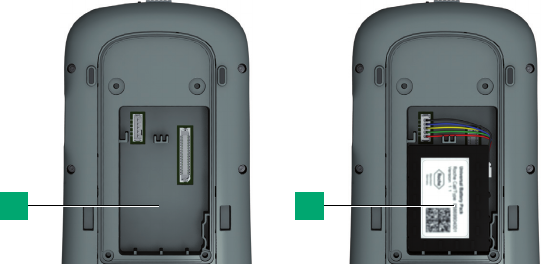
Introduction
25
ATouchscreen
Shows results, information, icons and
results saved in the memory. To select an
option, simply touch the button lightly.
BOn/Off button
Press this button to power the meter on or
off.
COpening for sample application
Opening in the test strip guide cover that
enables you to apply blood once the test
strip is inserted.
DTest strip guide cover
Remove this cover to clean the area
underneath (if it has become soiled, e.g.,
with blood).
EBarcode scanner (LED)
Operator and patient IDs can be read into
the meter using the integrated barcode
scanner (only meter versions with a serial
number greater than 200 000).
FBattery compartment cover
Remove to insert the battery pack.
GMeter identification plate
See page 5 for symbol explanation.
HWireless LAN label
If the meter supports wireless connectiv-
ity: This label displays registration num-
bers that are specific to the meter RF
hardware.
H N
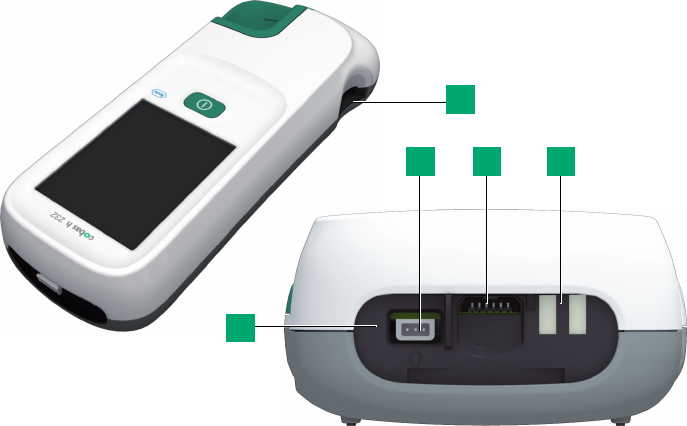
Introduction
26
ITest strip guide
Insert the test strip here.
JInfrared (IR) window
Supports data communication with the
(optional) Handheld Base Unit. Covered
by the semi-transparent rear panel.
KConnection socket for power adapter
Plug in the power adapter here.
LCode chip slot
Insert the code chip here.
MCharging terminals
Used for power supply and/or charging
the battery pack when the meter is
docked in the (optional) Handheld Base
Unit.
I
J
K L M

Introduction
27
Power supply
The meter can be operated with the rechargeable battery pack only or together with the power
adapter or the (optional) Handheld Base Unit, which both charge the battery pack when inserted.
Insert the battery pack even when always using the power adapter or the Handheld Base Unit.
This ensures that you will not lose the date and time settings if the power goes out. Results are
retained in the memory together with the corresponding date and time, as well as all other set-
tings, even when no battery pack is inserted.
To save power, the meter can automatically power itself off after a programmable period of time,
if no buttons are pressed or new test strips are inserted. When the meter powers itself off, all test
results obtained up to that point remain in memory and the settings are retained (see “Auto off”
in the chapter entitled “Data Handling setup” on page 62).
NBattery Pack
Powers the device.
OPower adapter
Powers the device and charges the
battery pack.
N O
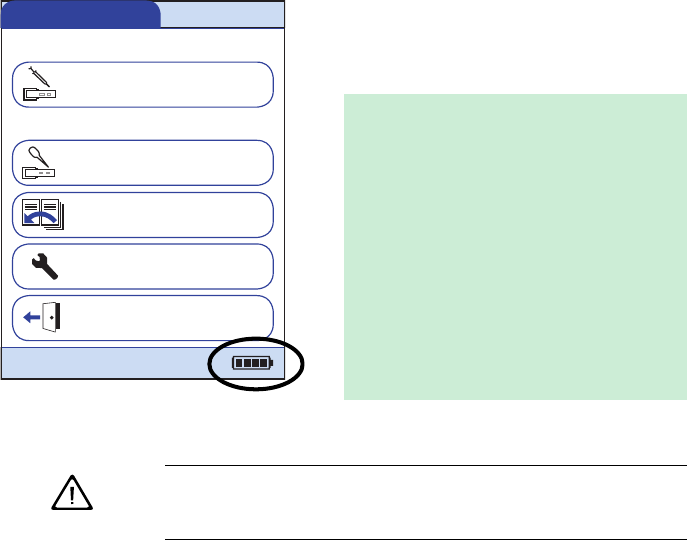
Introduction
28
During battery operation, the meter always
displays the power level of the battery pack.
The battery icon is divided into four segments
which correspond to the battery power level.
When replacing the battery pack, insert the
new battery pack within 24 hours of removing
the old one. Otherwise you may need to re-
enter date and time.
Dispose of used battery packs in an environmentally responsible manner
in accordance with applicable local regulations and directives. See
“Infection by a potentially biohazardous instrument” on page 17.
Main Menu
Control Test
Review Results
Setup
Patient Test
09:15 am
04/19/2015
Logout
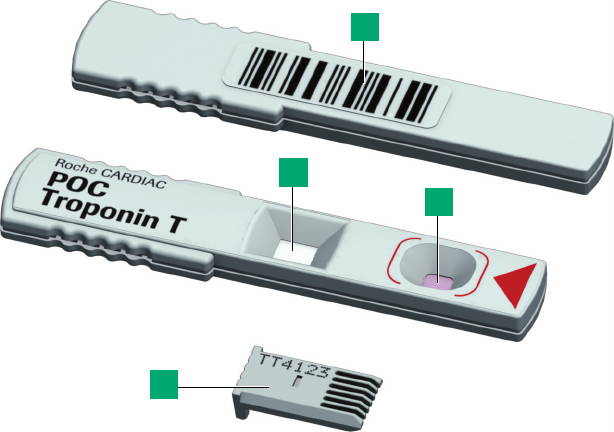
Introduction
29
Test strip
PTest area
This area is evaluated by the meter via the
camera.
QSample application area
The sample is applied to this area after
inserting the test strip in the meter.
RBarcode
Assigns the strip to the corresponding
code chip. The barcode is automatically
read by the meter when the strip is
inserted into the test strip guide.
SCode chip
Contains strip lot specific data.
P
Q
S
R
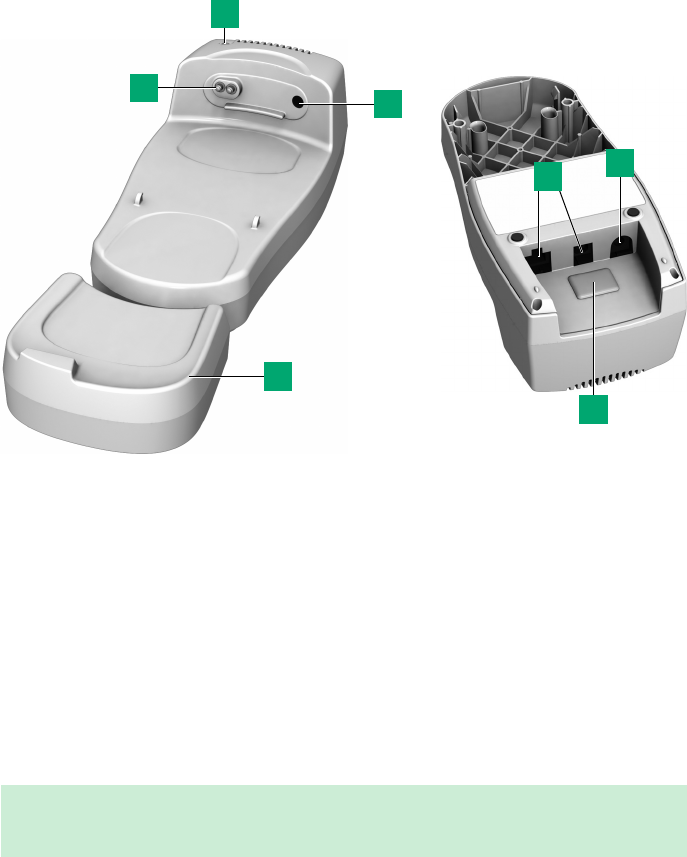
Introduction
30
Handheld Base Unit
TCharging contacts
Used for power supply and/or charging
the battery pack.
UStatus indicator
Lights up when power is connected,
charge indicator.
VInfrared (IR) window
For communication with the meter.
WExtension piece
For cobas h 232 meter.
XData ports (Ethernet/RJ45 and USB)
For connecting the device to a Data
Management System (DMS).
YConnection socket for the
power adapter
Here you can plug in the power adapter of
the Handheld Base Unit.
ZRemovable cover for configuration
switch
The switch sets the mode of operation for
the Handheld Base Unit.
The Handheld Base Unit can be ordered separately. For detailed information on usage and
configuration please consult the operator's manual of the Handheld Base Unit and the
Technical Note stored on the Handheld Base Unit itself.
T
U
V
Y
Z
W
X

Introduction
31
1.3 Overview of the Buttons and Icons used on Screen
The buttons and icons that appear during normal operation are shown here, along with a general
explanation. Error messages and the description of the icons linked to them are provided in a
separate chapter. See “Troubleshooting” starting on page 173.
Button/Icon Meaning
OK, save setting
Cancel, discard setting
Return (to previous menu)
Decrease/increase a numeric value or
Scroll through lists that are too long to be displayed at once
Inactive button; value cannot be further decreased/increased or
End of list in this direction is reached
Return to the Main Menu screen
List of tests of an individual patient
Scroll through stored results
Print displayed result (via infrared interface to corresponding printer)
Display test result as QR code
Add a comment
Operator logout
Operator login
Operator must wait until the meter has completed an action.
Insert test strip
Remove test strip
Test strip warming up
Apply sample (the time left to apply sample is counted down in the
screen alongside the required sample amount)
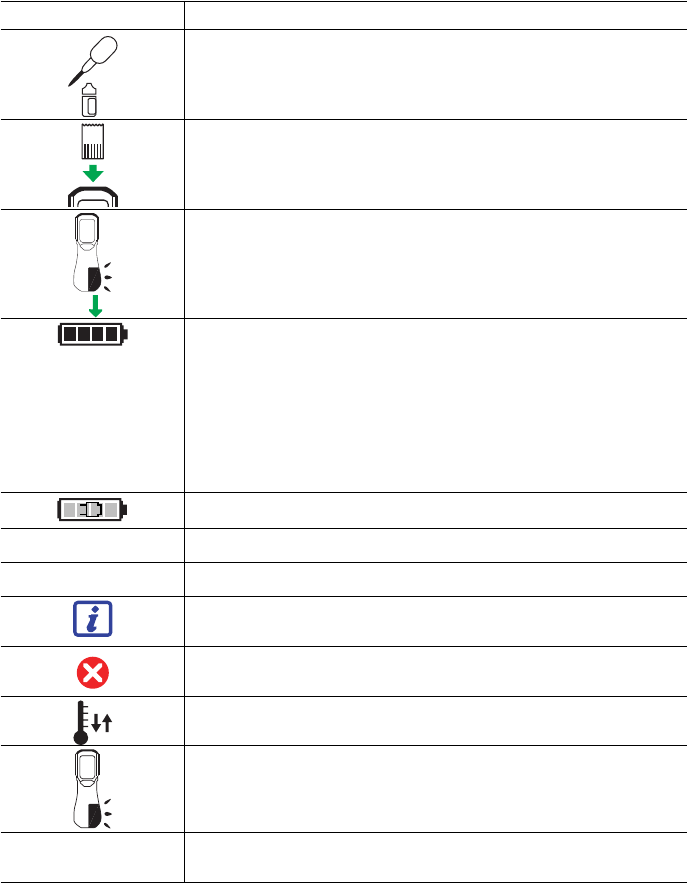
Introduction
32
Apply QC sample (the time left to apply sample is counted down in the
screen alongside the required sample amount)
Insert code chip
Open test strip guide cover for cleaning
Battery status:
• If the battery pack still has its full charge, all segments are lit
• Individual segments disappear one by one as the battery pack
becomes weaker
• When there is no segment remaining, you can no longer perform
a test. You can, however, still access the meter’s memory
Operation with power adapter
Time between midnight and noon (in 12-hour time format)
Time between noon and midnight (in 12-hour time format)
Marks an information message
Marks an error message or a warning
(see Chapter 9 “Troubleshooting”)
Room or meter temperature is outside the acceptable range.
The test strip guide cover is open.
In a QC lockout condition, this icon indicates that one or more
parameters are locked, while others still can be measured.
Button/Icon Meaning
QC
am
pm
QC!

Introduction
33
The following icons may appear when using the meter in conjunction with a data management
system (DMS).
Infrared interface is enabled (for communication with the computer
and/or printer)
Communication is taking place via WLAN
An OTS request is pending
Cleaning/Disinfection necessary
Introduction
34
This page intentionally left blank.

Putting the Meter into Operation
35
2 Putting the Meter into Operation
Before using the meter for the first time, perform the following steps:
1 Install the battery pack (see page 38)
2 Connect the power adapter to charge the battery pack
3 Set the current date and time as well as the appropriate display format (see Chapter “Meter
Setup” starting on page 43)
4 Enter the settings of choice (language, quality controls – where necessary, user
administration, etc.)
If the meter has no date/time settings (either because you are powering on the meter for
the first time or because the battery pack was removed from the meter for more than 24
hours), you cannot perform a test. In that case powering on the meter takes you immediately
to the Setup mode, where you must set the date and time.

Putting the Meter into Operation
36
2.1 Installing or replacing the battery pack
When shipped, the battery pack is not installed in the meter.
Unused battery packs lose their charge over time and have to be recharged before they can
be used. After installing a new battery pack, the meter should be charged overnight before
testing. Please note that the battery pack will only reach full capacity once it has been fully
emptied and charged several times.
Whenever the meter is placed on an active Handheld Base Unit or powered by the power
adapter, the icon is displayed. This icon shows that power is available and the meter
can be charged if necessary.
Make sure that the permitted temperature range for charging the battery pack (12-32 °C or
54-90 °F) is maintained during installation and initial setup.
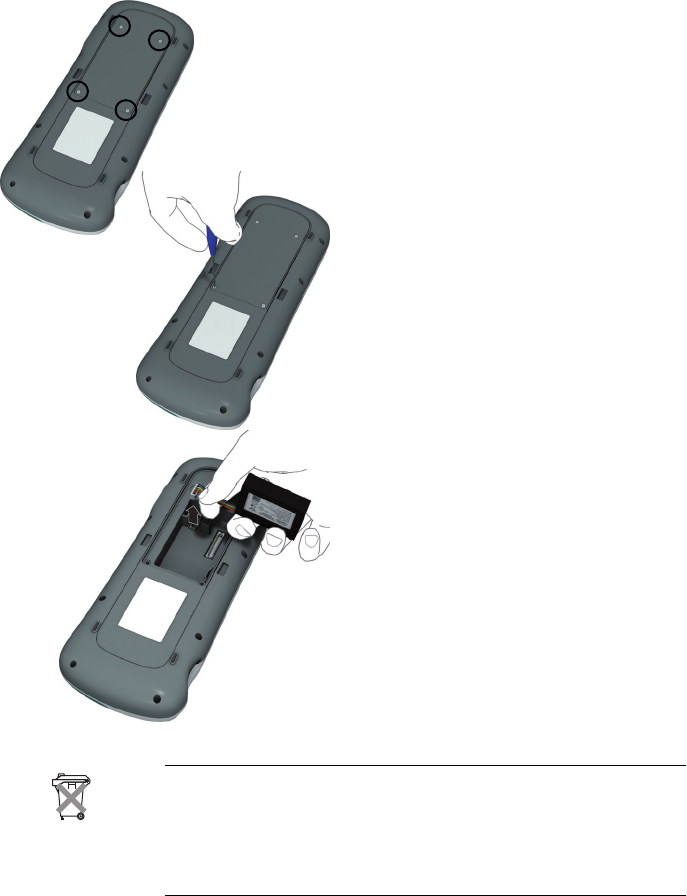
Putting the Meter into Operation
37
Removing the battery pack
1If a battery pack is already installed, make
sure that the meter is powered off.
2Place the meter face down on a level sur-
face.
3Using a an appropriate starshaped screw-
driver, e.g. Torx® size T5, remove the four
screws holding the battery compartment
cover in place.
4Remove the battery compartment cover
from the meter. The battery pack now vis-
ible is connected to the meter by a plug.
5Carefully lift the battery pack and remove
the plug connector.
Disposal of used battery packs
Do not dispose of the battery pack with normal domestic waste. Dispose
of used battery packs in accordance with applicable local regulations and
directives and your facility’s guidelines on the disposal of electronic waste
equipment.
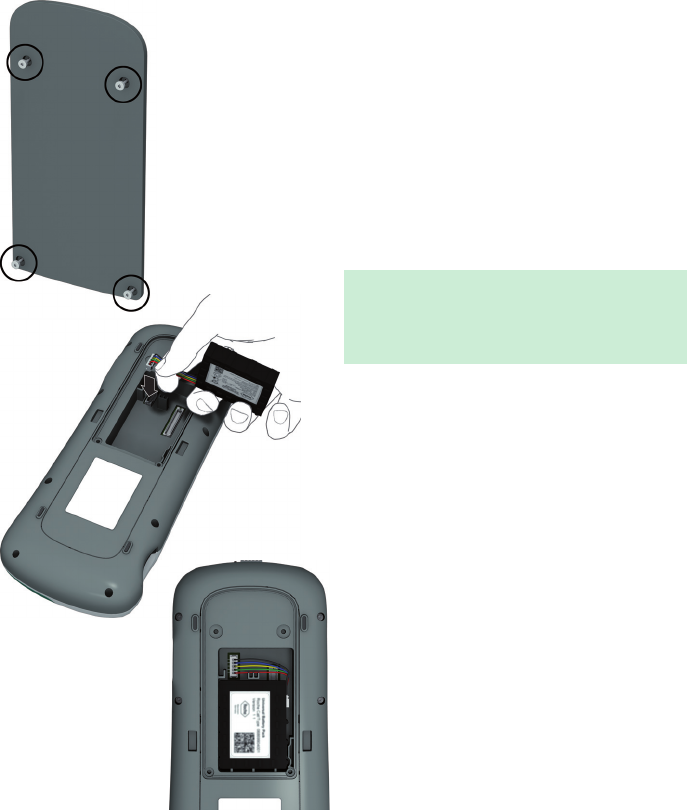
Putting the Meter into Operation
38
Installing the battery pack
1Loosen the screws on the battery com-
partment cover until they are protruding
about 4-5 mm (2/10 in).
2Hold the battery pack in your hand, with
the wires and the plug pinched between
your thumb and index finger.
3Plug the connector plug into the socket
and make sure it is fully inserted.
4Place the battery pack inside the battery
compartment as shown.
To position the battery pack correctly, always
align the ridges on the side of the battery pack
with the ridges on the inside of the battery
compartment.
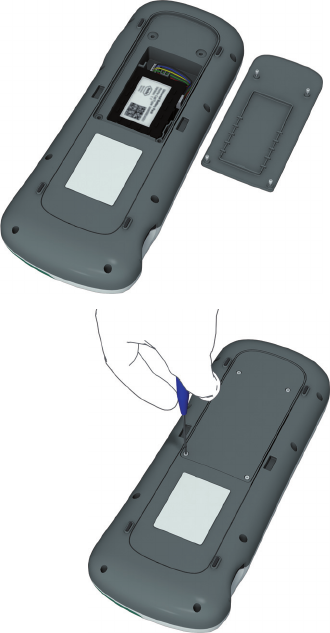
Putting the Meter into Operation
39
5Place the cover on the battery compart-
ment. Make sure that the plug connector
wires do not get pinched between meter
and cover.
6Tighten all four screws until snug (do not
overtighten).
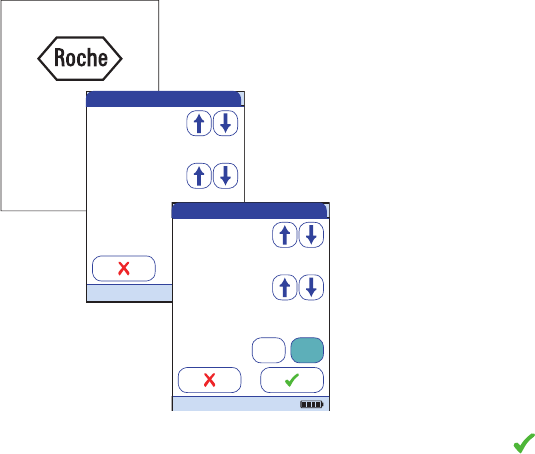
Putting the Meter into Operation
40
After inserting a new battery pack, the meter powers on automatically.
After installing a new battery pack, the meter should be charged overnight before testing.
■The Roche logo is displayed. If the meter
does not power on automatically, the bat-
tery pack may be empty. Connect the
power adapter for a minimum of 30 min-
utes, then remove the plug and try to
power the meter on. If it powers on, the
battery pack is charging properly.
■Within a short period of time, the start
screen should appear.
■If the meter has been without power for
too long, it will show the date and time
settings dialog and you have to re-enter
the date and time settings.
■The screens for entering the date and the
time appear.
7Enter the date and time. After you have
entered the correct information, confirm
each screen with .
Set Date
Month: 1
Day: 1
Year: 2015
04/19/2015 Minutes: 49
Hour: 3
Set Time
04/19/2015
AM PM
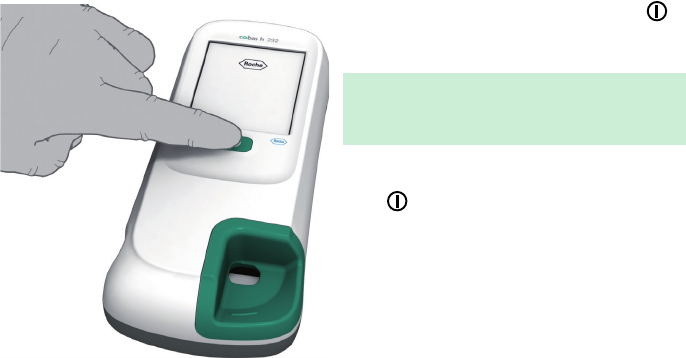
Putting the Meter into Operation
41
Powering the meter on and off
1Power the meter on by pressing the
button for approximately 1 second.
You can also power on the meter directly by
connecting the power adapter or by placing
the meter on the Handheld Base Unit.
2To power the meter off after use, press the
button for approximately 1 second.
Putting the Meter into Operation
42
This page intentionally left blank.
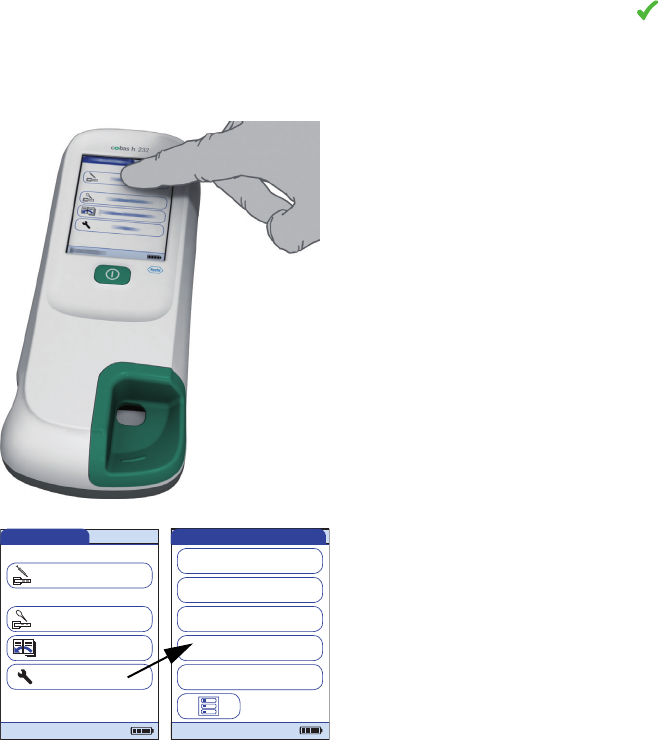
Meter Setup
43
3 Meter Setup
Buttons are screen prompts that cause something to happen when touched. In this manual the
names of all buttons are either shown as bold text or as the icon used on the button (e.g., for
OK ).
When text refers to other screen elements (e.g., Menu titles), these are written in italics. These
screen elements are not active.
You can open any displayed function by
touching (or tapping) the button for it with
your finger (or a special pen for this purpose).
“Tap” means: Touch the button, then remove
your finger from the touchscreen. The next
screen appears once you remove your finger.
1Touch Setup to call up the Setup menu.
2Select the group of settings of choice
(see the Settings summary following this
section).
For a description of the buttons and icons
used on screen see page 31.
Data Handling
ID Setup
Lockout
Basics
Optional Screens
Setup
04/19/2015
Main Menu
Control Test
Review Results
Setup
Patient Test
04/19/2015
09:15 am
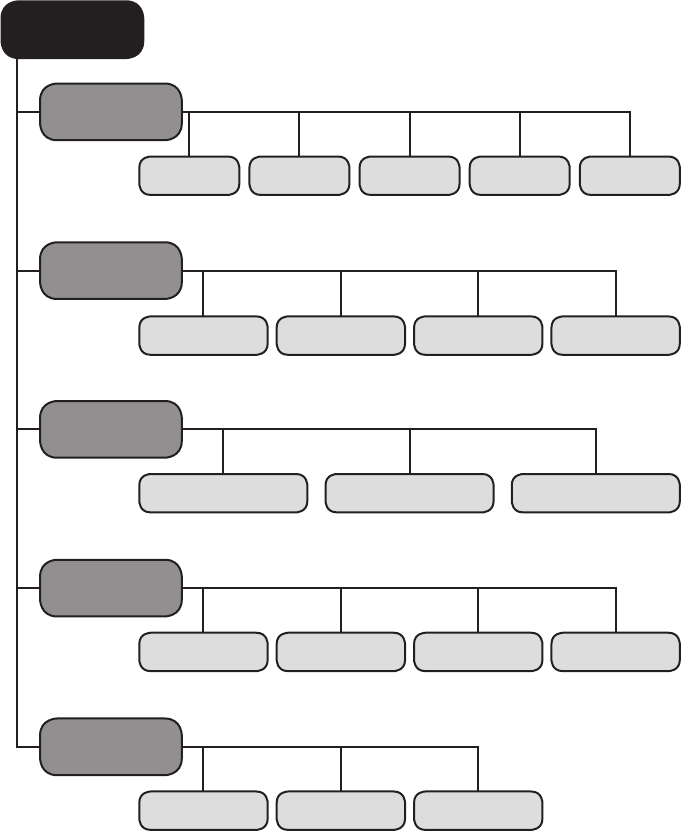
Meter Setup
44
Settings summary
The diagram below gives an overview of the setup areas that can be accessed on the meter.
Setup
Data
Handling
ID Setup
Basics
LanguageContrast
Connection
Administrator ID
Operator
Lockout
Start Info
Date/Time
QC Settings
Result Login
Sound
Operator ID
Cleaning
Lockout
Result
Confi rmation
Auto Off
Result Memory
Patient ID
STAT Test Confi g.
Lockout
Optional
Screens
Result Display
Mode
DD Result Unit
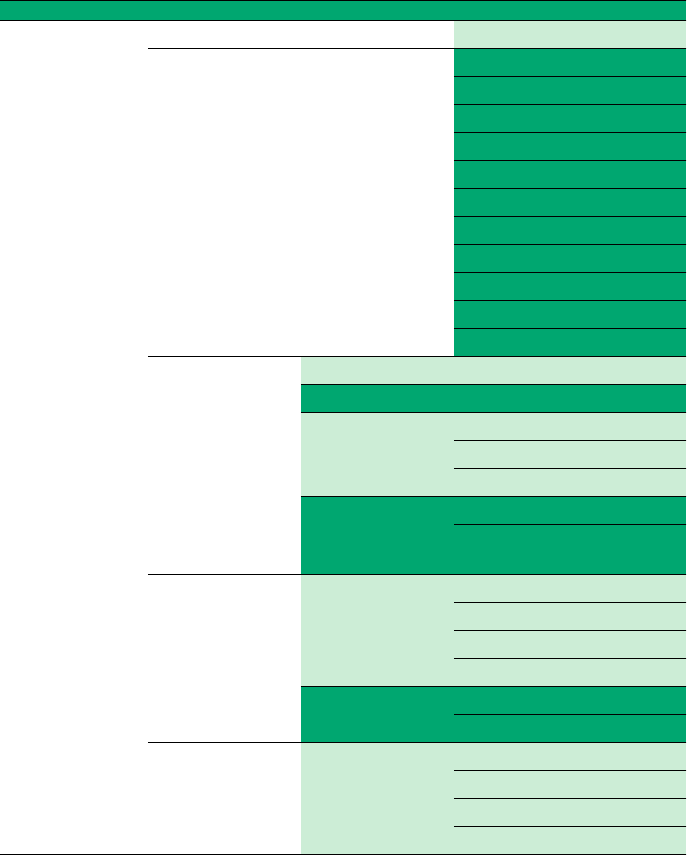
Meter Setup
45
* Default settings are labelled with an asterisk (*).
Group
Subgroup Setting
Values
*
Basics Contrast 0 – 10 (5*)
Language Dansk
Deutsch
English *
Español
Français
Italiano
Nederlands
Norsk
Português
Svenska
An installable language
Date/Time Date 01/01/2011 *
Time 12:00 am *
Date formats Day.Month.Year (31.12.2011)
Month/Day/Year (12/31/2011) *
Year-Month-Day (2011-12-31)
Time formats 24-hour time format (24H)
12-hour time format (12H),
with am/pm *
Sound (Beeper) Volume Off
Low
Medium *
High
Key Click Enable
Disable *
Auto Off [minutes] Off
1 … 10 (default: 5 min *)
15, 20, 25, 30
40, 50, 60
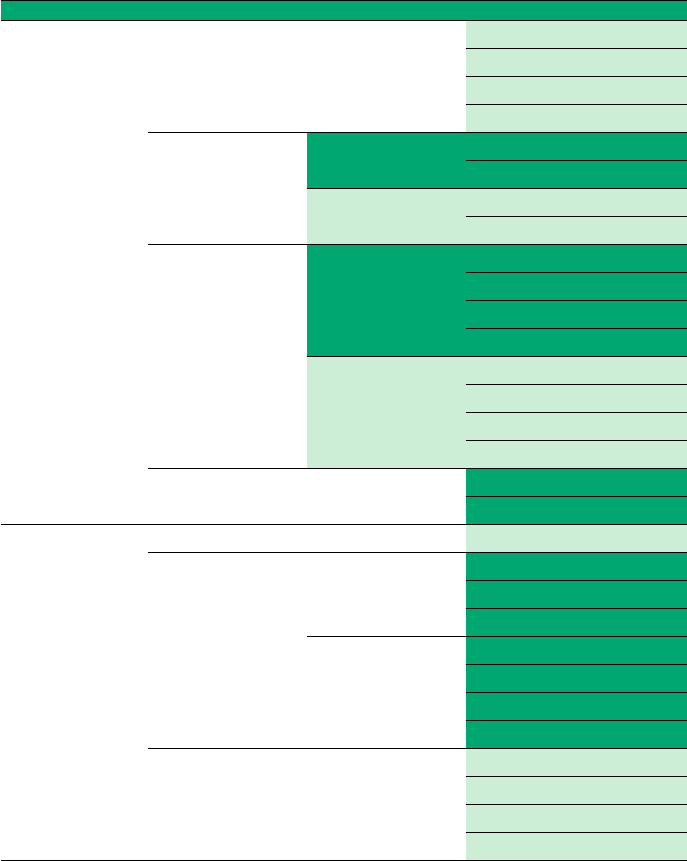
Meter Setup
46
* Default settings are labelled with an asterisk (*).
Group
Subgroup Setting
Values
*
Data Handling Connection QR Code
Off *
Computer
Printer
Result Memory Result Display Filter All results *
Current Op. Res.
Result Storage
Mode
No results deletion *
Delete oldest result
Result Unit Select DD Res. Unit g/mL *
ng/mL
mg/L
g/L
Select TT Res. Unit ng/L *
pg/mL
ng/mL
g/L
Result Display Mode Static *
Flashing
ID Setup Administrator ID Blank (off) *
Operator ID (with DMS and list
available on meter)
None *
List
Hidden List
(No list available on
meter)
None *
Optional
Required
Scan Only
Patient ID None
Optional *
Required
Hidden List
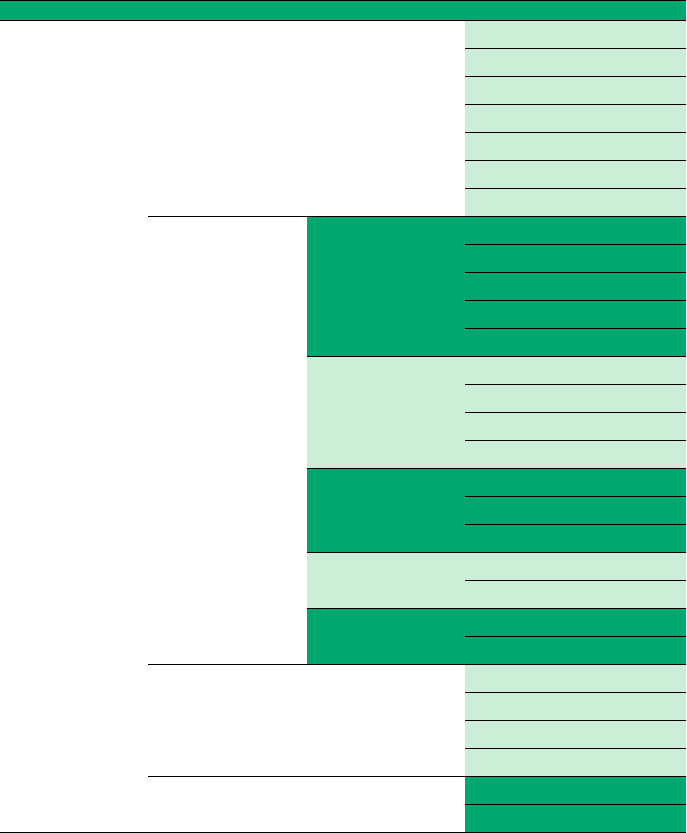
Meter Setup
47
* Default settings are labelled with an asterisk (*).
Group
Subgroup Setting
Values
*
Lockout Operator Lockout (only if “Operator ID”
option is enabled)
No *
Daily
Weekly
Monthly
Every 3 months
Every 6 months
Yearly
QC Settings QC Lockout New Lot: Yes/No *
No *
Daily
Weekly
Monthly
IQC Lockout No *
Daily
Weekly
Monthly
QC Result Format Pass/Fail *
Value
Value & Pass/Fail
Custom Range
Trop T
Default Range*
Custom Range
Reset Test Param. Do Reset
No Reset *
Cleaning Lockout No *
Daily
Weekly
Monthly
STAT Test Config. Enable
Disable *

Meter Setup
48
* Default settings are labelled with an asterisk (*).
Group
Subgroup Setting
Values
*
Optional screens Start Info Enable
Disable *
Result Login Enable
Disable *
Result Confirmation Enable
Disable *
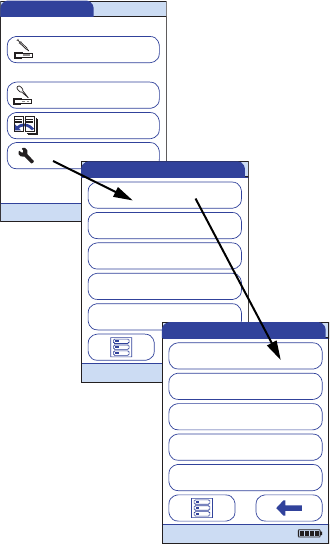
Meter Setup
49
3.1 Basics setup
The Basics setup area contains the basic options for changing the user interface.
Contrast
Use the Contrast menu to adjust the display to your ambient light conditions and make it easier
to read.
1From the Main Menu, touch Setup to
open the meter settings.
2From the Setup menu, touch Basics.
3From the Setup-Basics menu, touch
Contrast.
Main Menu
Control Test
Review Results
Setup
Patient Test
04/19/2015
09:15 am
Data Handling
ID Setup
Lockout
Basics
Optional Screens
Setup
04/19/2015
Language
Date/Time
Sound
Contrast
Auto Off
Setup - Basics
04/19/2015
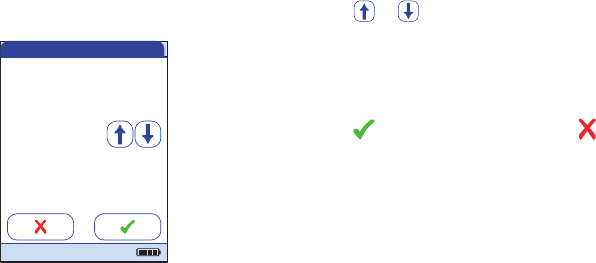
Meter Setup
50
4Touch or to change the contrast in
a range from 0 to 10.
■Contrast “0” makes the screen very dark.
■Contrast “10” makes the screen very light.
5Touch to save this setting, or touch
to exit this menu without saving any
changes. The display automatically
returns to the previous screen.
Select Contrast
Contrast:
(0-10) 5
04/19/2015
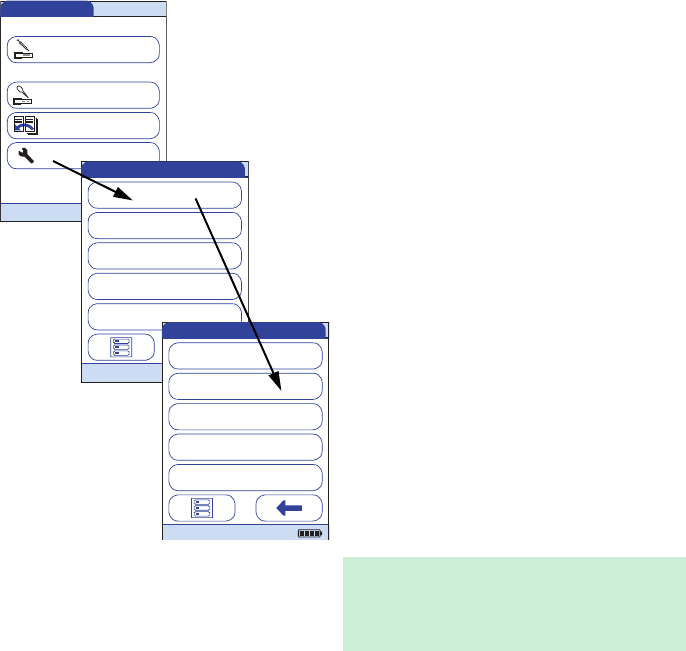
Meter Setup
51
Language
Use this setting to select the language for all displays (that contain text).
1From the Main Menu, touch Setup to
open the meter settings.
2From the Setup menu, touch Basics.
3From the Setup-Basics menu, touch
Language.
The current language setting is highlighted
(white type on a blue background). You can
select either:
■Dansk
■Deutsch
■English
■Español
■Français
■Italiano
■Nederlands
■Norsk
■Português
■Svenska
An optional language can be installed upon
request (either directly at the plant or later by
an authorised Roche Diagnostics service
technician).
Main Menu
Control Test
Review Results
Setup
Patient Test
04/19/2015
09:15 am
Data Handling
ID Setup
Lockout
Basics
Optional Screens
Setup
04/19/2015
Language
Date/Time
Sound
Contrast
Auto Off
Setup - Basics
04/19/2015
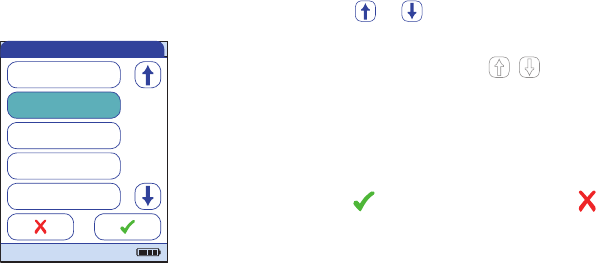
Meter Setup
52
4Touch or to display the language
of choice on the screen.
If the arrow is just an outline , you
have reached the end of the list in the respec-
tive direction.
5Touch the button to select the language of
choice. Your selection is now highlighted.
6Touch to save this setting, or touch
to exit this menu without saving any
changes. The display automatically
returns to the previous screen.
Français
Italiano
Nederlands
Norsk
Português
Select Language
04/19/2015
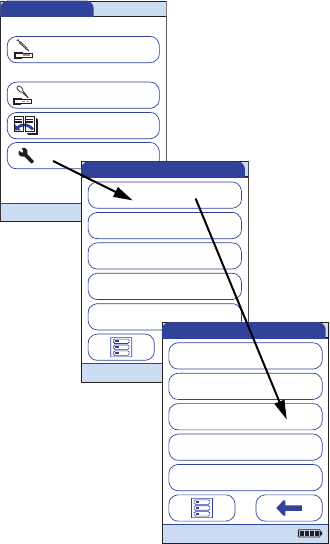
Meter Setup
53
Setting the date
Use this menu to set the date of the meter.
1From the Main Menu, touch Setup to
open the meter settings.
2From the Setup menu, touch Basics.
3From the Setup-Basics menu, touch
Date/Time.
Main Menu
Control Test
Review Results
Setup
Patient Test
04/19/2015
09:15 am
Data Handling
ID Setup
Lockout
Basics
Optional Screens
Setup
04/19/2015
Language
Date/Time
Sound
Contrast
Auto Off
Setup - Basics
04/19/2015
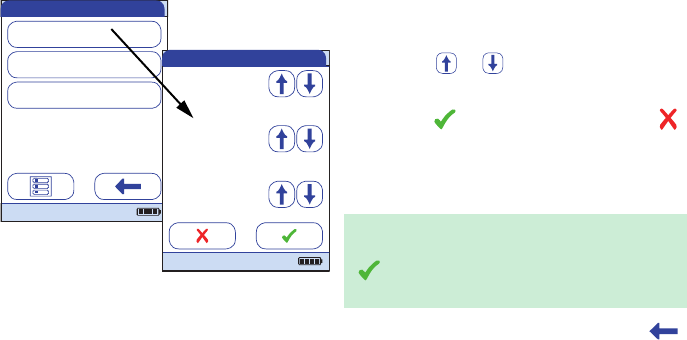
Meter Setup
54
4From the Setup-Date/Time menu, touch
Date to set the date.
5Touch or to set the year, then the
month, then the day.
6Touch to save this setting, or touch
to exit this menu without saving any
changes. The display automatically
returns to the previous screen.
If the Set Date menu appeared automatically
after powering the meter on, you must touch
to complete the date setting. The Set Time
menu will then be displayed next.
7In the Setup-Date/Time menu, touch
to return to the Setup-Basics menu or
touch Time to move to the time setting.
Setup - Date/Time
Time
Date/Time Format
Date
04/19/2014
Set Date
Month:
1
Day:
1
Year:
2015
04/19/2015
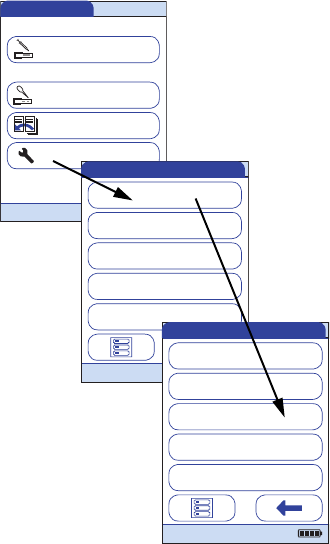
Meter Setup
55
Setting the time
Use this menu to set the time of the meter.
1From the Main Menu, touch Setup to
open the meter settings.
2From the Setup menu, touch Basics.
3From the Setup-Basics menu, touch
Date/Time.
Main Menu
Control Test
Review Results
Setup
Patient Test
04/19/2015
09:15 am
Data Handling
ID Setup
Lockout
Basics
Optional Screens
Setup
04/19/2015
Language
Date/Time
Sound
Contrast
Auto Off
Setup - Basics
04/19/2015
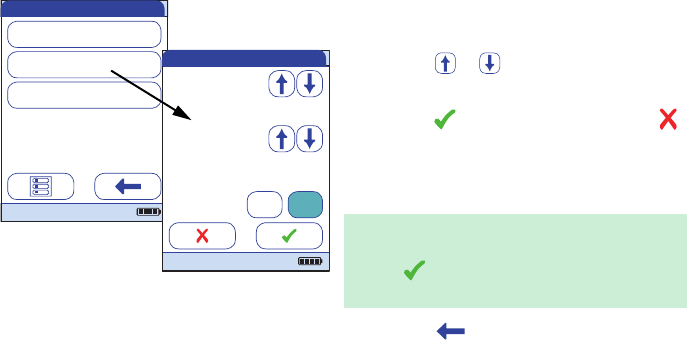
Meter Setup
56
4From the Date/Time menu, touch Time to
set the time.
5Touch or to set the hours, then the
minutes.
6Touch to save this setting, or touch
to exit this menu without saving any
changes. The display automatically
returns to the previous screen.
If the Set Time menu appeared automatically
after leaving the Set Date menu, you must
touch to complete the time setting. The
Main Menu will then be displayed next.
7Touch to return to the Setup-Basics
menu or touch Date/Time Format to
move to the display options.
Setup - Date/Time
Time
Date/Time Format
Date
04/19/2014
Minutes: 49
Hour: 3
Set Time
04/19/2015
AM PM
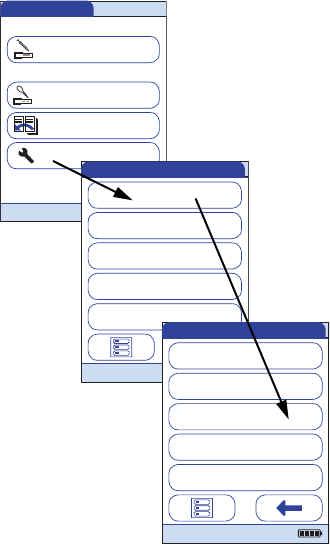
Meter Setup
57
Setting the display options for date and time
Select your preferred format for the date and time display.
1From the Main Menu, touch Setup to
open the meter settings.
2From the Setup menu, touch Basics.
3From the Setup-Basics menu, touch
Date/Time.
Main Menu
Control Test
Review Results
Setup
Patient Test
04/19/2015
09:15 am
Data Handling
ID Setup
Lockout
Basics
Optional Screens
Setup
04/19/2015
Language
Date/Time
Sound
Contrast
Auto Off
Setup - Basics
04/19/2015
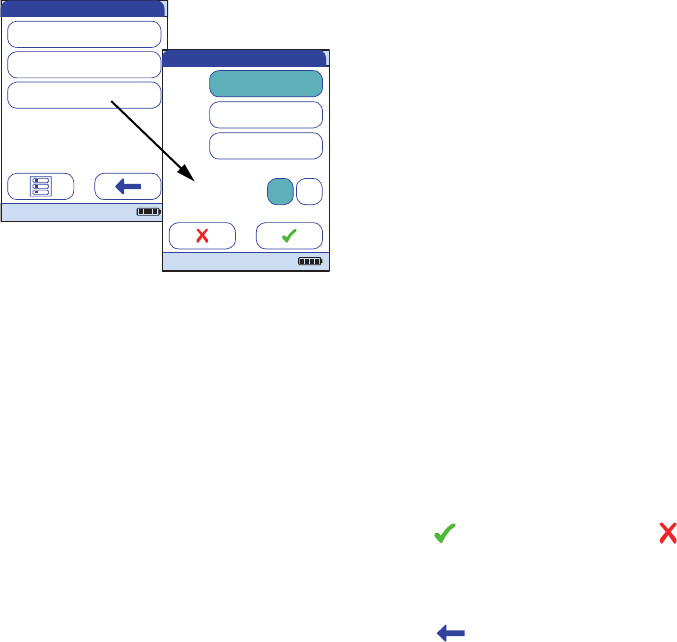
Meter Setup
58
4From the Setup-Date/Time menu screen,
touch Date/Time Format to set the dis-
play format.
The current settings are highlighted (white
type on a blue background). You can select
one of the following display formats for the
date:
■Day.Month.Year, e.g., 31.12.2011
■Month/Day/Year, e.g., 12/31/2011
■Year-Month-Day, e.g., 2011-12-31
You can also select one of the following dis-
play formats for the time:
■24H (24-hour time format), e.g., 14:52
■12H (12-hour time format, supplemented
by am/pm), e.g., 2:52 pm
5Touch the button with the display format
of choice for the date and time. Your
selection is now highlighted.
6Touch to save this setting, or touch
to exit this menu without saving any
changes. The display automatically
returns to the previous screen.
7Touch to return to the Setup-Basics
menu.
Setup - Date/Time
Time
Date/Time Format
Date
04/19/2014
Select Date Format
Date: DD.MM.YYYY
MM/DD/YYYY
YYYY-MM-DD
Time: 24H 12H
04/19/2015

Meter Setup
59
Sound
The cobas h 232 meter can display information visually and alert you to special circumstances
with a beep sound. When the Sound is activated, the meter beeps when:
■it is powered on
■it detects a test strip
■pre-heating of the test strip is complete and you need to apply a sample
■the test is completed and the results are displayed (a long beep)
■an error occurs (three short beeps)
■the power adapter is connected when the meter is on
■a barcode is scanned successfully (short beep)
■the barcode scanner is disabled (two short beeps)
■a positive test result can be expected, while the measurement still is in progress (a long
beep)
You can also activate a Key Click. When the Key Click is activated, the meter clicks briefly every
time a button is touched, facilitating the input of information.
We recommend that you keep the Sound (beeper) activated at all times.
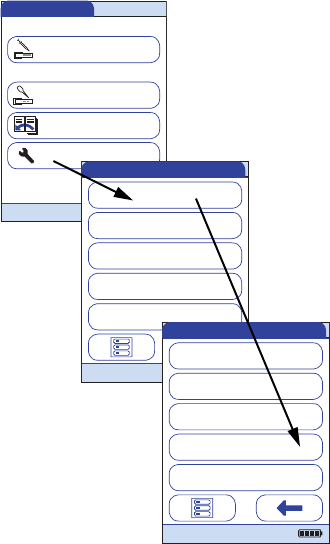
Meter Setup
60
1From the Main Menu, touch Setup to
open the meter settings.
2From the Setup menu, touch Basics.
3From the Setup-Basics menu, touch
Sound.
Main Menu
Control Test
Review Results
Setup
Patient Test
04/19/2015
09:15 am
Data Handling
ID Setup
Lockout
Basics
Optional Screens
Setup
04/19/2015
Language
Date/Time
Sound
Contrast
Auto Off
Setup - Basics
04/19/2015
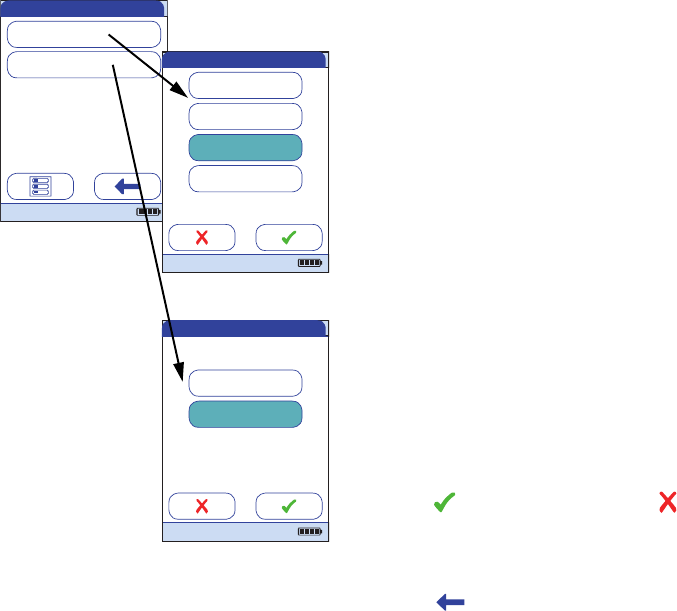
Meter Setup
61
4From the Setup-Sound menu, touch
Volume to set the volume level of the
beeper.
The current setting is highlighted (white type
on a blue background). You may select from
the following options:
■Off
■Low
■Medium
■High
5Touch Key Click in the Setup-Sound
menu to turn the key click on or off.
You may select from the following options:
■Enable
■Disable
6Touch to save this setting, or touch
to exit this menu without saving any
changes. The display automatically
returns to the previous screen.
7Touch to return to the Setup-Basics
menu.
Disable
Enable
Key Click
04/19/2015
Key Click
Volume
Setup - Sound
04/19/2015
Off
Low
Medium
High
Select Volume
04/19/2015
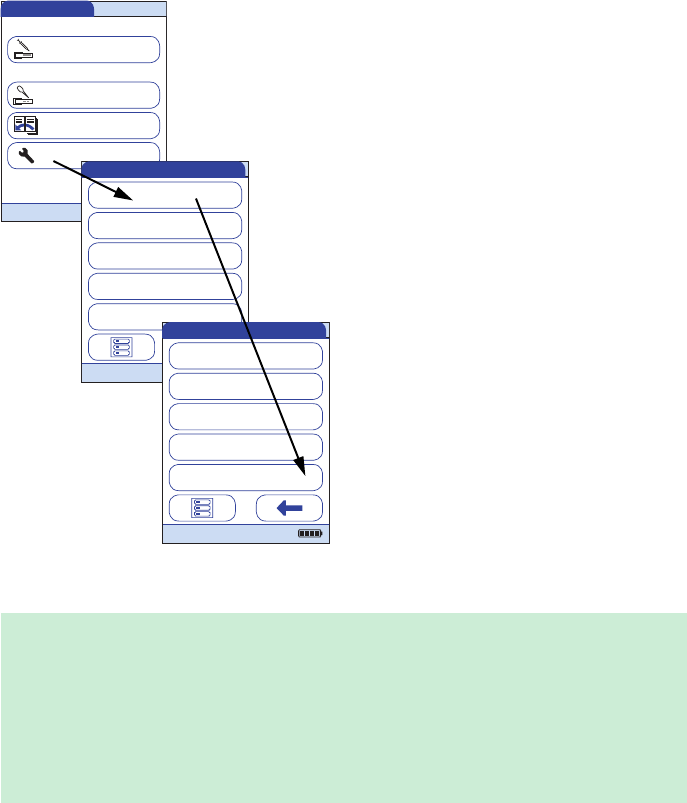
Meter Setup
62
Auto off
You can set up your meter so that it powers itself off automatically if it has not been used (no
buttons touched or tests run) for a preselected time period. Use this feature to save power and
extend the life of the batteries.
1From the Main Menu, touch Setup to
open the meter settings.
2From the Setup menu, touch Basics.
3In the Setup-Basics menu, touch Auto
Off.
If the meter is connected to the power adapter or the Handheld Base Unit, the Auto Off func-
tion has a different effect:
■If you do not work with operator IDs, the meter switches to the Main Menu, once Auto Off
is triggered.
■If you work with operator IDs, the meter switches to Operator Login, once Auto Off is
triggered.
For information on Operator ID, see “Operator ID” on page 89.
Main Menu
Control Test
Review Results
Setup
Patient Test
04/19/2015
09:15 am
Data Handling
ID Setup
Lockout
Basics
Optional Screens
Setup
04/19/2015
Language
Date/Time
Sound
Contrast
Auto Off
Setup - Basics
04/19/2015
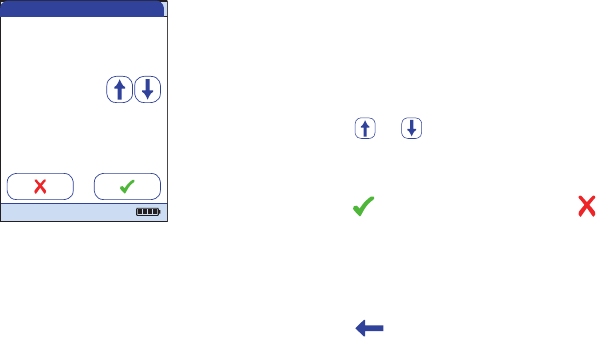
Meter Setup
63
You may select from the following options:
■Off (meter never powers itself off)
■Time until meter powers itself off:
1…10, 15, 20, 25, 30, 40, 50, 60 minutes
4Touch or to select the time of
choice in minutes or to deactivate the
feature.
5Touch to save this setting, or touch
to exit this menu without saving any
changes.
The display automatically returns to the
previous screen.
6Touch to return to the Setup menu.
Set Auto Off Time
Minutes: 5
04/19/2015
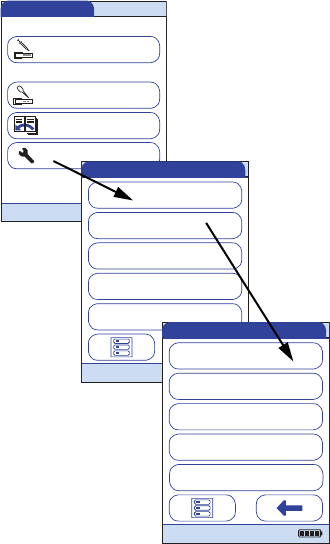
Meter Setup
64
3.2 Data Handling setup
Connection
In the Connection menu you can configure the data exchange with external devices. The meter
can be connected either to a computer or a printer. In addition to this direct data output, test
results may also be encoded as QR codes, which can be scanned to be used with other applica-
tions.
1From the Main Menu, touch Setup to
open the meter settings.
2From the Setup menu, touch Data
Handling.
3From the Setup-Data Handling menu,
touch Connection.
Main Menu
Control Test
Review Results
Setup
Patient Test
04/19/2015
09:15 am
Data Handling
ID Setup
Lockout
Basics
Optional Screens
Setup
04/19/2015
Result Memory
Result Units
Result Display Mode
Setup - Data Handling
Connection
04/19/2015
Diagnostics
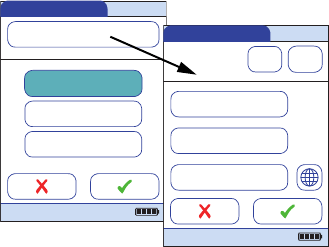
Meter Setup
65
QR Code
4From the Connection menu, touch QR
Code.
5Touch On to enable, or touch Off to disa-
ble QR code display. Your selection is now
highlighted.
■If you have enabled this feature, select the
style of the QR code to be displayed:
■Plain Text
Use this option to scan the result into a PC
hosted application (e.g. electronic medi-
cal record). In order to do so, you need an
external 2D barcode scanner attached to
your PC. Once scanned, the test result and
related meta-information (e.g. date, time,
comments) will appear as plain text in
your PC application.
■Coded Data
Use this option to scan the result into a
smartphone or tablet app, or a PC hosted
application.
■URL Transmission
Use this option to upload the result to a
web based service (e.g. such as an elec-
tronic health record, etc.). For this option
further parameters (URL, encryption key)
must be set.
Connection 09:15 am
04/19/2015
Printer
Computer
Off
QR Code QR Code 09:15 am
04/19/2015
Show QR code:
On Off
Plain Text
Coded Data
URL Transmission
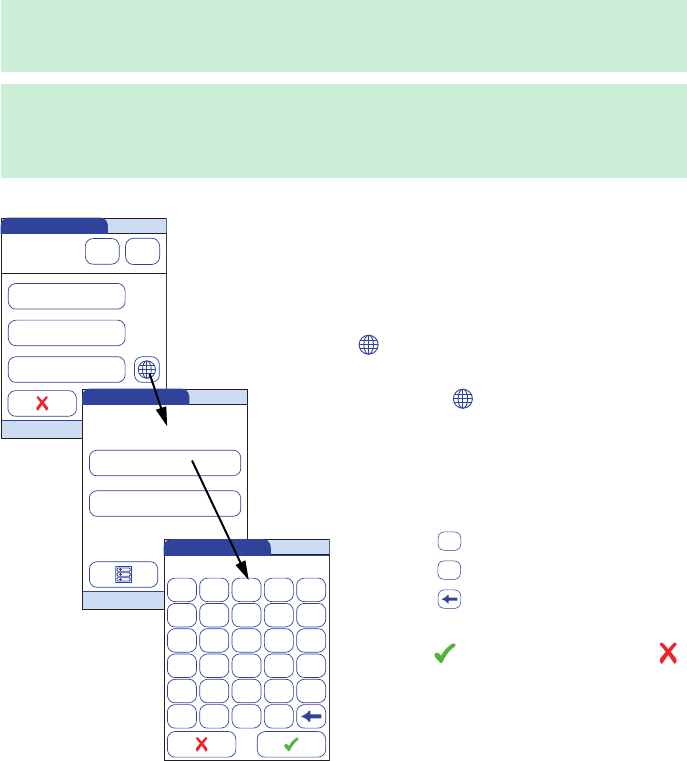
Meter Setup
66
Ensure that your environment for reading QR codes (QR code reader, operating system, text
processing application) is appropriate for your language. Disregard may lead to unpredictable
behavior of your receiving component (PC, mobile device).
For the options Coded Data and URL Transmission dedicated software programs or apps are
required in order to use this feature. If you are a customer or a 3rd party IT provider, and you
are interested to use this feature, contact your local Roche Diagnostics representative for
additional information.
6Touch Plain Text, Coded Data or
URL Transmission, depending on the
intended use. Your selection is now
highlighted.
If you have selected URL Transmission, the
button will become active. Use this button
to set the additional parameters.
7 Touch to open the URL Transmis-
sion menu.
8 Touch URL to enter the URL to which
the test result data will be uploaded
(note: the URL will be provided by your
specialized service provider).
■Use to switch to input of numbers.
■Use to switch back to input of text.
■Use to backspace and correct a
mistake.
9Touch to save this setting, or touch
to exit this menu without saving any
changes. The display automatically
returns to the previous screen.
QR Code 09:15 am
04/19/2015
Show QR code:
On Off
Plain Text
Coded Data
URL Transmission
URL Transmission 09:15 am
04/19/2015
URL
Encryption Key
URL
ABCDE
FGHI J
KLMNO
PQRST
UVWXY
Z . / 123
09:15 am
123
ABC
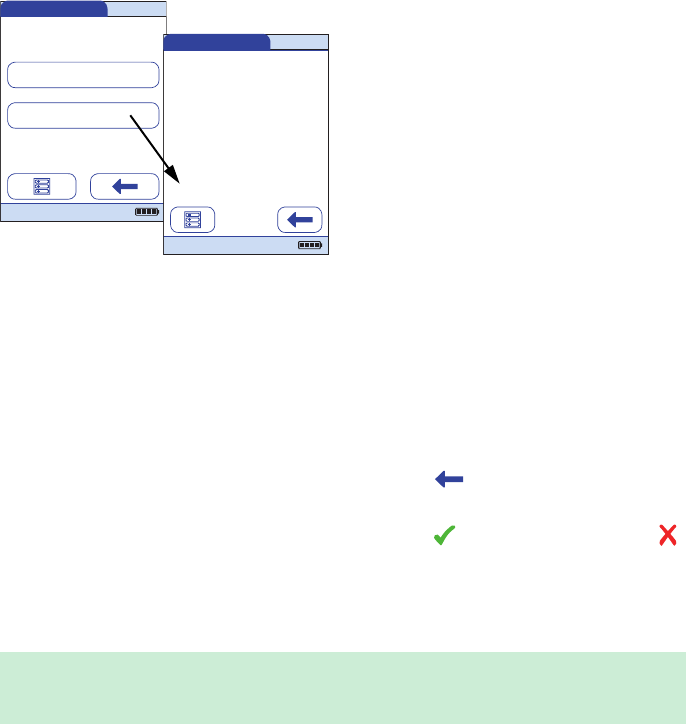
Meter Setup
67
10 Touch Encryption Key to display the
Encryption Key menu.
The Encryption Key menu displays two types
of information which are required in order to
identify and decode the transmitted test
result. This information is required by the IT
system, to which the test result is transmitted
via the defined URL.
■Key
This key is auto-generated by the meter
and is required to decrypt the QR code
information.
■Serial No.
The meter's serial number is required to
map the test result to the encryption key.
Touch the New button, if you want the
meter to generate a new encryption key.
11 Touch twice to return to the QR Code
menu.
12 Touch to save this setting, or touch
to exit this menu without saving any
changes. The display automatically
returns to the previous screen.
The Encryption Key information needs to be exchanged once with your specialized service pro-
vider prior to using the URL transmission method. Contact your specialized service provider in
order to exchange this information.
URL Transmission 09:15 am
04/19/2015
URL
Encryption Key
Encryption Key 09:15 am
04/19/2015
Note: The encryption key and
the serial number are required
to decrypt QR code messages
from this meter. Ensure they
are available on the target
system.
Key:
JD5G29F6U8V2WC4L
Serial No.:
UQ85464711
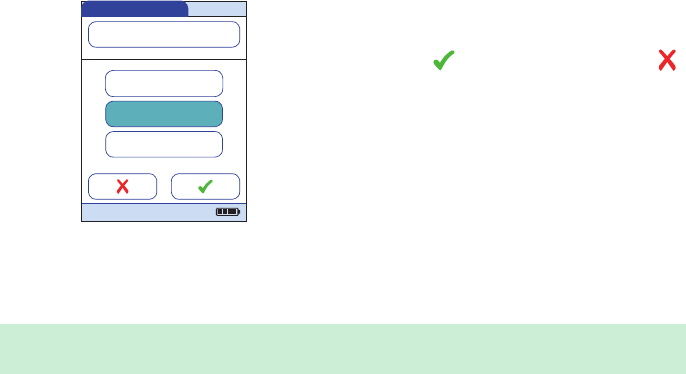
Meter Setup
68
Computer
The cobas h 232 meter can connect with a computer or host system running appropriate soft-
ware (that is, a DMS must be installed). To use this connectivity feature, however, you need the
optional Handheld Base Unit or the meter must be configured for wireless communication. If no
wireless communication is configured, the connection is established in two steps.
■The meter connects to the Handheld Base Unit via infrared.
■The Handheld Base Unit is either connected to a single computer (via USB) or to a net-
work/host system (via Ethernet).
The option Computer (when activated) can be used together with a DMS to set up:
■operator lists, or
■patient lists (lists of patients to be tested)
This eliminates the need for manual entry of these data. In addition, you can transfer test results
stored in the meter to other systems for archiving or further evaluation. The option Computer
controls the meter’s ability to communicate with a computer or a network.
13 From the Connection menu, touch
Computer. Your selection is now high-
lighted.
14 Touch to save this setting, or touch
to exit this menu without saving any
changes. The display automatically
returns to the previous screen.
Extended data handling functionality is dependent on the capabilities of the particular Data
Management System (DMS) being used and may vary.
Connection 09:15 am
04/19/2015
Printer
Computer
Off
QR Code
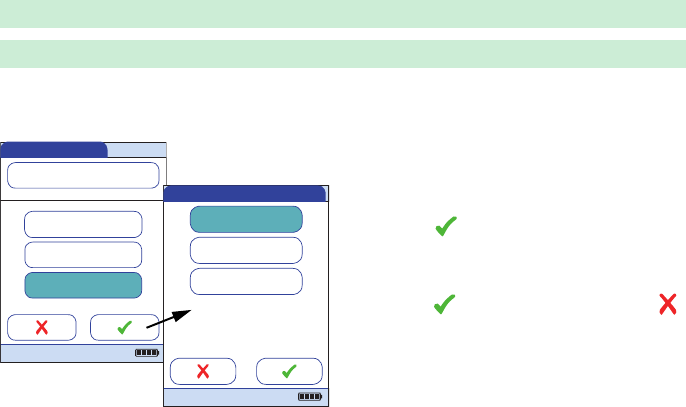
Meter Setup
69
Printer
The meter can connect directly with three different infrared printers. The Handheld Base Unit
cannot be used for this purpose.
The option to print is displayed in a test result as well as directly after a test and when calling up
stored results. Using the settings you enter here, you can activate or deactivate the meter‘s ability to
print.
Connection to a printer can only be established via infrared.
Enabling the connection to a printer disables the connection to a computer (and vice versa).
15 From the Connection menu, touch
Printer. Your selection is now high-
lighted.
16 Touch to confirm the selection. The
next screen allows you to choose the type
of printer you are using.
17 Touch to save this setting, or touch
to exit this menu without saving any
changes. The display automatically
returns to the previous screen.
Connection 09:15 am
04/19/2015
Printer
Computer
Off
QR Code
Citizen CMP-10
GeBE GPT-437x
Zebra MZ 320
Select Printer
04/19/2015

Meter Setup
70
To print :
■Align the meter with the IR printer
■At any test or memory screen,
touch .
The printer icon only appears if the printer
function is activated. Otherwise it is not
displayed.
Note: (Only applies if you are working with the
meter in a language other than English.) With
the exception of information you have entered
(such as patient ID and name, operator ID,
comments), the printout will be in English.
Pat. Test - Result
620 pg/ml
proBNP PB1234
SCHULZ, MANFRED
JONES, TOM
Par:
Op:
Code:
PID111SCHULZM457Pat:
04/19/2015
01/25/2015 10:17
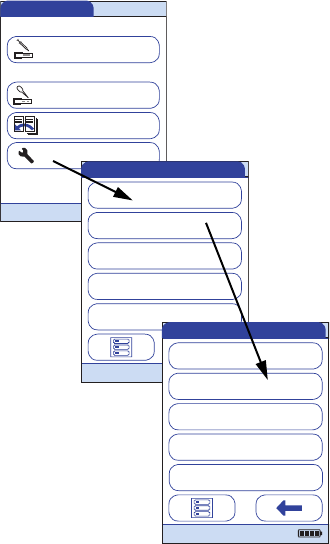
Meter Setup
71
Result memory
Result memory settings allow to apply a Result Display Filter and to set the Result Storage Mode
(see page 73).
All results recorded by the meter (patient results and quality controls) are stored automatically.
Use the Sel. Res. Display Filter menu to select whether to display results (when calling up the
Memory function) for all existing tests or only those from the current operator.
1From the Main Menu, touch Setup to
open the meter settings.
2From the Setup menu, touch Data
Handling .
3From the Setup-Data Handling menu,
touch Result Memory.
Main Menu
Control Test
Review Results
Setup
Patient Test
04/19/2015
09:15 am
Data Handling
ID Setup
Lockout
Basics
Optional Screens
Setup
04/19/2015
Result Memory
Result Units
Result Display Mode
Setup - Data Handling
Connection
04/19/2015
Diagnostics
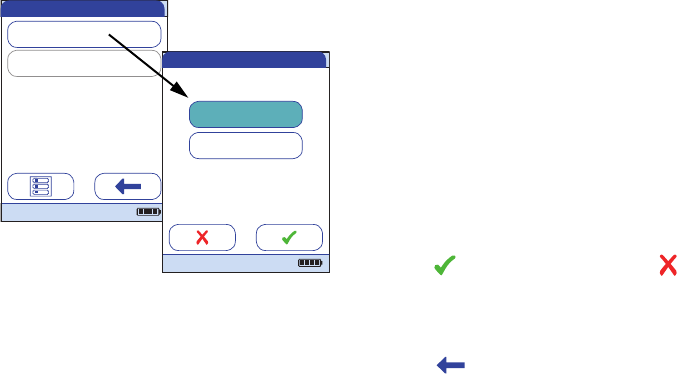
Meter Setup
72
4From the Setup-Result Memory menu,
touch Result Display Filter to select the
results to display.
The current setting is highlighted (white type
on a blue background). You may select from
the following options:
■All Results
■Current Op(erator) Res(ults)
5Touch to save this setting, or touch
to exit this menu without saving any
changes. The display automatically
returns to the previous screen.
6Touch to return to the Setup-Data
Handling menu.
Result Storage Mode
Result Display Filter
Setup - Result Memory
04/19/2015
Sel. Res. Display Filter
Current Op. Res.
All Results
04/19/2015

Meter Setup
73
The Sel. Res. Storage Mode menu tells the meter what to do when the memory is full.
In case of a full memory, you can choose between:
■No Result Deletion. This prevents data from being deleted inadvertently, but may (in case
of a full memory) lead to the situation that you cannot perform a new measurement. Fur-
ther measurements will only be possible if stored data are transferred to the data man-
agement system (DMS) or you allow automatic deletion.
■Del. Oldest Result. Based on the 1st in/1st out principle, the oldest result will be auto-
matically deleted when necessary. This is the only option if the meter is used without a
DMS (i.e. no data will be transferred and archived).
However, you only can select between these two options, if the meter is used together with a
DMS and the Computer connection is enabled. In this case data stored in the meter are flagged,
as soon as they have been transferred to the computer. Now the meter is allowed to delete those
flagged data when necessary, even if you have selected the No Result Deletion option.
The meter memory can store a maximum of 2000 patient tests, 500 liquid controls, and 200
instrument quality controls.
The option No Result Deletion is available only when you are using a DMS. For more details
see “Extended Functionalities”, starting on page 159. If you are not working with a DMS, this
option is set to Del. Oldest Result.
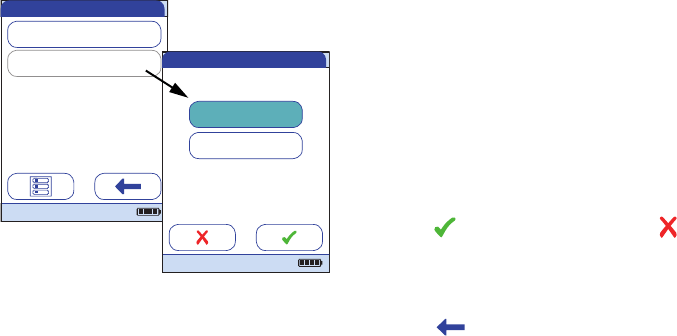
Meter Setup
74
7From the Setup-Result Memory menu,
touch Result Storage Mode to select
your storage mode.
You may select from the following options:
■No Result Deletion
■Del(ete) Oldest Result
8Touch to save this setting, or touch
to exit this menu without saving any
changes. The display automatically
returns to the previous screen.
9Touch to return to the Setup-Data
Handling menu.
Result Storage Mode
Result Display Filter
Setup - Result Memory
04/19/2015
Sel. Res. Storage Mode
Del. Oldest Result
No Result Deletion
04/19/2015
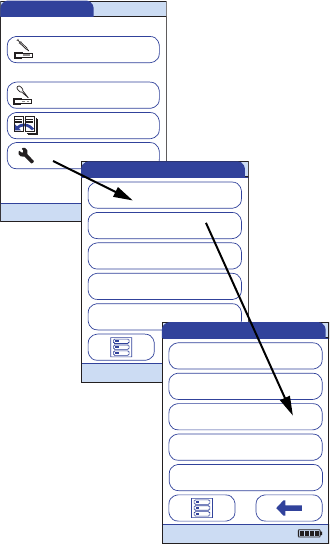
Meter Setup
75
Result units
The result unit setting applies to the result display of D-Dimer and Troponin T tests only.
1From the Main Menu, touch Setup to
open the meter settings.
2From the Setup menu, touch Data
Handling.
3From the Setup-Data Handling menu,
touch Result Units.
Main Menu
Control Test
Review Results
Setup
Patient Test
04/19/2015
09:15 am
Data Handling
ID Setup
Lockout
Basics
Optional Screens
Setup
04/19/2015
Result Memory
Result Units
Result Display Mode
Setup - Data Handling
Connection
04/19/2015
Diagnostics
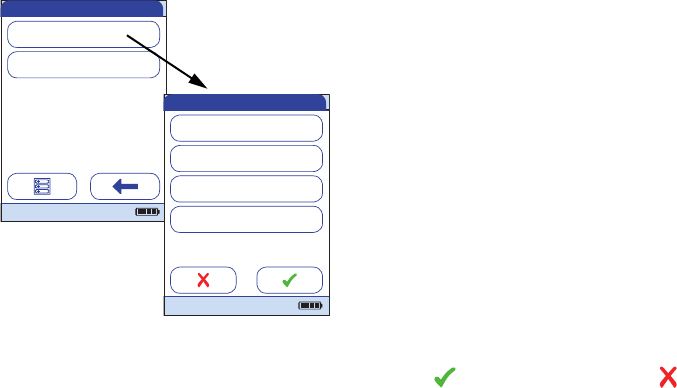
Meter Setup
76
4From the Setup-Result Units menu, touch
DD Result Unit.
5From the Select DD Res. Unit menu, select
the unit to be used for the D-Dimer result
display.
The current setting is highlighted (white type
on a blue background). You may select from
the following options:
■g/mL
■ng/mL
■mg/L
■g/L
6Touch to save this setting, or touch
to exit this menu without saving any
changes. The display automatically
returns to the previous screen.
TT Result Units
Setup - Result Units
DD Result Unit
04/19/2015
ng/mL
mg/L
µg/L
Select DD Res. Unit
µg/mL
04/19/2015

Meter Setup
77
7From the Setup-Result Units menu, touch
TT Result Unit.
8From the Select TT Res. Unit menu, select
the unit to be used for the Troponin T
result display.
The current setting is highlighted (white type
on a blue background). You may select from
the following options:
■ng/L
■pg/mL
■ng/mL
■g/L
9Touch to save this setting, or touch
to exit this menu without saving any
changes. The display automatically
returns to the previous screen.
10 Touch to return to the Setup-Data
Handling menu.
TT Result Units
Setup - Result Units
DD Result Unit
04/19/2015
ng/mL
mg/L
µg/L
Select TT Res. Unit
µg/mL
04/19/2015
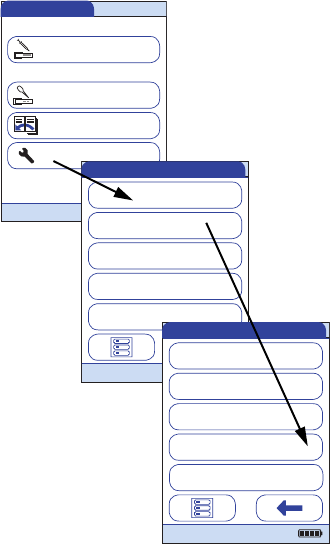
Meter Setup
78
Result display mode
Test results may be displayed either with a static or a flashing display, the latter visually indicat-
ing that the measurement process has been finished. Once a result is available, the display starts
flashing. Depending on the settings, this may be either a quantitative or qualitative result screen
or an operator login screen.
1From the Main Menu, touch Setup to
open the meter settings.
2From the Setup menu, touch Data
Handling.
3From the Setup-Data Handling menu,
touch Result Display Mode.
Main Menu
Control Test
Review Results
Setup
Patient Test
04/19/2015
09:15 am
Data Handling
ID Setup
Lockout
Basics
Optional Screens
Setup
04/19/2015
Result Memory
Result Units
Result Display Mode
Setup - Data Handling
Connection
04/19/2015
Diagnostics
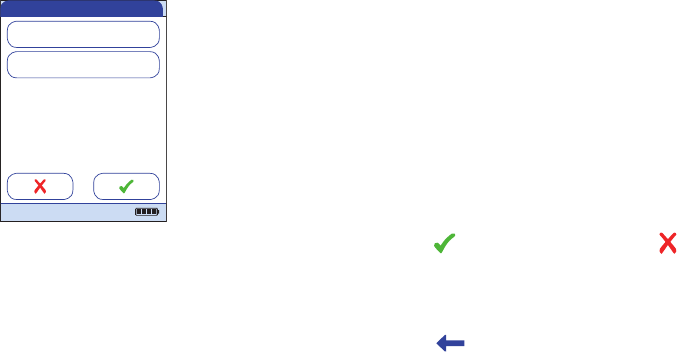
Meter Setup
79
4From the Select Res. Display Mode menu,
select your display mode.
The current setting is highlighted (white type
on a blue background). You may select from
the following options:
■Static
■Flashing
5Touch to save this setting, or touch
to exit this menu without saving any
changes. The display automatically
returns to the previous screen.
6Touch to return to the Setup-Data
Handling menu.
Flashing
Select Res. Display Mode
Static
04/19/2015
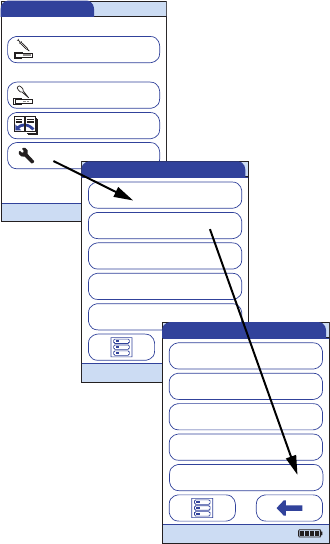
Meter Setup
80
Diagnostics
Under Diagnostics, you will find information about the system, such as software version, number
of data records stored, and configuration details. The Diagnostics menu contains functions rele-
vant for installation, maintenance and troubleshooting purposes. In case of technical problems
the firmware version (Build) is an important information for the Roche Diagnostics customer
support.
The diagnostics screens shown here are for illustration purposes only. The Information shown on
your meter may differ.
1From the Main Menu, touch Setup to
open the meter settings.
2From the Setup menu, touch Data
Handling.
3From the Setup-Data Handling menu,
touch Diagnostics.
Main Menu
Control Test
Review Results
Setup
Patient Test
04/19/2015
09:15 am
Data Handling
ID Setup
Lockout
Basics
Optional Screens
Setup
04/19/2015
Result Memory
Result Units
Result Display Mode
Setup - Data Handling
Connection
04/19/2015
Diagnostics
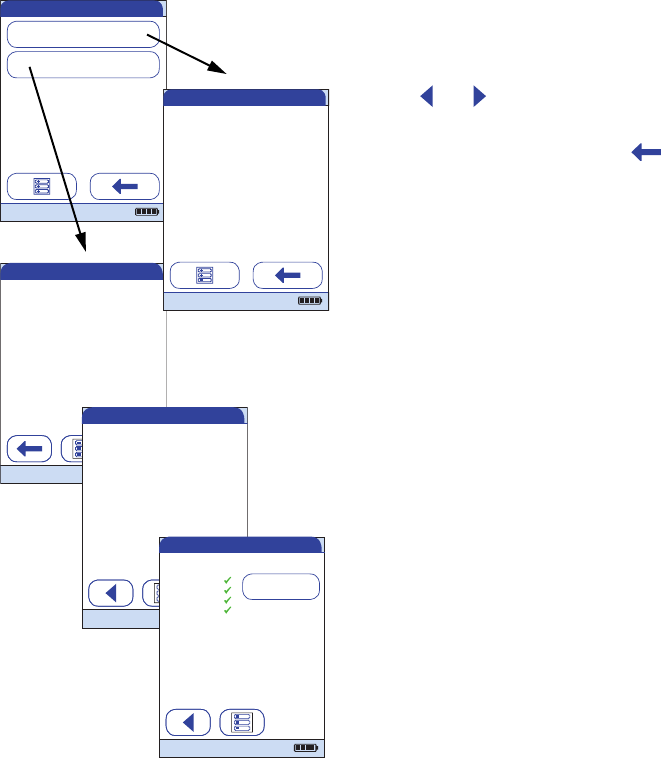
Meter Setup
81
4From the Setup-Diagnostics menu, touch
the button of the diagnostics screen you
want to display.
5Use and to toggle between the
Wireless Setup screens.
6In either diagnostics screen, touch to
return to the Diagnostics menu.
Note: The Wireless Setup button is only
available if the the WLAN function is enabled
on this meter.
Use DNS:
Use DHCP:
Enabled
Disabled
SSID:
cobas h 232
WLAN:
01 23 45 67 89 AB
Wireless Setup - Network
04/19/2015
Wireless Setup
MAC:
Wireless Setup
Setup - Diagnostics
Software
04/19/2015
Software
Build:
04/19/2015
Boot:
MM-FW:
MM-BL:
App:
RootFS:
Kernel:
04.00.00
06.03.00
03.00.00
03.00.00
04.00.00
06.03.00
06.03.00
DMS Port Number:
DMS Name:
POCTServer
4711
DMS IP Address:
0.0.0.0
RF Security:
WPA2-PSK (AES)
Wireless Setup - Connection
04/19/2015
Wireless Setup
Test
Authenticated:
RF activated:
Associated:
Confi gured IP:
IP:
Subnet:
Gateway:
DNS:
Contacted DMS:
Connected to DMS:
Completed:
255.255.255.0
Wireless Setup - Test
04/19/2015
Wireless Setup
192.168.0.123
Meter Setup
82
3.3 ID Setup setting
Use the ID Setup menu to enter settings for user management and patient management. These
settings are optional and set to Off/Inactive by default; the meter can be operated without these
settings.
There are three types of identification used with the meter:
■System Administrator: The administrator has special rights to enter certain meter set-
tings and is the only one who can enter and change these settings. It is not necessary for
administrator identification to be activated to use the cobas h 232 meter. However, it
might be desired or necessary, depending on the regulatory environment and the site of
use.
■Operator: The Operator ID is assigned to persons who use the meter to run tests. If you
want to use Operator IDs, you have several options:
– You may use Operator IDs to restrict the use of the meter to qualified personnel or a
predefined group of users. In this case an operator list created on a DMS must be trans-
ferred to the meter, enabling you to select an Operator ID when logging in. For more
details see “Data handling”, starting on page 159.
– You may use Operator IDs for informational purposes only, in order to assign stored
measurement results to the users who performed the test. In this case Operator IDs may
directly be entered on the meter (by keypad or scanner), with or without an operator list
being available.
■Patient: The Patient ID is assigned to the person, whose test results are recorded. You
can either:
– block input of a unique Patient ID (in this case, every test is simply numbered in
consecutive order)
– allow a unique Patient ID as optional, or
– require a unique Patient ID for every test. Patient lists created on a DMS can also be trans-
ferred to the meter, enabling you to select Patient IDs for a test from these lists. For more
details see “Data handling”, starting on page 159.
Operator IDs can be selected from a list (if available) or read by the barcode scanner on the front
of the meter. If passwords were created, they must be entered via the onscreen keypad.
Patient IDs can be entered by using the onscreen keypad or the barcode scanner on the front of
the meter.

Meter Setup
83
Administrator ID
In the default setting, the meter is not protected with an Administrator ID, and all setup options
are accessible to every user. If you set up an Administrator ID, the following setup areas are auto-
matically reserved only for the administrator (i.e., the person who knows the password):
■Screen: Date/Time
■Data Handling
■ID Setup
■Quality control and the associated lockouts
■Optional screens
The setup of an Administrator ID does not limit or alter the usage of the meter for measurements
in any way. Furthermore setting up the Administrator ID has no impact on the usage of
Operator IDs. Only the setup options as listed above are tied to administrator access.
When you enter an Administrator ID, this ID must be entered from this point forward before
any future IDs can be set up (anywhere in the ID Setup menu). The Administrator ID must also
be entered before you can delete or change the Administrator ID.
If you forget the Administrator ID, the meter setup may be unlocked via the external data man-
agement system (e.g., cobas IT 1000). If you don’t use such a system and need to reset the
Administrator ID, contact your Roche representative (see Chapter 10).
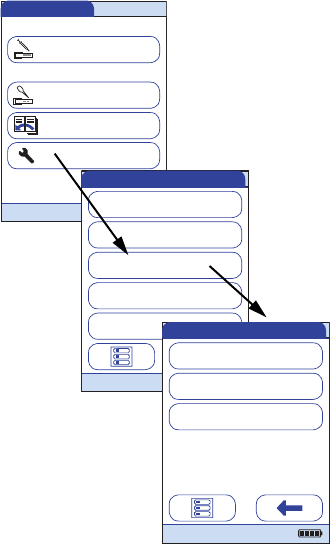
Meter Setup
84
If an Administrator ID has not been set up
yet:
1From the Main Menu, touch Setup to
open the meter settings.
2From the Setup menu, touch ID Setup.
3From the Setup-ID Setup menu, touch
Administrator ID.
Main Menu
Control Test
Review Results
Setup
Patient Test
04/19/2015
09:15 am
Data Handling
ID Setup
Lockout
Basics
Optional Screens
Setup
04/19/2015 Operator ID
Patient ID
Administrator ID
Setup - ID Setup
04/19/2015
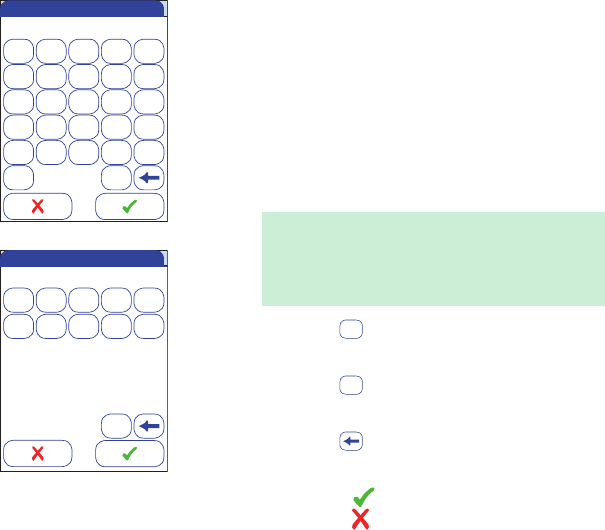
Meter Setup
85
4Using the onscreen keypad, enter the
Administrator ID of choice (or the pass-
word provided by Roche Diagnostics).
The ID can consist of up to 20 alpha-
numeric characters.
Alphanumeric characters are any combi-
nation of A - Z and 0 - 9. Additionally “.”
(period), or “-” (hyphen) may be used.
Pay close attention to the buttons you press,
because the characters are not displayed on
the screen. Asterisks are displayed instead (as
if entering a password on a computer).
5Use to switch to the input of
numbers.
6Use to switch back to the input of
text.
7Use to backspace and correct a
mistake.
8Touch to save this Administrator ID, or
touch to exit this menu without saving
any changes.
A
****|
BCDE
FGHI J
KLMNO
PQRST
U VWX Y
Z 123
Enter Administrator ID
Enter Administrator ID
01234
56789
ABC
****|
123
ABC
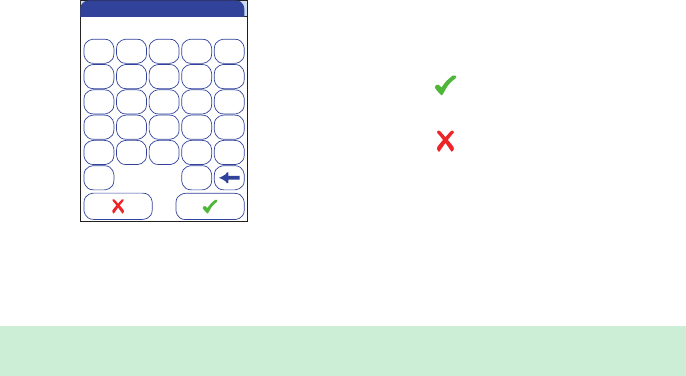
Meter Setup
86
9Enter the Administrator ID again (the
onscreen keypad is automatically dis-
played again) to confirm the first entry.
Touch to save this entry, (the
Administrator ID is now set), or
Touch to exit this menu, the
Administrator ID is not set and is therefore
still inactive.
The display automatically returns to the Setup-ID Setup menu. After you exit the Setup menu,
only an authenticated administrator may set up any further IDs.
Repeat Administrator ID
A
****|
BCDE
FGHI J
KLMNO
PQRST
U VWX Y
Z 123
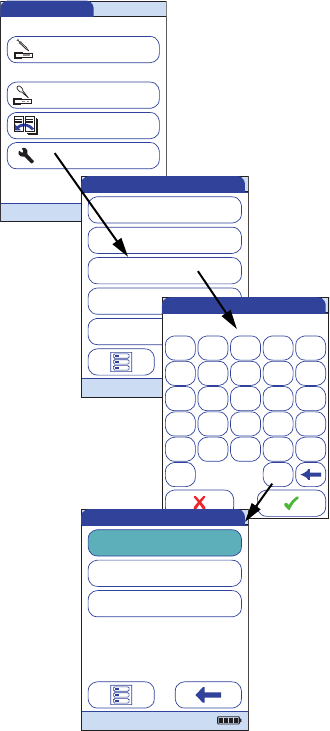
Meter Setup
87
Changing an existing Administrator ID:
1From the Main Menu, touch Setup to
open the meter settings.
2From the Setup menu, touch ID Setup.
3Using the onscreen keypad, enter the
valid Administrator ID.
The ID Setup is displayed. The Adminis-
trator ID button is highlighted, which
means an Administrator ID is active.
4Touch Administrator ID and use the
onscreen keypad to enter a new ID of
choice (enter it twice).
Main Menu
Control Test
Review Results
Setup
Patient Test
04/19/2015
09:15 am
Data Handling
ID Setup
Lockout
Basics
Optional Screens
Setup
04/19/2015
A
****|
BCDE
FGHI J
KLMNO
PQRST
U VWX Y
Z 123
Enter Administrator ID
Operator ID
Patient ID
Administrator ID
Setup - ID Setup
04/19/2015

Meter Setup
88
Disabling an existing Administrator ID:
1From the Main Menu, touch Setup to
open the meter settings.
2From the Setup menu, touch ID Setup.
3Using the onscreen keypad, enter the
valid Administrator ID.
The ID Setup is displayed. The Adminis-
trator ID button is highlighted, which
means an Administrator ID is active.
4Touch Administrator ID.
5Touch to close the onscreen keypad
without entering an ID number.
The Administrator ID has been deleted
and therefore deactivated. The Adminis-
trator ID button is no longer highlighted.
Main Menu
Control Test
Review Results
Setup
Patient Test
04/19/2015
09:15 am
Data Handling
ID Setup
Lockout
Basics
Optional Screens
Setup
04/19/2015
A
****|
BCDE
FGHI J
KLMNO
PQRST
U VWX Y
Z 123
Enter Administrator ID
Operator ID
Patient ID
Administrator ID
Setup - ID Setup
04/19/2015
A
|
BCDE
FGHI J
KLMNO
PQRST
U VWX Y
Z 123
Enter Administrator ID
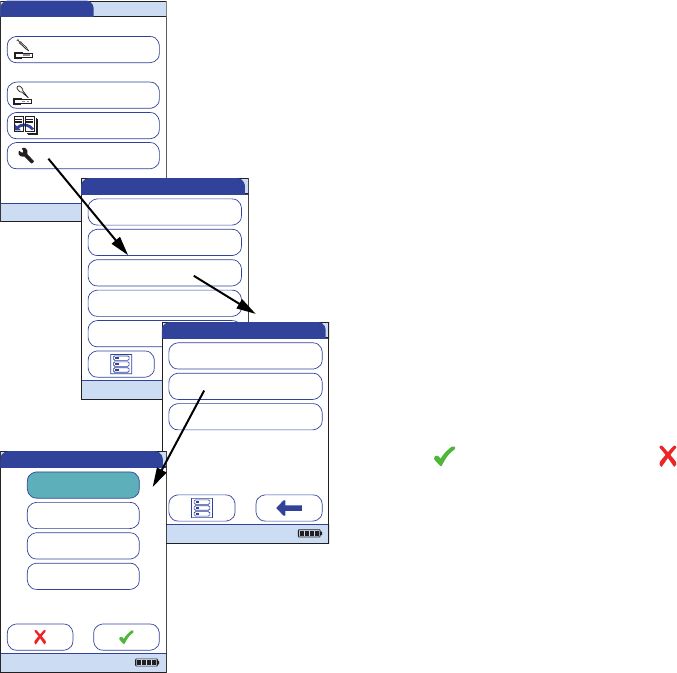
Meter Setup
89
Operator ID
In the default setting, the Operator login is not activated. You can either activate or deactivate
Operator login on the meter. If activated, an Operator has to log in before the Main Menu will be
displayed and measurements can be performed. Without a list, operators can log in directly by
entering their operator name. This setup menu allows you to select whether or not an operator
login is possible or required.
1From the Main Menu, touch Setup to
open the meter settings.
2From the Setup menu, touch ID Setup.
3From the Setup-ID Setup menu, touch
Operator ID.
You may select from the following options:
■Off (Operator ID cannot be entered)
■Optional (Operator ID can be entered,
but is not required)
■Required (An Operator ID must be
entered)
■Scan Only (An Operator ID must be
scanned)
4Touch the button with the setting of
choice. Your selection is now highlighted.
5Touch to save this setting, or touch
to exit this menu without saving any
changes. The display automatically
returns to the previous screen or (depend-
ing on the option you selected) proceeds
to the next screen.
The entries for the option Off are now
completed. For the options Optional and
Required, continue by selecting the input
format.
Main Menu
Control Test
Review Results
Setup
Patient Test
04/19/2015
09:15 am
Data Handling
ID Setup
Lockout
Basics
Optional Screens
Setup
04/19/2015 Operator ID
Patient ID
Administrator ID
Setup - ID Setup
04/19/2015
Select Operator ID
Off
Optional
Required
Scan Only
04/19/2015
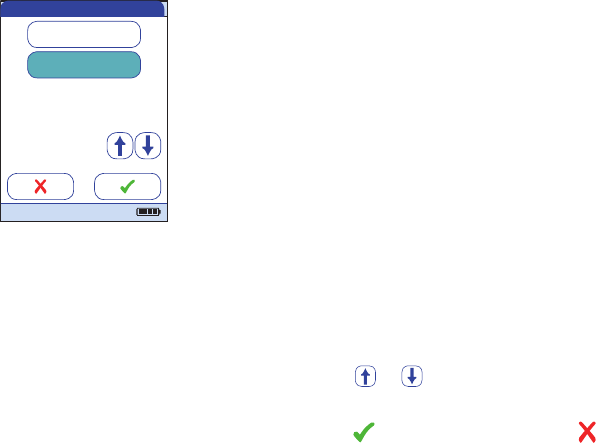
Meter Setup
90
6Select the form for input of the Operator
ID.
You may select from the following options:
■Alphanum. (alphanumeric)
Enter any combination of A - Z and 0 - 9.
Additionally “.” (period), or “-” (hyphen)
may be used.
■Numeric
Enter numbers only, e.g., “3387”
■Max. Length
Enter the maximum number of characters
(1 … 20) the Operator ID can have.
7Touch the button with the form of choice
for setting up the Operator ID. Your selec-
tion is now highlighted.
8Touch or to set the number of
characters (length) of choice.
9Touch to save this setting, or touch
to exit this menu without saving any
changes.
The meter automatically returns to the
Setup-ID Setup menu.
Operator ID
Alphanum.
Numeric
Max. Length:
20
04/19/2015
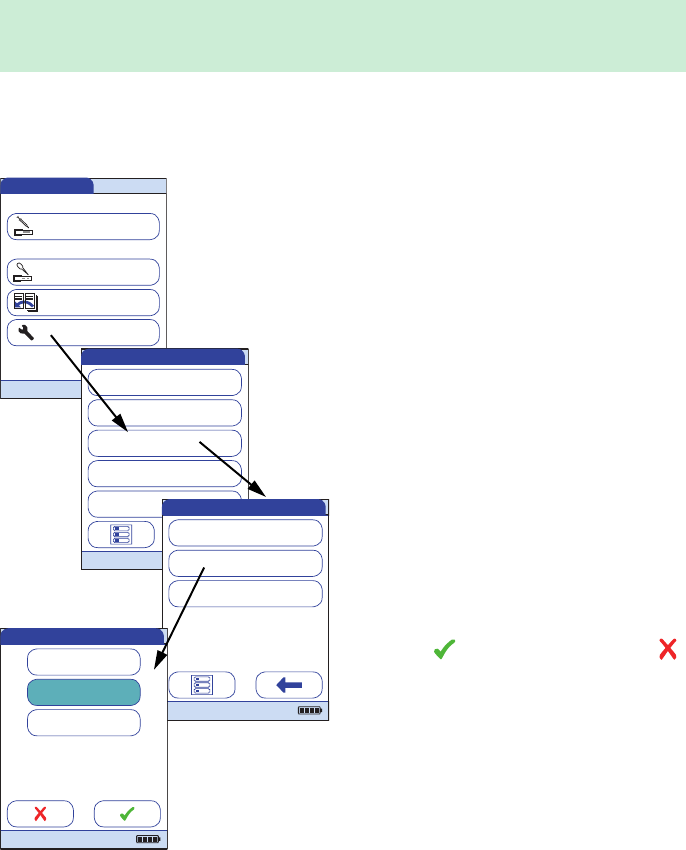
Meter Setup
91
With an Operator list being transferred to the meter, the Operator ID options are different from
the options in “standalone” mode.
If you want to create a list of Operator IDs from which you can select an operator, additional
software (a data management system) and a WLAN connection or the Handheld Base Unit
are required (for more details see “Data handling”, starting on page 159).
1From the Main Menu, touch Setup to
open the meter settings.
2From the Setup menu, touch ID Setup.
3From the Setup-ID Setup menu, touch
Operator ID.
You may select from the following options:
■List (Operator ID must be selected from
the list or scanned using the barcode
scanner)
■None (Operator ID cannot be entered or
selected)
■Hidden List (Operator ID must be
entered using the barcode scanner or the
onscreen keypad)
4Touch the button with the setting of
choice. Your selection is now highlighted.
5Touch to save this setting, or touch
to exit this menu without saving any
changes. The display automatically
returns to the previous screen.
Main Menu
Control Test
Review Results
Setup
Patient Test
04/19/2015
09:15 am
Data Handling
ID Setup
Lockout
Basics
Optional Screens
Setup
04/19/2015 Operator ID
Patient ID
Administrator ID
Setup - ID Setup
04/19/2015
Select Operator ID
List
None
Hidden List
04/19/2015
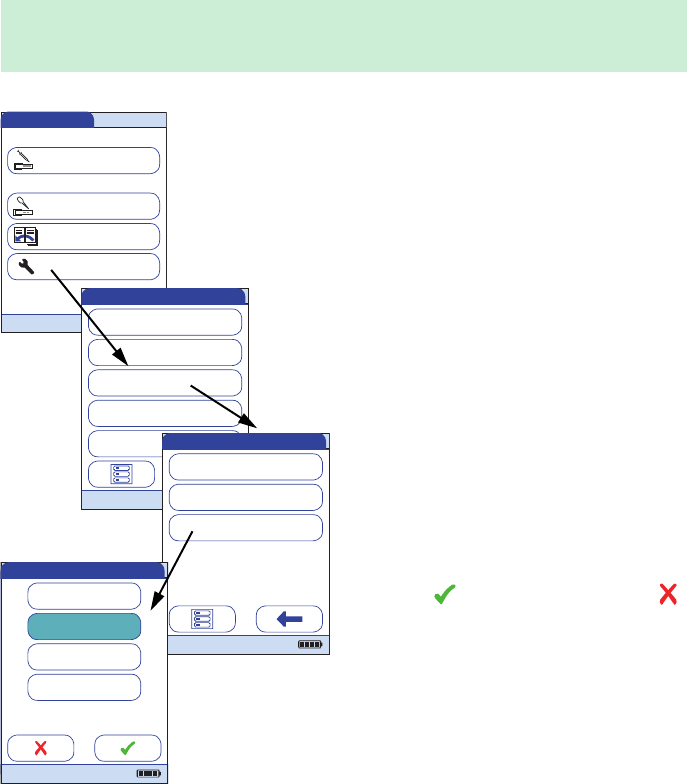
Meter Setup
92
Patient ID
Patient IDs help you to assign stored results to individual patients. In the default setting, input of
Patient IDs is set to No. This means that a consecutive number is assigned to each test. However,
you can require that a Patient ID must be entered or make it optional.
If you want to create a list of Patient IDs from which you can select a patient for testing, addi-
tional software (a data management system) and a WLAN connection or the Handheld Base
Unit are required (see page 159).
1From the Main Menu, touch Setup to
open the meter settings.
2From the Setup menu, touch ID Setup.
3From the Setup-ID Setup menu, touch
Patient ID.
You may select from the following options:
■Off (Patient ID cannot be entered)
■Optional (Patient ID can be entered, but
is not required)
■Required (The operator must enter the
Patient ID)
■Hidden List (Only available when work-
ing with a DMS. The list will not be shown.
The operator needs to enter the Patient ID
manually or via barcode scan.)
4Touch the button with the setting of
choice. Your selection is now highlighted.
5Touch to save this setting, or touch
to exit this menu without saving any
changes. The display automatically
returns to the previous screen or (depend-
ing on the option you selected) proceeds
to the next screen.
The entries for the option Off are now
completed. For the options Optional and
Required, continue by selecting the input
format.
Main Menu
Control Test
Review Results
Setup
Patient Test
04/19/2015
09:15 am
Data Handling
ID Setup
Lockout
Basics
Optional Screens
Setup
04/19/2015 Operator ID
Patient ID
Administrator ID
Setup - ID Setup
04/19/2015
Off
Optional
Required
Hidden List
Select Patient ID
04/19/2015
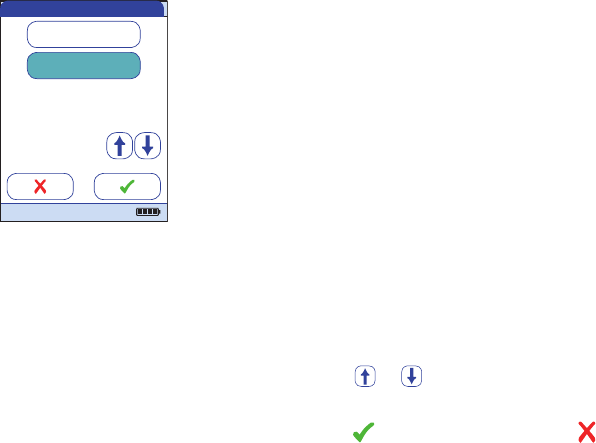
Meter Setup
93
6Select the form for input of the Patient ID
before each test.
You may select from the following options:
■Alphanum. (alphanumeric)
Enter any combination of A - Z and 0 - 9.
Additionally “.” (period), or “-” (hyphen)
may be used.
■Numeric
Enter numbers only, e.g., “3387”
■Max. Length
Enter the maximum number of characters
(1 … 20) the Patient ID can have.
7Touch the button with the form of choice
for the Patient ID. Your selection is now
highlighted.
8Touch or to set the number of
characters (length) of choice.
9Touch to save this setting, or touch
to exit this menu without saving any
changes.
The display automatically returns to the
Setup-ID Setup menu.
Alphanum.
Numeric
Max. Length:
20
Patient ID
04/19/2015
Meter Setup
94
3.4 Lockout setup
The Lockout menu contains the options for quality control tests that the operator is required to
perform at specified intervals or based on specific triggers. This is a list of the available lockout
options:
■Operator Lockout
■QC Settings, containing
– New Lot Lockout
– QC Lockout
– IQC Lockout
– Custom Range Trop T
■Cleaning Lockout
■STAT Test Config. (overriding a lockout in an emergency situation)
If the quality control test is not performed as required or if the result is outside the target value
range, the meter, parameter or test strip lot is locked from further use. Lockouts can also be set
up on an operator-specific basis, i.e., each operator must perform the corresponding quality con-
trol tests at specified intervals.
A quality control test must be completed successfully before the meter is made available again
(either to the operator or in general) for testing.
The option of setting up lockouts for operators is available only when the meter is set up for
operator logins (see page 89) and operator lists are stored in the meter.
In case of an emergency, there may not be the time to first complete the required quality control
test if a lockout has been triggered and the meter is "locked". For such cases you may set up so-
called STAT Tests (STAT = Short TurnAround Time). This option allows to perform a limited
number of tests when an operator lockout or QC lockout is in force. However, once the defined
number of STAT tests has been performed, further use of the meter is no longer possible (for the
affected test parameter or operator), unless the required quality control test is successfully
completed.
STAT tests cannot be performed if IQC lockout is in place or a new lot has not (yet) passed a
quality control test (New Lot Lockout).
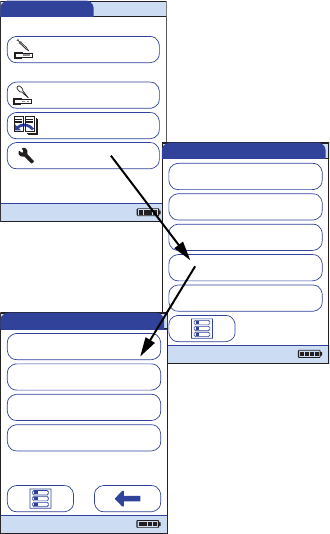
Meter Setup
95
Operator lockout
To perform a test with the meter, the individual steps must be performed properly. Quality control
tests can be performed on a regular basis by every operator to ensure these steps are performed
properly. By activating the operator lockout, operators are required to perform regular quality
control tests.
1From the Main Menu, touch Setup to
open the meter settings.
2From the Setup menu, touch Lockout.
3From the Setup-Lockout menu, touch
Operator Lockout.
If this button appears in gray (inactive),
the option Operator ID is deactivated.
Main Menu
Control Test
Review Results
Setup
Patient Test
04/19/2015
09:15 am
Data Handling
ID Setup
Lockout
Basics
Optional Screens
Setup
04/19/2015
QC Settings
Cleaning Lockout
STAT Test Confi g.
Operator Lockout
Setup - Lockout
04/19/2015
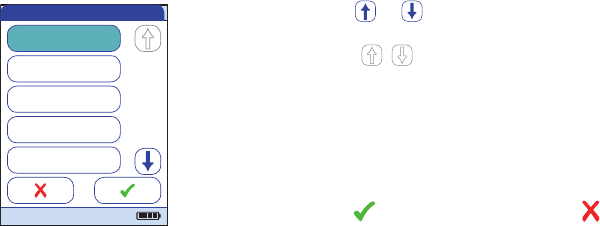
Meter Setup
96
4Select the time interval of choice in which
the required quality control tests must be
performed.
You may select from the following options:
■No (deactivated)
■Daily
■Weekly
■Monthly
■Every 3 or 6 months
■Yearly
5Touch or to display the option of
choice on the screen. If the arrow is just an
outline , this means no other
options are available in the direction indi-
cated.
6Touch the button to select the time interval
of choice. Your selection is now high-
lighted.
7Touch to save this setting, or touch
to exit this menu without saving any
changes.
If you selected No, Operator Lockout is deac-
tivated.
No
Daily
Weekly
Monthly
Every 3 Months
Select Operator Lockout
04/19/2015
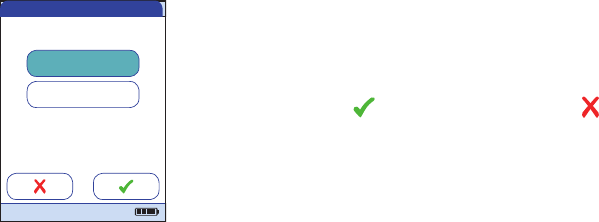
Meter Setup
97
8Quality control tests may include one or
two levels. Select the number of levels
which must be performed (not applicable,
if you selected No).
9Touch to save this setting, or touch
to exit this menu without saving any
changes. The display automatically returns
to the Setup-Lockout menu.
Two Levels
One Level
No of Levels
Select Operator Lockout
04/19/2015
Meter Setup
98
Quality control (QC) settings
QC Settings define that operator-independent quality control tests must be run on a regular
basis. Lockouts may be triggerd by selectable time periods, and lockouts may be triggered by
certain events. The QC Settings menu contains the following options:
■QC Lockout (time-based), with the additional option of a New Lot Lockout (applies every
time a new test strip lot is used)
■IQC Lockout (time-based)
■Custom Range Trop. T (customize the QC Range in accordance with applicable local
guidelines)
■QC Result Format (select the format for QC result displays)
■Reset Test Param. (reset all test parameters, including code chip data and QC lockouts)
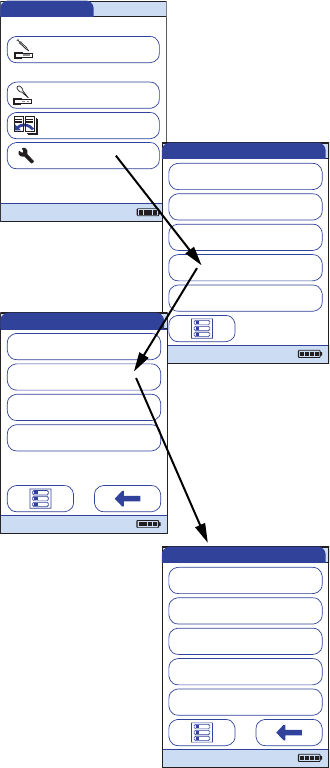
Meter Setup
99
1From the Main Menu, touch Setup to
open the meter settings.
2From the Setup menu, touch Lockout.
3From the Setup-Lockout menu, touch
QC Settings.
Main Menu
Control Test
Review Results
Setup
Patient Test
04/19/2015
09:15 am
Data Handling
ID Setup
Lockout
Basics
Optional Screens
Setup
04/19/2015
QC Settings
Cleaning Lockout
STAT Test Confi g.
Operator Lockout
Setup - Lockout
04/19/2015
QC Lockout
IQC Lockout
QC Result Format
Custom Range Trop. T
Reset Test Param.
Setup - QC Settings
04/19/2015
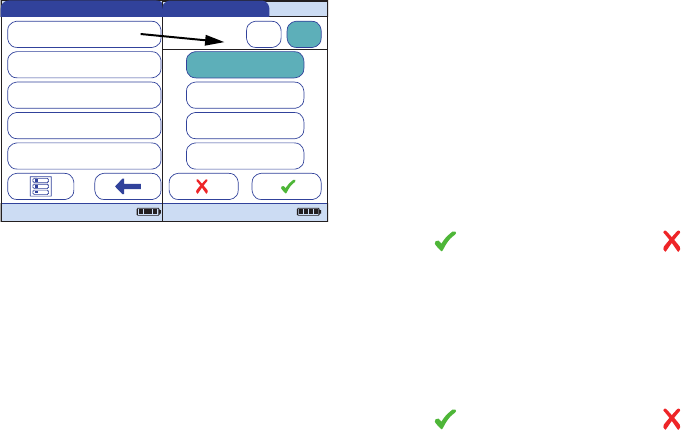
Meter Setup
100
Quality control (QC) lockout
A QC Lockout requires a quality control test to be performed. You may also set the number of
levels for this test. You may select from the following options:
■New Lot: Yes/No (applies every time a new test strip lot is used)
The general intervals are:
■No
■Daily
■Weekly
■Monthly
All enabled QC Lockouts, if the time period has elapsed, are activated at 8:00 a.m. (default set-
ting, time can be changed with a DMS).
See page 99 on how to access the Setup-QC Settings menu.
1Touch QC Lockout to set regularly recur-
ring quality control tests for available test
parameters.
2New Lot: Touch Yes if you want to force a
control test every time a new test strip lot
is used. Otherwise touch No.
3Time intervals: Touch the button to select
the time interval of choice (e.g., Daily).
Your selection is now highlighted.
4Touch to save this setting, or touch
to exit this menu without saving any
changes.
5Quality control tests may include one or
two levels. Select the number of levels
which must be performed (not applicable,
if you selected No).
6Touch to save this setting, or touch
to exit this menu without saving any
changes. The display automatically returns
to the previous screen.
QC Lockout
IQC Lockout
QC Result Format
Custom Range Trop. T
Reset Test Param.
Setup - QC Settings
04/19/2015
Setup - Lockout
New Lot:
Yes No
Daily
Weekly
Monthly
No
09:15 am
04/19/2015

Meter Setup
101
Instrument quality control (IQC) lockout
An IQC Lockout also requires a quality control test with dedicated IQC test strips to be per-
formed. You may select from the following options:
■No
■Daily
■Weekly
■Monthly
All enabled IQC Lockouts, if the time period has elapsed, are activated at 8:00 a.m. (default set-
ting, time can be changed with a DMS).
See page 99 on how to access the Setup-QC Settings menu.
1Touch IQC Lockout to set regularly recur-
ring instrument quality control tests (IQC
= Instrument Quality Control).
2Touch the button to select the time interval
of choice. Your selection is now high-
lighted.
3Touch to save this setting, or touch
to exit this menu without saving any
changes. The display automatically returns
to the previous screen.
QC Lockout
IQC Lockout
QC Result Format
Custom Range Trop. T
Reset Test Param.
Setup - QC Settings
04/19/2015
No
Daily
Weekly
Monthly
Select IQC Lockout
04/19/2015

Meter Setup
102
QC result format
The QC Result format defines the kind of information that is displayed in a QC result screen. You
may select from the following options:
■Display without a value, but with text “Pass” or “Fail”
■Display a value
■Display as value and with text “Pass” or “Fail”
See page 99 on how to access the Setup-QC Settings menu.
1Touch QC Result Format to set the dis-
play format.
2Touch the button to select the result
format of choice. Your selection is now
highlighted.
3Touch to save this setting, or touch
to exit this menu without saving any
changes. The display automatically returns
to the previous screen.
QC Lockout
IQC Lockout
QC Result Format
Custom Range Trop. T
Reset Test Param.
Setup - QC Settings
04/19/2015
Pass/Fail
Value
Value & Pass/Fail
Select QC Result Format
04/19/2015
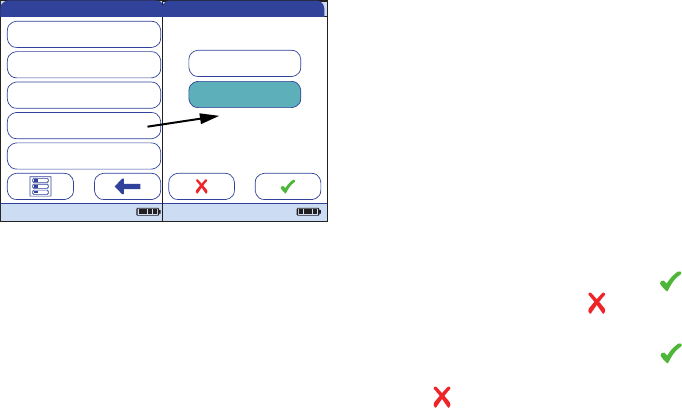
Meter Setup
103
Custom Range Troponin T
The quality control range for Troponin T can be customized to comply with local guidelines. The
Custom Range Trop. T function enables you to narrow the default range.
■Default Range: The meter displays the quality control range provided by Roche in the
code chip.
■Custom Range: The option Custom Range lets the user define their own quality control
range within the default range.
See page 99 on how to access the Setup-QC Settings menu.
1Touch Custom Range Trop. T to set the
quality control range.
You may select from the following options:
■Default Range (Range provided in the
code chip is selected and displayed.)
■Custom Range (The allowed percentage
deviation from target value can now be
customized).
2Touch the button with the setting of
choice. Your selection is now highlighted.
■If you selected Default Range, touch
to save this setting, or touch to exit this
menu without saving any changes.
■If you selected Custom Range, touch
to proceed with corresponding settings, or
touch to exit this menu without saving
any changes The display automatically
returns to the previous screen.
QC Lockout
IQC Lockout
QC Result Format
Custom Range Trop. T
Reset Test Param.
Setup - QC Settings
04/19/2015
Custom Range
Default Range
Custom Range Trop. T
04/19/2015
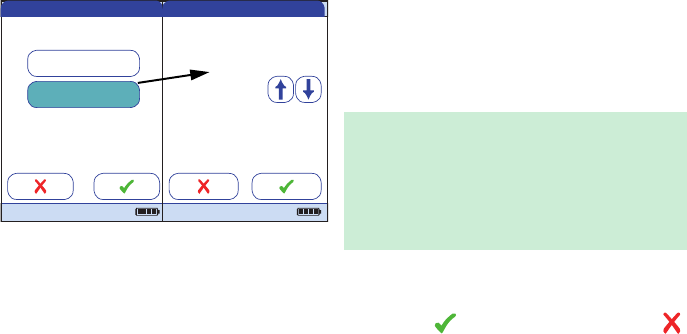
Meter Setup
104
If you selected Custom Range, the Custom
Range screen opens and offers you the option
of customizing the deviation from target value
(percentage value).
For the control solutions, the target value
always comes from the information stored in
the code chip. If you have chosen Custom
Range, you can now select an allowed devia-
tion from target value in the range of 0 to 50%
(in the illustration, 21%).
3Use the arrows to to set the allowed per-
centage deviation from the target value.
■Touch to save this setting, or touch
to exit this menu without saving any
changes. The display automatically returns
to the previous screen.
Custom Range
Default Range
Custom Range Trop. T
04/19/2015
Custom Range Trop. T
Deviation from target
value (in %):
21
04/19/2015
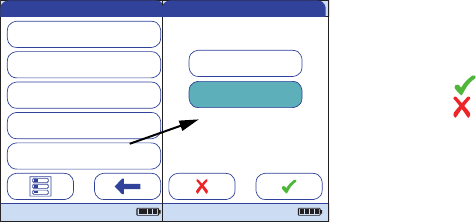
Meter Setup
105
Reset test parameters
Under certain circumstances, it may be necessary to delete the test parameters stored in the
meter (for example, if a lockout exists for a test strip lot that is no longer available). However, do
not use this method for overriding lockouts in general because, after resetting the test parame-
ters, the meter may go into a QC lockout (if configured). If the meter or a parameter is locked by
a QC lockout or an operator lockout, use STAT tests for emergency tests. STAT tests cannot be
performed if IQC lockout is in place or a new lot has not (yet) passed a quality control test (New
Lot Lockout).
See page 99 on how to access the Setup-QC Settings menu
.
4Touch Reset Test Param. to reset all
stored test parameters and QC lockouts.
5Select Do Reset and confirm by
touching to reset the test parameters,
or touch to exit without resetting the
test parameters (this leads to the same
result as selecting and confirming No
Reset). The display automatically returns
to the previous screen.
QC Lockout
IQC Lockout
QC Result Format
Custom Range Trop. T
Reset Test Param.
Setup - QC Settings
04/19/2015
No Reset
Do Reset
Reset Test Parameter
04/19/2015
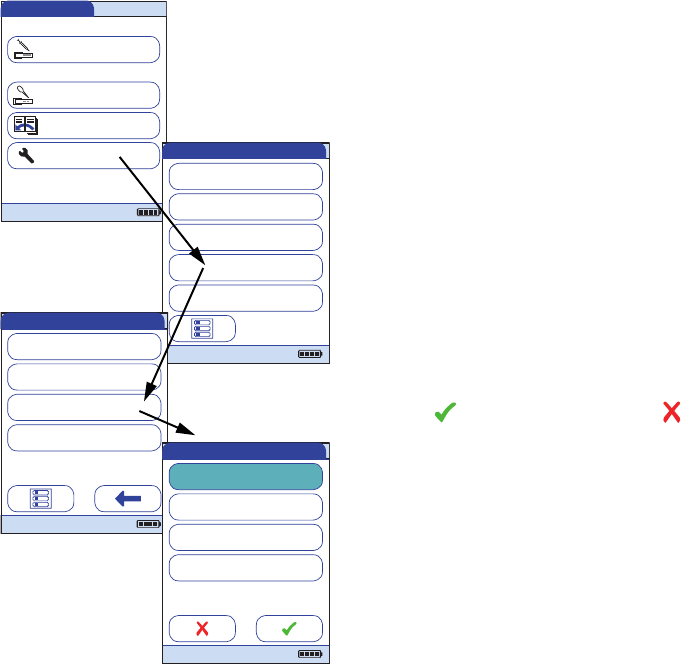
Meter Setup
106
Cleaning lockout
Under normal handling conditions, your meter will not be exposed to significant dirt or contami-
nation. However, circumstances might require regular checks of the test strip guide and (when
necessary) cleaning of the meter. The Cleaning Lockout allows operators to specify time intervals
for cleaning.
1From the Main Menu, touch Setup to open
the meter settings.
2From the Setup menu, touch Lockout.
3From the Setup-Lockout menu, touch
Cleaning Lockout.
You may select from the following options:
■No
■Daily
■Weekly
■Monthly
4Touch the button to select the time interval
of choice. Your selection is now high-
lighted.
5Touch to save this setting, or touch
to exit this menu without saving any
changes. The display automatically returns
to the previous screen.
Main Menu
Control Test
Review Results
Setup
Patient Test
04/19/2015
09:15 am
Data Handling
ID Setup
Lockout
Basics
Optional Screens
Setup
04/19/2015
QC Settings
Cleaning Lockout
STAT Test Confi g.
Operator Lockout
Setup - Lockout
04/19/2015
Daily
Weekly
Monthly
No
Select Cleaning Lockout
04/19/2015

Meter Setup
107
STAT test configuration
Quality control tests ensure consistent quality and accurate measurements. In emergency situa-
tions, however, it may be necessary to perform a test without delay. To override an active lockout
for a test parameter, lot or operator, you can allow for STAT Tests (STAT = Short TurnAround
Time). STAT tests cannot be performed if IQC lockout is in place or a new lot has not (yet) passed
a quality control test (New Lot Lockout).
You can set a number of tests permitted beyond the lockout. Once the number of allowed STAT
Tests has been reached (for a single parameter), additional tests for this parameter are locked
until you successfully perform a quality control test.
STAT tests are labelled accordingly in the result window.
STAT Tests will be counted separately for each test parameter. Thus the actual availability of
STAT Tests may differ for each parameter.
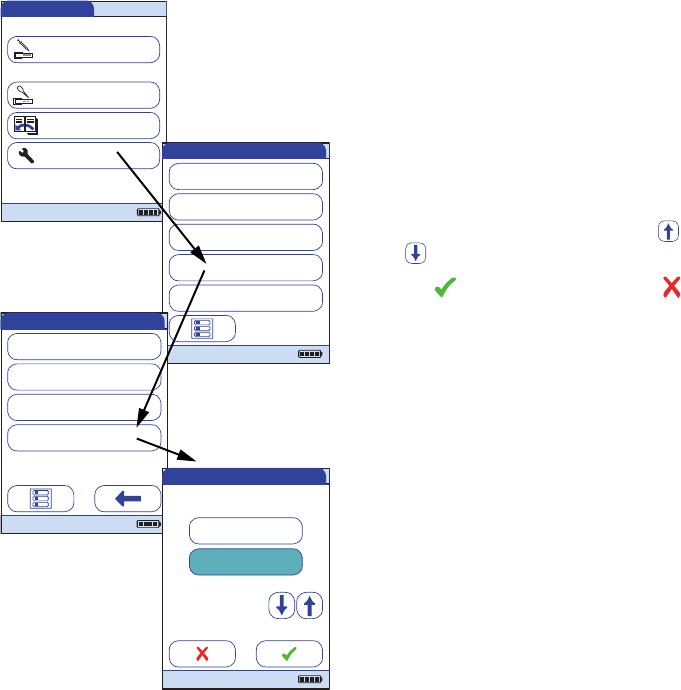
Meter Setup
108
1From the Main Menu, touch Setup to open
the meter settings.
2From the Setup menu, touch Lockout.
3From the Setup-Lockout menu, touch
STAT Test Config.
4Touch Enable to allow STAT Tests or:
Touch Disable to prohibit STAT Tests.
Your selection is now highlighted.
5If you have enabled the option, touch
or to set the number of additional tests.
6Touch to save this setting, or touch
to exit this menu without saving any
changes. The display automatically returns
to the previous screen.
Main Menu
Control Test
Review Results
Setup
Patient Test
04/19/2015
09:15 am
Data Handling
ID Setup
Lockout
Basics
Optional Screens
Setup
04/19/2015
QC Settings
Cleaning Lockout
STAT Test Confi g.
Operator Lockout
Setup - Lockout
04/19/2015
Disable
Enable
Quantity: 3
STAT Test
04/19/2015
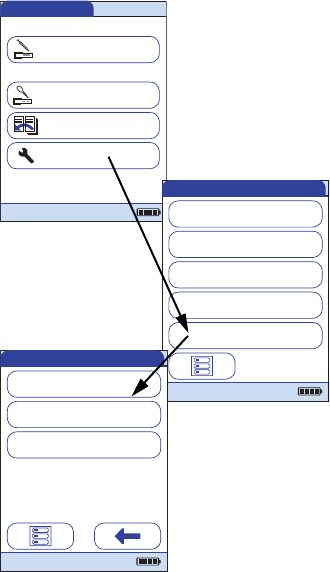
Meter Setup
109
3.5 Optional Screens setup
In this screen, you can customise display formats and test procedures. You can choose to display
additional information and select from options for managing the result display.
1From the Main Menu, touch Setup to
open the meter settings.
2From the Setup menu, touch Optional
Screens.
In this menu screen, you may select from the
following options:
■Display additional information on meter
status
■Select to display results only after new
login by operator
■Enable operators to confirm or reject test
results
Main Menu
Control Test
Review Results
Setup
Patient Test
04/19/2015
09:15 am
Data Handling
ID Setup
Lockout
Basics
Optional Screens
Setup
04/19/2015
Setup - Optional Screens
Result Login
Result Confi rmation
Start Info
04/19/2015
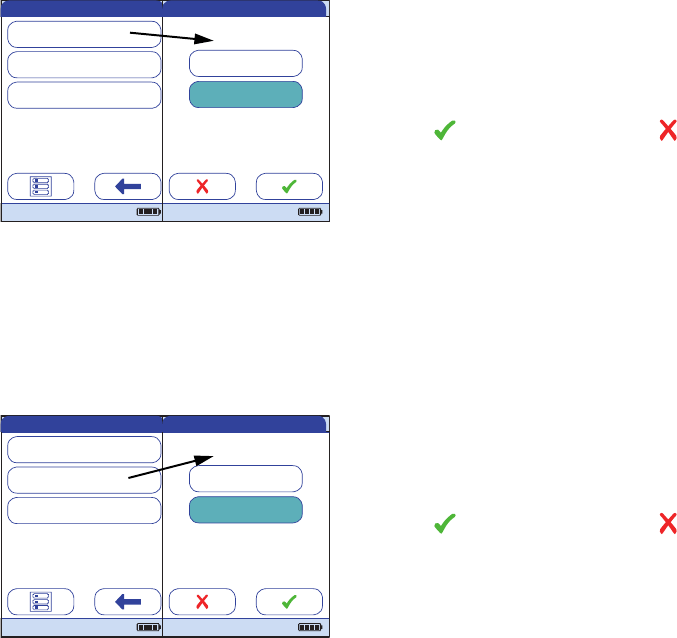
Meter Setup
110
The additional status information is displayed after powering on the meter or after logging off as
an operator. This includes information about current lockouts, the number of results not trans-
ferred (to the DMS) and the time since the last data transfer.
In environments with multiple operators, it can be useful to display a test only if the operator
carrying out the test is present. By requiring operators to login again before displaying results,
you ensure that only authorised persons view the results.
3Touch Start Info.
4Touch the button to select the state of the
status display. Your selection is now high-
lighted.
5Touch to save this setting, or touch
to exit this menu without saving any
changes.
6Touch Result Login.
7Touch the button to select the state of the
option. Your selection is now highlighted.
8Touch to save this setting, or touch
to exit this menu without saving any
changes.
Setup - Optional Screens
Result Login
Result Confi rmation
Start Info
04/19/2015
Disable
Enable
Start Info Screen
04/19/2015
Setup - Optional Screens
Result Login
Result Confi rmation
Start Info
04/19/2015
Disable
Enable
Result Login Screen
04/19/2015

Meter Setup
111
In some circumstances, it may be useful for operators to confirm the validity of their results. To do
so, an option can be enabled that prompts operators to confirm the results of every test.
9Touch Result Confirmation.
10 Touch the button to select the state of the
option. Your selection is now highlighted.
11 Touch to save this setting, or touch
to exit this menu without saving any
changes.
Setup - Optional Screens
Result Login
Result Confi rmation
Start Info
04/19/2015
Disable
Enable
Res. Confi rmation Screen
04/19/2015
Meter Setup
112
This page intentionally left blank.

Performing a Test
113
4 Performing a Test
What you need:
■Suitable blood sampling system to collect venous whole blood
■cobas h 232 meter
■Roche CARDIAC test strips for the desired test, with the supplied code chip
■Roche CARDIAC pipettes (or other suitable pipettes with pipetting volume of 150 L) for
applying the sample to the test strip
Always …
■… operate the meter according to the specified operating conditions (see page 177).
■… follow the information on correct handling of test strips in the package insert.
■… place the meter on a level, vibration-free surface when applying the sample to the sample
application area of the test strip. Once the sample has been completely absorbed by the
test strip, you can move the meter.
■… keep the meter clean. See “Maintenance and Care” on page 165.
Only heparinized blood collection tubes are allowed. Refer to test strip package insert.
The Roche CARDIAC family includes several strips. Always ensure that the disposables you
are using (e.g., test strips) are intended for use with the cobas h 232 meter. Some tests might
require a minimum software version. Ensure that the software version on the cobas h 232
meter is compatible with the test you are running (refer to the corresponding package insert
for details). Contact your Roche representative if the cobas h 232 meter requires a software
update.

Performing a Test
114
Never …
■…use Roche CARDIAC pipettes for collecting blood from the patient.
■…touch or remove the test strip during a test.
■… add more blood after the test has begun.
■… remove or insert the code chip while the meter is performing a test.
■… move or pick up the meter while applying the sample - wait until the necessary sample
has been absorbed completely by the test strip.
■… store the meter at extreme temperatures.
■… store the meter in damp or humid conditions without protection.
■… store the meter in a dusty environment witout protection.
CAUTION
Accuracy/precision of measured results:
Failure to comply with the above may lead to inaccurate results. An incor-
rect result may lead to an error in diagnosis, therefore posing danger to
the patient.
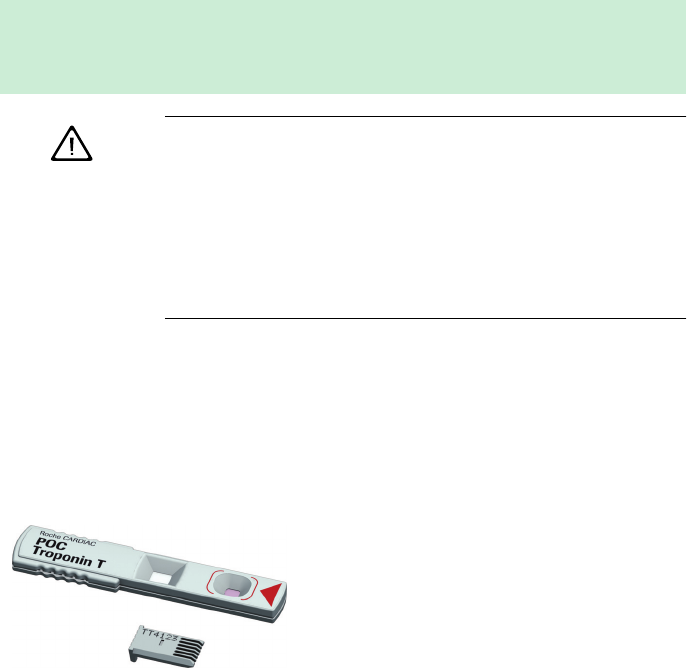
Performing a Test
115
Sample material
Heparinized venous whole blood is used as sample material. For each test use exactly 150 L
of sample.
Use a suitable sampling system to collect the blood sample. Use only heparinized blood collec-
tion tubes. Do not use blood collection tubes containing EDTA, citrate, sodium fluoride or other
additives. For details refer to the test strip package insert.
4.1 Preparing to test
IMPORTANT NOTE: Never use Roche CARDIAC pipettes for blood sampling directly from the
vein nor for administering injections. They are not sterile-packaged and do not contain anti-
coagulants. Roche CARDIAC pipettes are intended only for drawing the sample from the blood
collection tube and applying it to the test strip. See page 129.
■Observe the applicable regulations and directives for hygiene and
safety when collecting blood samples.
■Observe the applicable regulations and directives for disposing of
potentially infectious samples and materials.
■Dispose of used consumables in line with the disposal policy of your
hospital, institute or medical practice.
■See safety message “Protection against infection and blood-borne
pathogens” on page 15.
1Prepare the required test strips (shown
here: Roche CARDIAC POC for testing
Troponin T).
2Make sure that the code chip supplied
with these test strips is also at hand.
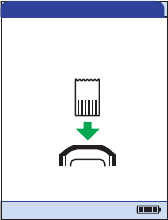
Performing a Test
116
Code chip
The code chip provides the meter with important information on the manufacturer-specific
parameters of the respective test strip lots. It contains information about the test method, the lot
number and the expiration date.
■Each test strip box contains its own code
chip. Make sure you have the code chip at
hand before performing the first test with
a new test strip lot.
■When you insert a test strip from a new lot
for the first time, the meter prompts you to
insert the corresponding code chip. At
this point, compare the code number you
see on the display with the number that is
printed on the test strip package you are
using. If the two code numbers are identi-
cal, insert the new code chip into the slot
in the meter.
■Once inserted, the code chip information
is read and stored on the meter. The meter
can store up to 200 code chip datasets
(100 test strip lots and 100 quality control
lots). Further tests using the same strip lot
can be performed without inserting the
code chip again.
■The code chip is no longer required, once
the data is stored. You may leave it in the
meter, or you can use it with other meters
using the same test strip lot.
Pat. Test - Ins. Chip
Insert Code
Chip
proBNPPar:
04/19/2015
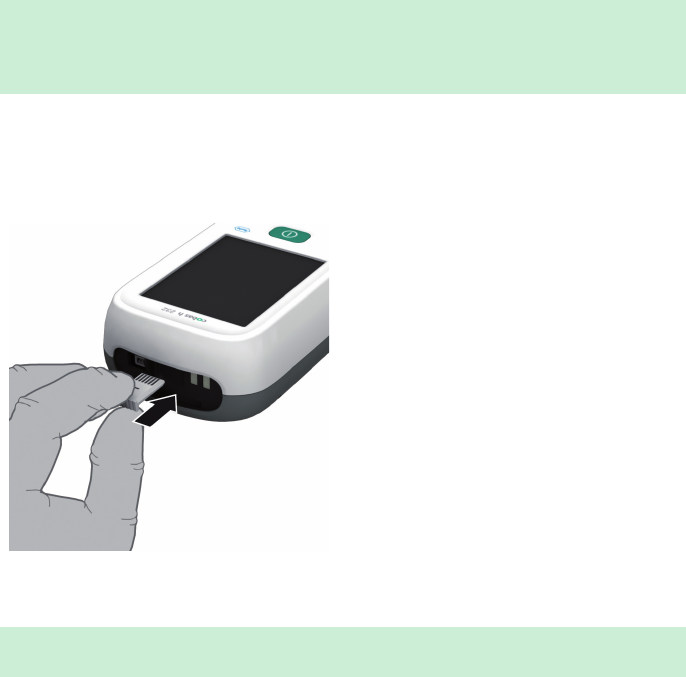
Performing a Test
117
Inserting the code chip
Roche recommends keeping the code chip in the meter to protect the contacts from becoming
dirty.
Protect the code chip from moisture and equipment which produces magnetic fields and
electrostatic discharges.
Once the test strip lot is used up, dispose of the old code chip
promptly to prevent mix-ups.
1Remove the old code chip, if one is
inserted in the meter.
2Always make sure that the number on the
code chip matches the number on the
label of the test strip package.
By scanning the barcode on the strip, the
meter gathers information about the
number of the required code chip.
3Slide the new code chip into the slot on
the top of the meter as shown until you
feel it snaps into place.
If the code chip does not match the test strip lot, is missing or incorrectly inserted, an error
message appears in the display (see “Troubleshooting” starting on page 173).
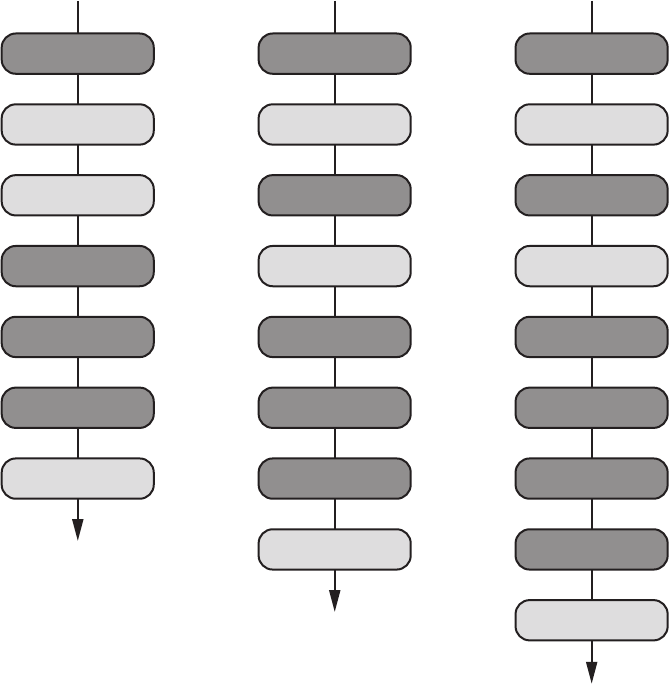
Performing a Test
118
Test steps (overview)
The following illustration shows the steps performed during testing. The steps you actively per-
form are displayed with a dark background. Depending on the configuration, the individual steps
shown here may include additional actions (e.g., entering a password). Some steps may be dif-
ferent, working with or without Operator IDs and Patient IDs. On the following pages these steps
are explained separately for each configuration.
1 Without operator and patient lists (or both operator and patient ID disabled)
2 With operator list (or operator ID enabled)
3 With operator and patient list (or operator and patient ID enabled)
Powering on
Self-check
Main menu
Patient test
Test strip
Sample
Result
Powering on
Self-check
Main menu
Log in/list
Patient test
Test strip
Sample
Result
Powering on
123
Self-check
Main menu
Log in/list
Patient test
Patient ID/list
Test strip
Sample
Result
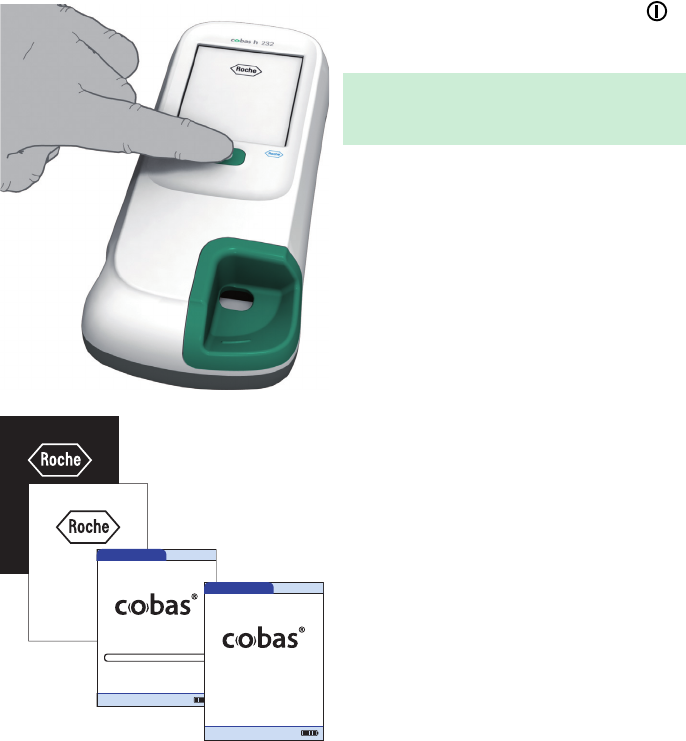
Performing a Test
119
Powering on the meter
1Power the meter on by pressing the
button for approximately 1 second.
You can also power on the meter directly by
connecting the power adapter or by placing
the meter on the Handheld Base Unit.
The meter performs a self-check at
startup.
Self-Check
Performing self-checks...
04/19/2015
09:15 am
SW Version: 04.00.00
Self-Check
Self-checks complete.
09:15 am
04/19/2015
SW Version: 04.00.00
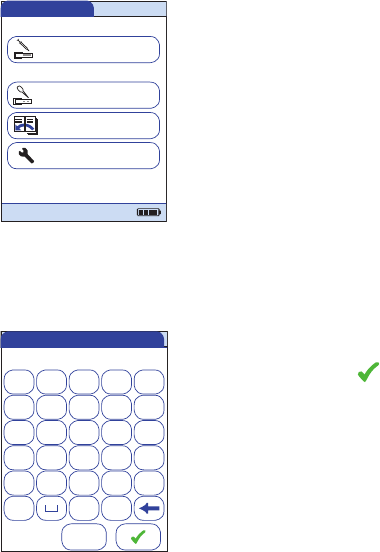
Performing a Test
120
Logging in
The initial steps until the Main Menu is displayed depend on the configuration and are performed
as follows:
Without operator login required
With operator login (no operator list)
2Wait until the main menu is displayed.
2Enter or scan your Operator ID.
3Touch to confirm your entry.
4Wait until the main menu is displayed.
Main Menu
Control Test
Review Results
Setup
Patient Test
04/19/2015
09:15 am
A
SC123
BCDE
FGHI J
KLMNO
PQRST
U VWX Y
Z , 123
Operator ID
Scan
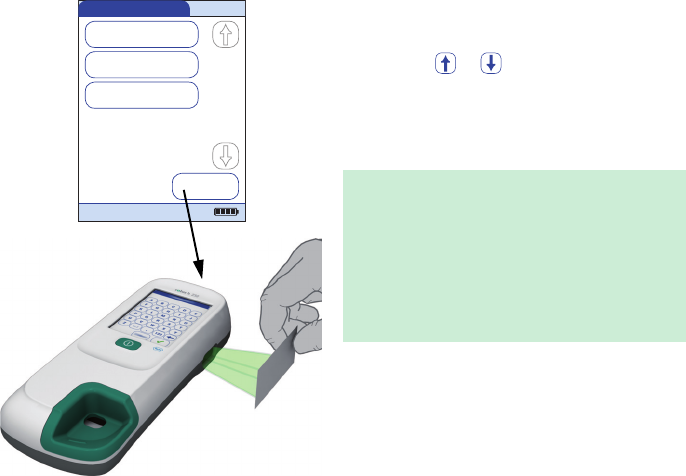
Performing a Test
121
With operator login (list available)
2If an operator list exists, wait until this list
is displayed.
3Touch or to scroll through the list.
Select the operator of choice by touching
the corresponding button.
As an alternative (meters with a scanner), the
operator login can be performed via the built-
in barcode scanner. Touch Scan and hold the
card with the barcode approx. 10-20 cm
(4-8 in) from the scanner.
It is not possible to connect an external bar-
code scanner to the meter.
OP003
Hall, Molly-Jessica
OP001
Hughes, Adam
OP002
Patel, Alfi e-Adam
Select Operator ID
Scan
09:15 am
04/19/2015
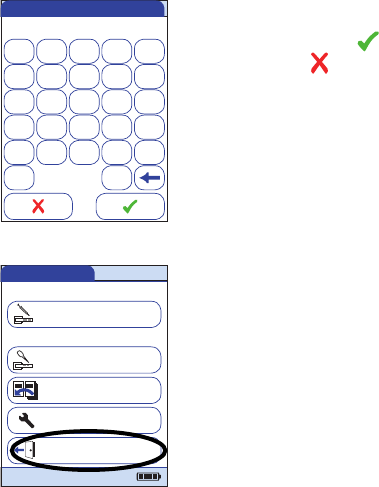
Performing a Test
122
4Enter the password.
5Touch to confirm your entry, or touch
to display the operator list again.
6Wait until the main menu is displayed.
When the tests are completed or another
operator wants to perform additional
tests, touch Logout to log out. The meter
returns to the display of the operator list.
ABCDE
FGHI J
KLMNO
PQRST
U VWX Y
Z 123
Password
****|
Main Menu
Control Test
Review Results
Setup
Patient Test
Logout
09:15 am
04/19/2015
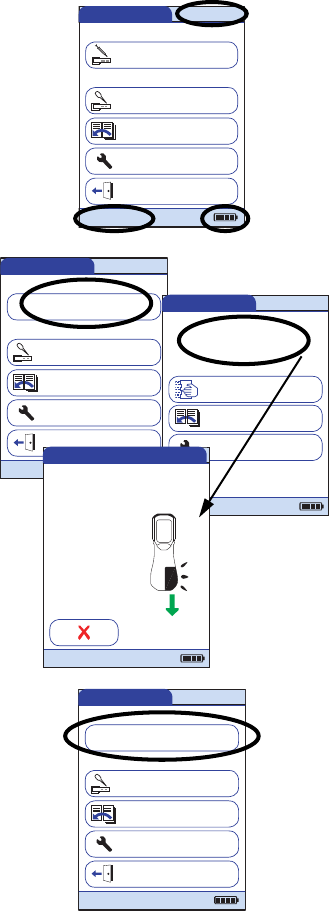
Performing a Test
123
4.2 Performing a test
1Check the charge level of the battery
pack. If there are no bars left in the battery
icon, you cannot perform any more tests.
2Check that the date and time are correct.
Correct any incorrect settings as
described in the chapter entitled “Meter
Setup/Setting the date”.
If a QC lockout is displayed instead of Patient
Test, you must run a quality control test
before you can perform a test (see “Control
Testing and Quality Control” starting on
page 137). If the meter is locked, a test can
only be performed as a STAT test (if this func-
tion is enabled and if there are still STAT tests
available).
If a Cleaning Lockout is displayed instead of
Patient Test, you must touch Cleaning and
follow the instructions on the screen and
clean the meter. See “Maintenance and Care”
beginning on page 165. Once you have re-
attached the test strip guide cover and pow-
ered the meter on again, the meter is no
longer locked.
If the Patient Test button is available, but a
lockout is displayed, you must first perform a
quality control test for certain test parameters.
Other test parameters are not affected.
Main Menu
Control Test
Review Results
Setup
Patient Test
09:15 am
04/19/2015
Logout
Main Menu
Control Test
Review Results
Setup
QC Lockout
Logout
09:15 am
04/19/2015
Main Menu
Cleaning Lockout
Cleaning
Review Results
Setup
09:15 am
04/19/2015
Clean Meter
Remove Cover
04/19/2015
Main Menu
Control Test
Review Results
Setup
Patient Test
Logout
QC!
09:15 am
04/19/2015
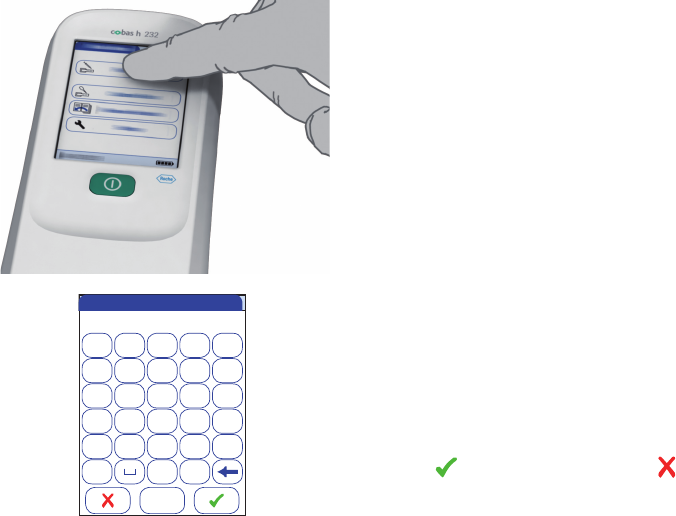
Performing a Test
124
Without patient list
3Touch Patient Test.
4If you selected the Patient ID as optional,
you can enter or scan a Patient ID.
If you selected the Patient ID as required,
you must enter or scan the Patient ID.
If you selected no Patient ID (None), the
meter automatically proceeds to the next
step.
5Touch to confirm the ID, or touch
to cancel the ID entry.
Continue reading on page 127.
A
PID111SCHULZM457
BCDE
FGHI J
KLMNO
PQRST
U VWX Y
Z , 123
Patient ID
Scan
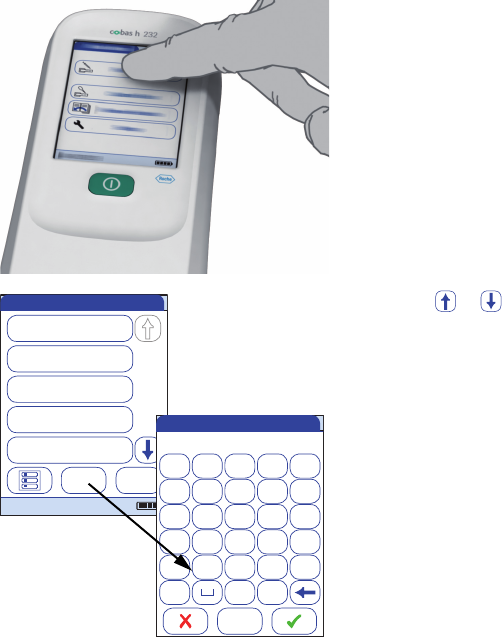
Performing a Test
125
With patient list
3Touch Patient Test.
Patient lists can only be created on a DMS
and must be transferred to the meter. Lists
cannot be created on the meter.
4Touch or to scroll through the list.
Select the patient to be tested by touching
the corresponding button.
5If the patient is not in the list, touch New
to create a new entry. You must now enter
a Patient ID manually or scan it using the
barcode scanner.
Select Patient ID
New
PID001GERTA123
Anders, Gert
PID001CHAPLINC123
Chaplin, Charlene
PID001BERNDH123
Bernd, Hans
PID001FRENZENA12
Frenzen, Alice
PID230ONEALJ1234
ONeal, John
Scan
04/19/2015
A
PID111SCHULZM457
BCDE
FGHI J
KLMNO
PQRST
U VWX Y
Z , 123
Patient ID
Scan
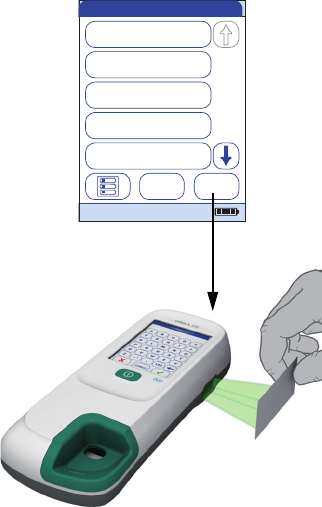
Performing a Test
126
The Patient ID can also be entered via bar-
code (meters with a barcode scanner only).
Touch Scan and hold either
■a card with the barcode approx. 10 cm
from the scanner or
■the meter over a patient bracelet.
The scanner is also active, once you open the
Enter Patient ID screen using the New button
(for approx. 10 seconds).
Select Patient ID
New
PID001GERTA123
Anders, Gert
PID001CHAPLINC123
Chaplin, Charlene
PID001BERNDH123
Bernd, Hans
PID001FRENZENA12
Frenzen, Alice
PID230ONEALJ1234
ONeal, John
Scan
04/19/2015
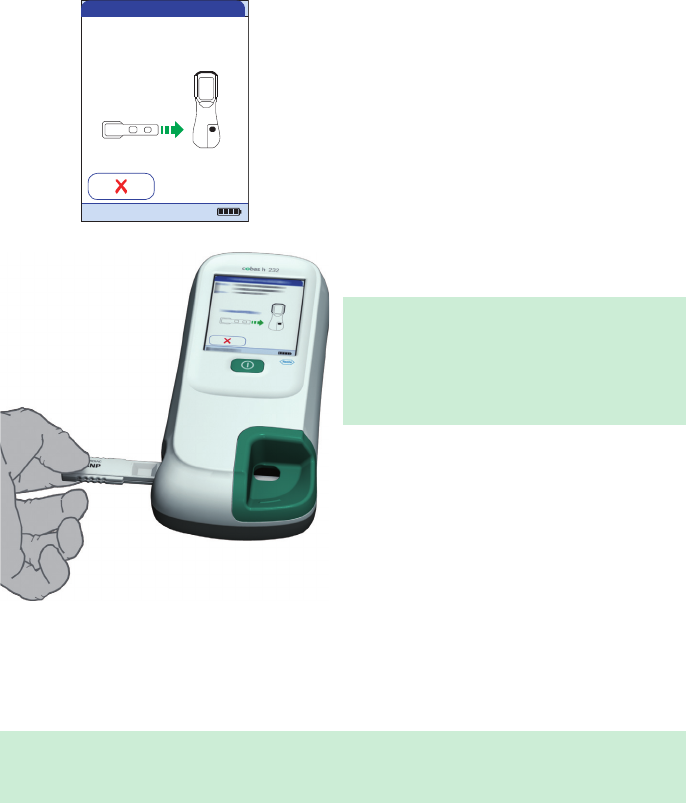
Performing a Test
127
Inserting a test strip
1The test strip icon prompts you to insert a
test strip. Remove the test strip from its
foil pouch.
2Hold the test strip so that the application
area and test area are facing up.
3Hold the test strip straight and flat. Insert
it in the test strip guide of the meter. Be
careful that the strip is not shifted, angled
or tilt during insertion. It is also important
that you insert the test strip using one
smooth movement.
Inserting the test strip too slowly or too fast
can cause a barcode reading error.
Slide the test strip in as far as it will go. A beep
tone indicates that the meter has detected the
test strip (provided the beeper is enabled).
Exposure to external influences (e.g., humidity) may deteriorate the test strips and may lead to
error messages! Remove the test strip from its foil pouch only when you are ready to perform
a test.
Pat. Test - Ins. Strip
Insert Strip
JONES, TOMOp:
PID111SCHULZM457
SCHULZ, MANFRED
Pat:
04/19/2015
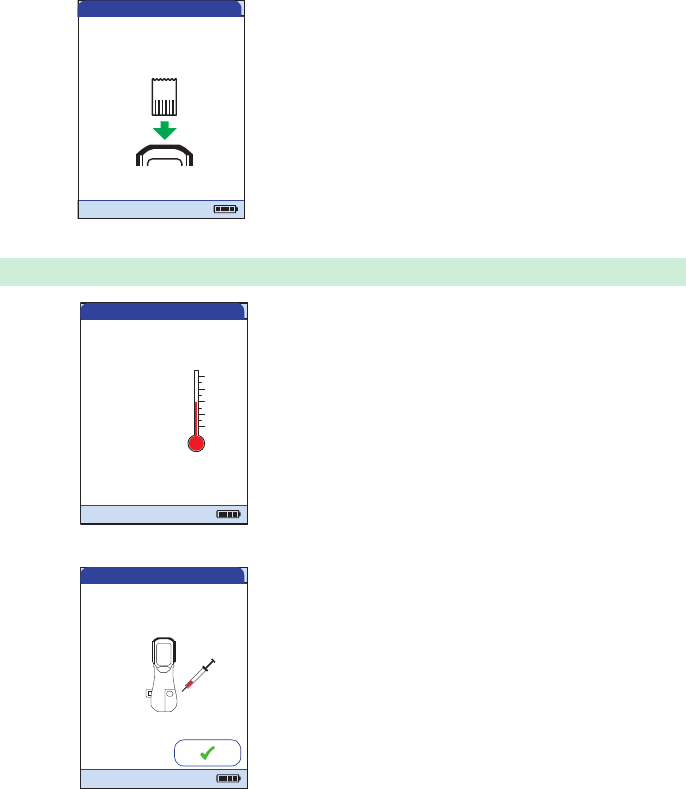
Performing a Test
128
If you use a new test strip lot, you must insert
the corresponding code chip once.
See “Code chip” on page 116.
Depending on the meter setting, you may also
be required to run a quality control test at this
point.
The meter identifies the required code chip
based on the test strip barcode and displays
the code number.
For each test parameter and each new test strip lot a different code key number is displayed.
The thermometer icon shows that the test
strip is warming up. A beep tone indicates
when the warming-up process is complete
(provided the beeper is enabled).
The pipette icon indicates that the meter is
ready to perform the test and is waiting for
blood to be applied.
Simultaneously, a 5-minute countdown
begins. You must apply the sample within this
time. Otherwise you will receive an error
message (after the sample detection has
timed out). The test strip is now unusable,
repeat the test with a new test strip.
In case of errors, see “Troubleshooting” on
page 173.
Pat. Test - Ins. Chip
Insert Code
Chip
proBNPPar:
04/19/2015
Pat. Test - Warming Up
Please Wait
Warming Up
PID111SCHULZM457
SCHULZ, MANFRED
JONES, TOM
Pat:
Op:
proBNPPar: PB1234Code:
04/19/2015
Pat. Test - App. Sample
Apply
Sample
4:10
PID111SCHULZM457
SCHULZ, MANFRED
JONES, TOM
Pat:
Op:
proBNPPar:
Min
150 µL
PB1234Code:
04/19/2015
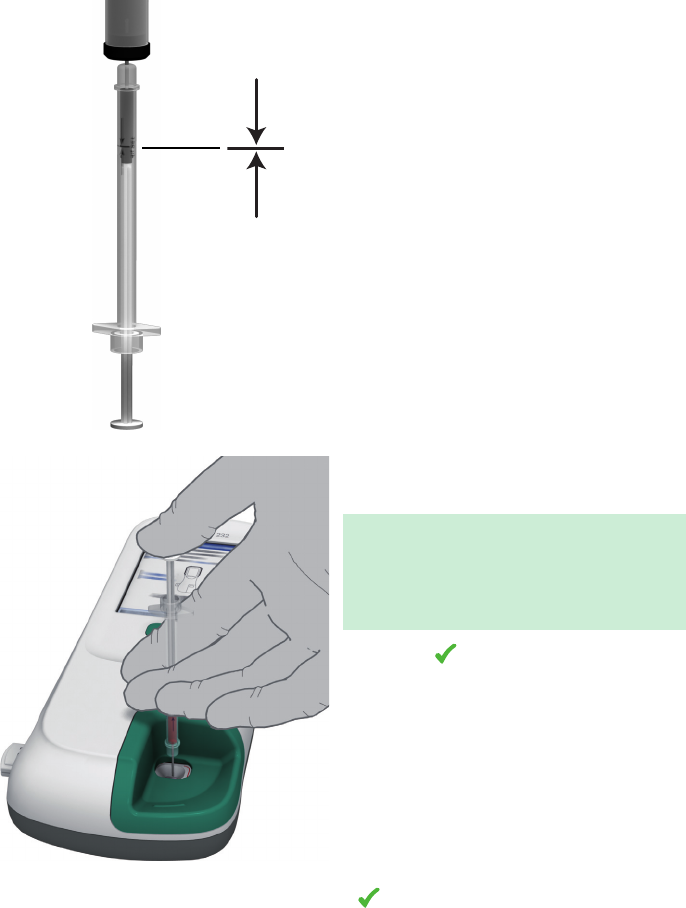
Performing a Test
129
4Using the Roche CARDIAC pipette, draw
exactly 150 L (to the blue mark on the
pipette) heparinized blood from the blood
collection tube. Make sure the sample
contains no air bubbles.
5Apply the entire sample to the sample
application area of the test strip.
Always place the meter on a level, vibration-
free surface when applying the sample to the
sample application area of the test strip. Once
the sample has been completely absorbed by
the test strip, you can move the meter.
6Touch to confirm that the sample has
been applied.
The hourglass icon appears as the meter
begins to process the sample. For better
control over the measurement process, you
should always confirm this yourself, instead of
waiting for the meter to detect the sample.
After you confirm that the sample has been
applied, or if the meter automatically recog-
nises that the sample has been applied, the
button disappears.
150 µL
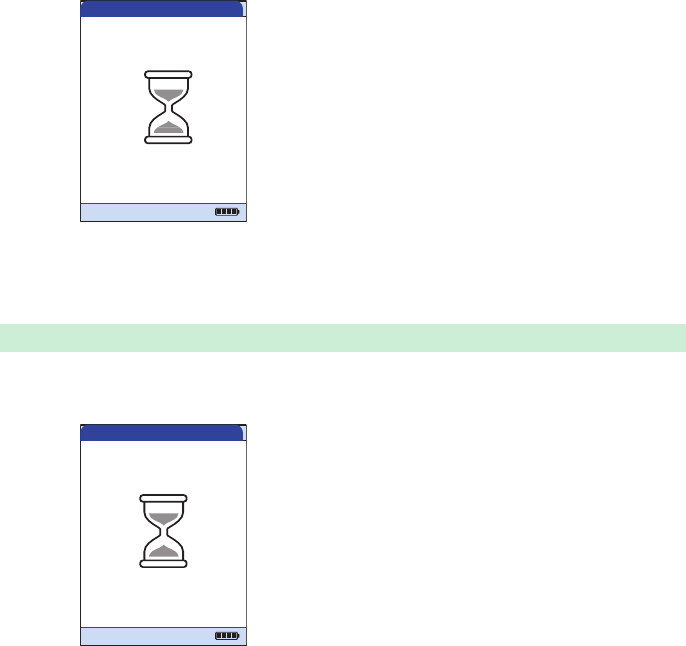
Performing a Test
130
The hourglass icon spins until the sample has
been detected and the test begins. The time
remaining for the test is displayed.
Measurement time:
The time needed to run a test depends on the
test parameter (refer to package insert for
details). Typically, 8 to 12 minutes are
required.
Do not add more blood. Do not touch the test strip until the result is displayed.
For Troponin T only:
As soon as the meter detects a signal (this
may take a few minutes), a qualitative result
(TnT Elevated) appears under the hourglass
icon (see illustration).
The quantitative result is displayed when the
test is completed. Refer to the Roche
CARDIAC T Quantitative or Roche CARDIAC
POC package insert for more details.
Pat. Test - Measuring
proBNP PB1234
JONES, TOM
Par:
Op:
Code:
SCHULZ, MANFREDPat:
10:20 Min
04/19/2015
Pat. Test - Measuring
Trop T TT 2721
JONES, TOM
Par:
Op:
Code:
SCHULZ, MANFREDPat:
10:20 Min
TnT Elevated
04/19/2015
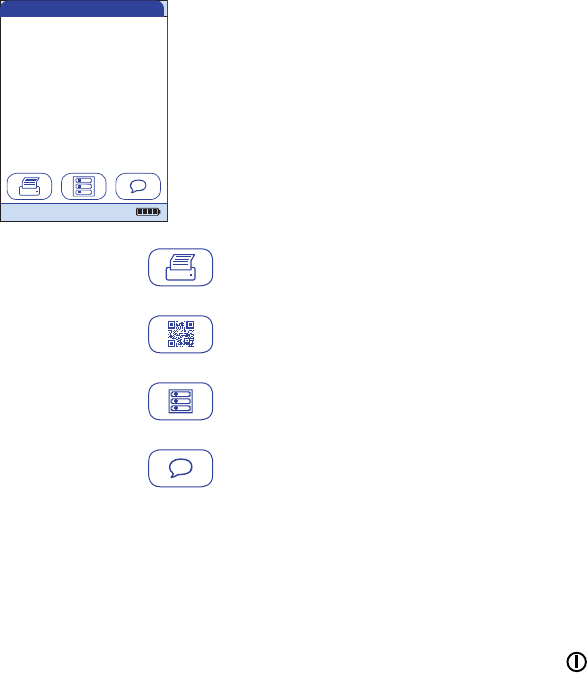
Performing a Test
131
The test result is shown and stored automati-
cally.
When interpreting your result, please read the
test strip package insert carefully.
Print button:
Print results (infrared interface)
QR Code button:
Display result as QR code
Menu button:
Return to main menu
Comment button:
Add predefined or custom comments to the
test result
7Remove the test strip from the meter.
8Power the meter off by pressing the
button for approximately 1 second if you
do not wish to perform any further tests.
9Discard the used disposable item and test
strip in compliance with the disposal policy
of your hospital or medical practice.
10 Clean the meter if necessary. See “Main-
tenance and Care” on page 165).
Pat. Test - Result
620 pg/ml
proBNP PB1234
SCHULZ, MANFRED
JONES, TOM
Par:
Op:
Code:
PID111SCHULZM457Pat:
04/19/2015
01/25/2015 10:17

Performing a Test
132
Displaying, confirming or adding comments to results
As described in the chapter “Optional Screens setup” starting on page 109, there are many
options for displaying results that can be activated:
If a new Operator Login is required to display
the result:
1Touch the button for Operator Login.
2Log in as described on page 121.
The result is now displayed.
Pat. Test - Op. Login
Measurement Complete
proBNP PB1234
SCHULZ, MANFRED
JONES, TOM
Par:
Op:
Code:
PID111SCHULZM457Pat:
04/19/2015

Performing a Test
133
If the test result requires a confirmation:
■When the result is displayed, touch the
button to select the confirmation of
choice.
You can choose to either
■Reject
■Accept
If you reject the result, the result value is no
longer displayed. However, the test entry is
stored.
Pat. Test - Confi rm.
620
01/25/2015 10:17
pg/ml
proBNP PB1234
SCHULZ, MANFRED
JONES, TOM
Par:
Op:
Code:
PID111SCHULZM457Pat:
Measurement OK?
Reject Accept
04/19/2015
Pat. Test - Result
Rejected
01/25/2015 10:17
proBNP PB1234
SCHULZ, MANFRED
JONES, TOM
Par:
Op:
Code:
PID111SCHULZM457Pat:
04/19/2015
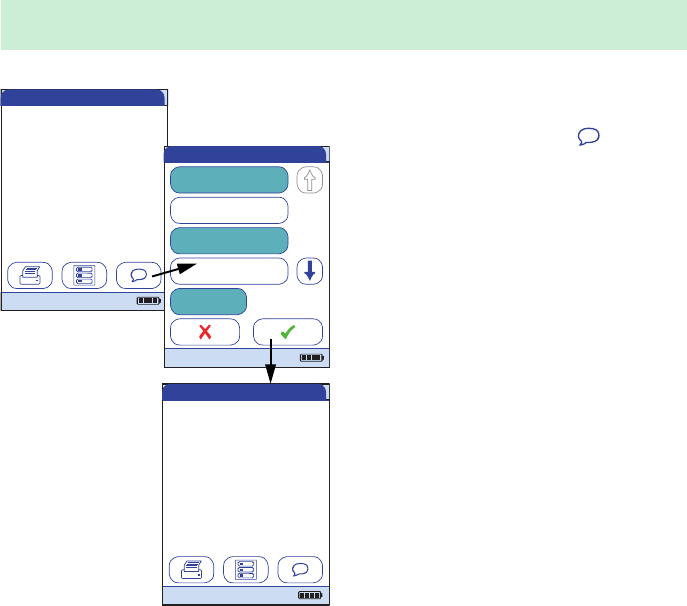
Performing a Test
134
You can add up to three comments to a test result. Comments can provide, for example, addi-
tional information about the test conditions or the patient. A comment may be up to 20 charac-
ters in length. You can open the function for adding comments directly in the results screen.
If you want to add a comment, do not remove the test strip. Once the strip is removed, the
meter automatically returns to Main Menu and a comment can no longer be added.
If you want to add a comment to a test result:
1In the result screen, touch .
2Select a predefined comment from the list
and/or
3Touch Custom to enter your own com-
ment using the onscreen keypad.
The comments are stored with the test result.
Pat. Test - Result
620 pg/ml
proBNP PB1234
SCHULZ, MANFRED
JONES, TOM
Par:
Op:
Code:
PID111SCHULZM457Pat:
04/19/2015
01/25/2015 10:17
Pat. Test - Comment
Asymptomatic
Chest Pain
Dyspnea
Symptomatic
Custom
04/19/2015
Pat. Test - Result
620
01/25/2015 10:17
pg/ml
Trop T TT 2721
User1
Par:
Op:
Code:
TESTERPat:
Test
Symptomatic
Chest Pain
04/19/2015

Performing a Test
135
Displaying the test result as QR code
The QR code button only appears if the QR code display function is activated (see
page 65 and following). Otherwise it is not displayed.
1 Touch to display the result as QR
code.
2 Touch to return to the standard
result display.
The size of the QR code displayed on the
screen varies according to the amount of data
encoded.
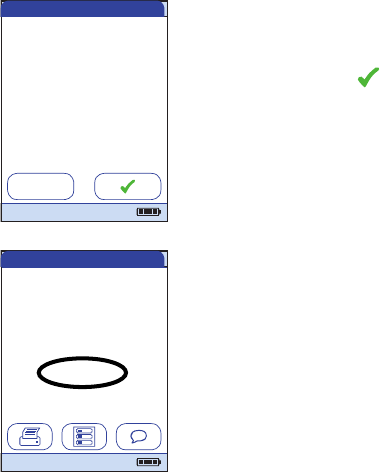
Performing a Test
136
STAT tests
STAT tests are a limited number of tests that can be performed in emergency situations, see
page 107. If the meter is configured to perform STAT tests, you have the option of performing a
test by choosing STAT even though a QC Lockout is in place.
1To perform the measurement without
performing a quality control test, touch
STAT, or:
2Touch to perform the quality control
test before the measurement.
When a STAT test is performed, this infor-
mation is stored with the result. The
number of permissible STAT tests is
reduced by 1. After all pending quality
control tests are performed, the specified
number of STAT tests is available again in
case of a new lockout.
Pat. Test - Lockout
Test Parameter Locked!
Please Perform QC.
PID111SCHULZM457
SCHULZ, MANFRED
JONES, TOM
Pat:
Op:
proBNPPar:
STAT
PB1234Code:
04/19/2015
Pat. Test - Result
620 pg/ml
proBNP PB1234
SCHULZ, MANFRED
JONES, TOM
Par:
Op:
Code:
PID111SCHULZM457Pat:
STAT Test
04/19/2015
01/25/2015 10:17
Control Testing and Quality Control
137
5 Control Testing and Quality Control
The cobas h 232 POC system employs several methods to check that the meter and test strips
are working properly and that the operator is performing the test correctly.
The meter has a number of built-in quality control functions:
■A self-check of the electronic components and functions every time the meter is powered
on.
■A check of test temperature when warming up and during the test.
■A check of the expiration date and lot information on the test strip using the information
from the code chip.
In addition, the cobas h 232 POC system provides:
■Configurable, prescribed quality control tests using Roche CARDIAC IQC test strips for
internal functionality tests.
■Definable, prescribed control tests using Roche CARDIAC Control materials for the avail-
able test parameters.
5.1 Preparing to run a quality control test
Prepare for a quality control test in the same way you would prepare to perform a test with a
patient sample. The only difference is the use of control solution instead of blood.
To perform a quality control test using control solutions, you need:
■cobas h 232 meter
■Test strips for the desired tests, with the supplied code chip
■Roche CARDIAC pipettes (or other suitable pipettes with pipetting volume of 150 L)
■Control set containing two vials of Roche CARDIAC Control material and code chip

Control Testing and Quality Control
138
You can specify the frequency of quality control tests according to your own requirements (see
“Meter Setup/Lockout setup” starting on page 94).
If you encounter a lockout for a test strip lot that no longer exists, see “Reset test parameters” on
page 105. Please note that, when you use this method, all saved test parameters and QC lock-
outs will be deleted.
Always refer to the package insert provided with the control material for
specific handling and testing instructions.
Reconstituted control material taken from the refrigerator must be allowed to reach room
temperature before use.
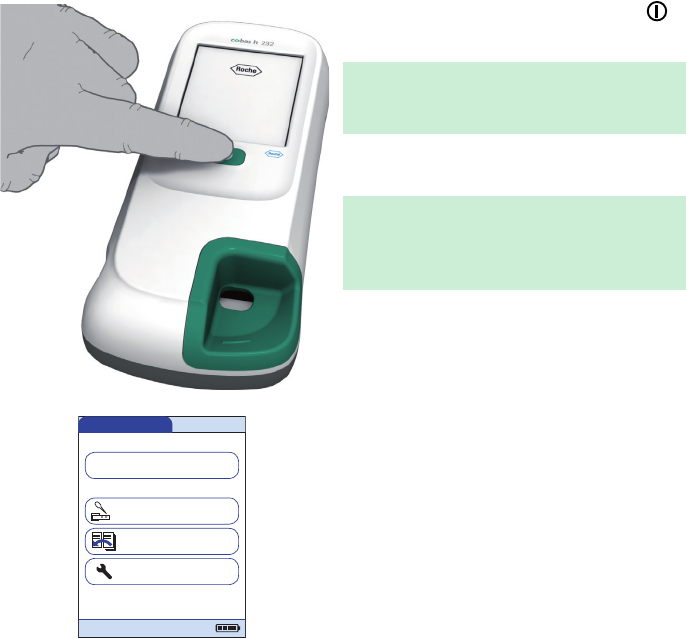
Control Testing and Quality Control
139
5.2 Performing a quality control test
Quality control (QC)
1Power the meter on by pressing the
button for approximately 1 second.
You can also power on the meter directly by
connecting the power adapter or by placing
the meter on the Handheld Base Unit.
Depending on the system settings the opera-
tor my have to log in and/or enter a password.
Follow the procedures as described on
page 121.
2Wait until the main menu is displayed.
Main Menu
Control Test
Review Results
Setup
Patient TestQC!
09:15 am
04/19/2015
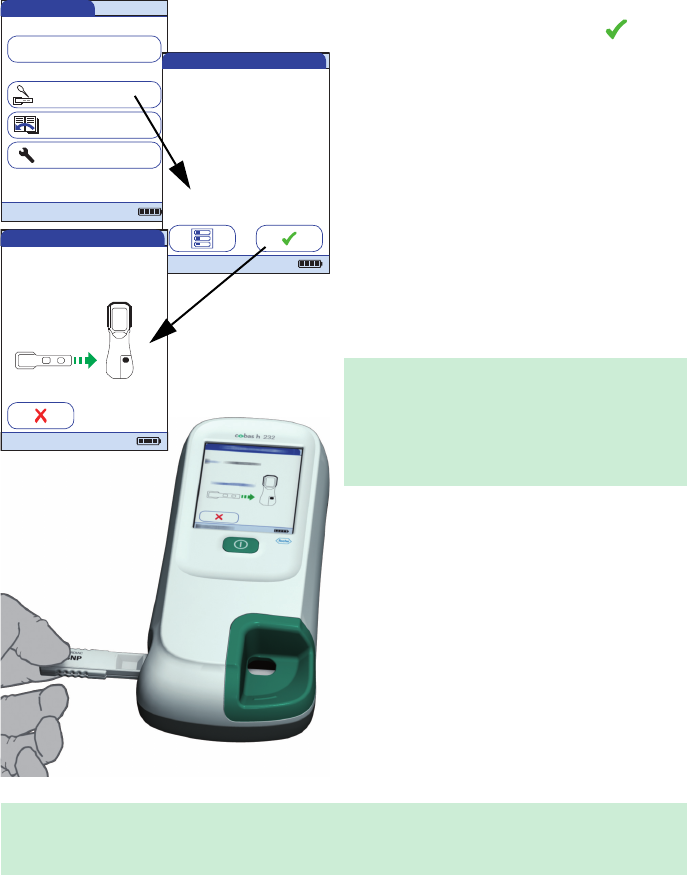
Control Testing and Quality Control
140
3Touch Control Test.
4In the QC Status screen, touch to con-
tinue with the quality control test.
5The test strip icon now prompts you to
insert a test strip. Remove the test strip
from its foil pouch.
6Hold the test strip so that the application
area and test area are facing up.
7Hold the test strip straight and flat. Insert
it in the test strip guide of the meter. Be
careful that the strip is not shifted, angled
or tilt during insertion. It is also important
that you insert the test strip using one
smooth movement.
Inserting the test strip too slowly or too fast
can cause a barcode reading error.
Slide the test strip in as far as it will go. A beep
tone indicates that the meter has detected the
test strip (provided the beeper is enabled).
Exposure to external influences (e.g., humidity) may deteriorate the test strips and may lead to
error messages! Remove the test strip from its foil pouch only when you are ready to perform
a test.
Main Menu
Control Test
Review Results
Setup
Patient TestQC!
09:15 am
04/19/2015
QC Test - QC Status
CK-MB
QC Status
Myo
DDimer
- Pass
- Pass
- Pass
Trop T
proBNP
- Locked
- Locked
04/19/2015
QC Test - Ins. Strip
Insert Strip
JONES, TOMOp:
04/19/2015
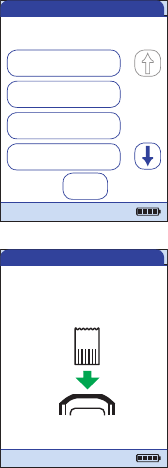
Control Testing and Quality Control
141
If you use a new test strip lot and have not
inserted the code chip yet, you must do so
now. Otherwise you cannot perform a quality
control test.
As with the test strips, a code chip is also pro-
vided with the control materials. The informa-
tion on the code chip is stored in the memory
so you can use the same control materials
again at any time.
8Select the code stored for your current
control material, or touch New to use a
new control material.
If you are using a new control material,
remove the code chip from the meter and
insert the code chip that came with the
control material instead.
QC Test - Sel. QC Lot
pro BNP PB1234
JONES,TOM
Par:
Op:
Code:
New
Code PBC014
Code PBC016
Code PBC017
Code PBC018
04/19/2015
QC Test - Ins. Chip
Insert Code
Chip
PBC014
proBNP PB1234
PBC014
JONES, TOM
Par:
Op:
Code:
QC:
04/19/2015
QC

Control Testing and Quality Control
142
9If the control material box contains more
than one level, select the level of choice
for this measurement.
The thermometer icon shows that the test
strip is warming up. A beep tone indicates
when the warming-up process is complete
(provided the beeper is enabled).
The pipette icon indicates that the meter is
ready to perform the test and is waiting for the
sample to be applied.
Simultaneously, a 5-minute countdown
begins. You must apply the sample within this
time, otherwise you will receive an error
message (after the sample detection has
timed out).
In case of errors, see “Troubleshooting” on
page 173.
QC Test - Sel. QC Level
Level 2
Level 1
proBNP PB1234
PBC014
JONES, TOM
Par:
Op:
Code:
QC:
04/19/2015
QC Test - Warming Up
Level: 1
proBNP, PB1234
PBC014
JONES, TOM
Par:
Op:
Code:
QC:
04/19/2015
Please Wait
Warming Up
QC Test - App. QC
Apply QC
Min
150 µL
Level: 1
proBNP PB1234
PBC014
JONES, TOM
Par:
Op:
Code:
QC:
4:10
04/19/2015
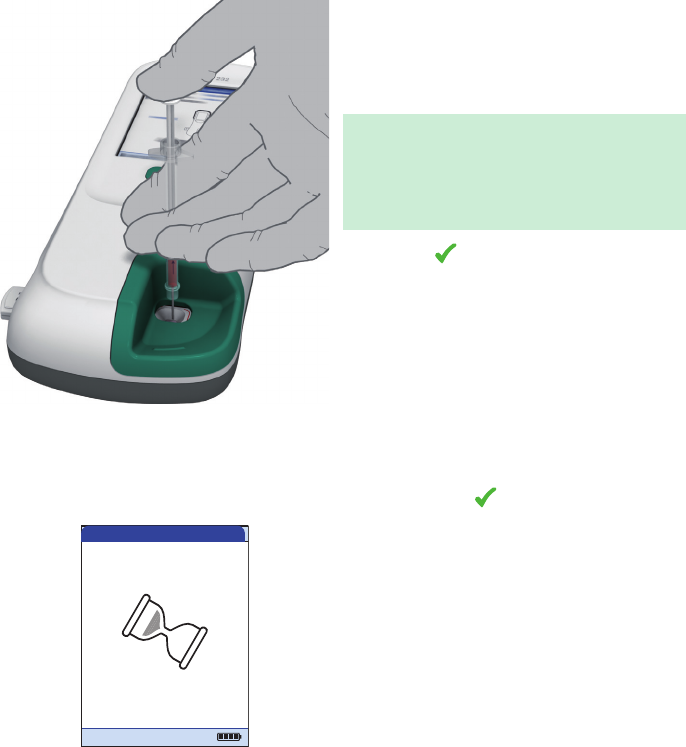
Control Testing and Quality Control
143
10 Using the pipette, draw up the dissolved
contents of the vial.
11 Apply the sample (exactly 150 L) to the
application area of the test strip.
Always place the meter on a level, vibration-
free surface when applying the sample to the
sample application area of the test strip. Once
the sample has been completely absorbed by
the test strip, you can move the meter.
12 Touch to confirm that the sample has
been applied.
The hourglass icon appears as the meter
begins to process the sample. For better
control over the measurement process, you
should always confirm this yourself, instead
of waiting for the meter to detect the sample.
13 After you confirm that the sample has
been applied, or if the meter automatically
recognises that the sample has been
applied, the button disappears.
The hourglass icon spins until the sample has
been detected and the test begins.
Unlike regular tests, this procedure can be
very short and therefore might not be dis-
played (especially in case of a lack of or delay
in confirmation, see step 12).
QC Test - Processing
Processing...
Level:
proBNP PB1234
PBC014
JONES, TOM
Par:
Op:
Code:
QC: 1
04/19/2015
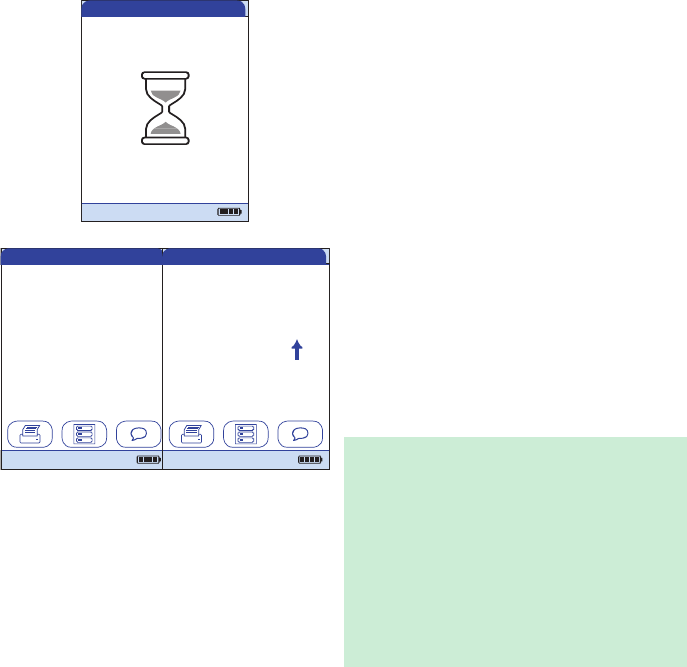
Control Testing and Quality Control
144
The time remaining for the test is displayed.
Measurement time:
The time needed to run a test depends on the
test parameter (refer to package insert for
details). Typically, 8 to 12 minutes are
required.
The result of this quality control test is dis-
played and is automatically saved to memory.
The target value and the range in which the
results for this control material should be
located is displayed below the current result.
If a quality control test fails, an up arrow (too
high) or down arrow (too low) is displayed.
There are three options for displaying a QC
test result:
• Pass/Fail
• Value
• Value & Pass/Fail
For details refer to “QC result format” on
page 102 and “Settings summary” on
page 47.
QC Test - Measuring
10:20 Min
Level:
proBNP PB1234
PBC014
JONES, TOM
Par:
Op:
Code:
QC: 1
04/19/2015
QC Test - Result
329
01/25/2015 10:17
pg/ml
(350 / 300-400 pg/ml)
Level:
proBNP PB1234
PBC014
JONES, TOM
Par:
Op:
Code:
QC: 1
Pass:
04/19/2015
QC Test - Result
01/25/2015 10:17
(350 / 300-400 pg/ml)
Level:
proBNP PB1234
PBC014
JONES, TOM
Par:
Op:
Code:
QC: 1
04/19/2015
Fail: 490 pg/ml
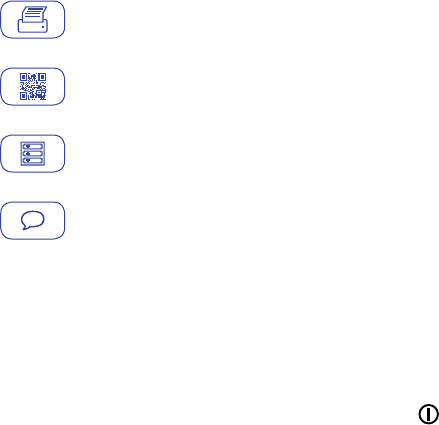
Control Testing and Quality Control
145
Print button:
Print results (infrared interface)
QR Code button:
Display result as QR code
Menu button:
Return to main menu
Comment button:
Add predefined or custom comments to the
test result
14 Remove the test strip from the meter.
15 Power the meter off by pressing the
button for approximately 1 second if you
do not wish to perform any further tests.
16 Discard the used disposable item and test
strip in compliance with the disposal policy
of your hospital or medical practice.
17 Clean the meter if necessary (see “Main-
tenance and Care” on page 165).

Control Testing and Quality Control
146
Displaying the QC result as QR code
The QR code button only appears if the QR code display function is activated (see
page 65 and following). Otherwise it is not displayed.
1 Touch to display the result as QR
code.
2 Touch to return to the standard
result display.
The size of the QR code displayed on the
screen varies according to the amount of data
encoded.
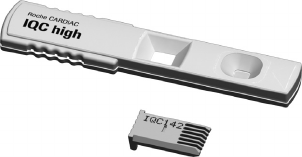
Control Testing and Quality Control
147
Instrument quality control (IQC)
The Roche CARDIAC IQC test serves as a performance check for the optical system of the
cobas h 232 POC system. The instrument determines the reflectance value of the signal and
displays “Pass”, “Fail” or the percentage of remission depending on your settings.
“Pass” means that the optical system of the cobas h 232 POC system is functioning properly. If
“Fail” appears, the measured reflectance value is outside the confidence interval.
1Prepare the required IQC test strips
(shown here: Roche CARDIAC IQC high).
2Make sure that the code chip supplied
with these test strips is also at hand.
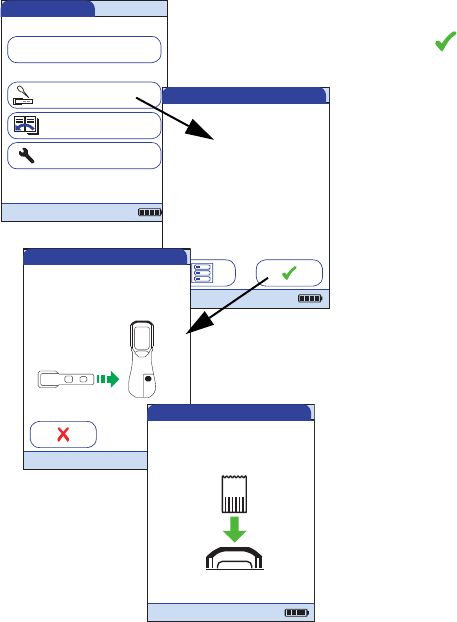
Control Testing and Quality Control
148
The first steps in this quality control test are identical to the procedure described before, see
page 139. The following description therefore starts at the main menu.
3Touch Control Test.
4Touch in the QC Status screen to con-
tinue with quality control test. The test
strip icon prompts you now to insert a test
strip.
5Remove the test strip from its IQC test
strip container.
6Insert the test strip as described before,
see page 140.
7If you are using a new lot of IQC test strips
and have not inserted the code chip yet,
you must do so now. If you have used the
test strips already, skip this step.
Main Menu
Control Test
Review Results
Setup
Patient TestQC!
09:15 am
04/19/2015
QC Test - QC Status
CK-MB
QC Status
Myo
DDimer
- Pass
- Pass
- Pass
Trop T
proBNP
- Locked
- Locked
04/19/2015
QC Test - Ins. Strip
Insert Strip
JONES, TOMOp:
04/19/2015
QC Test - Ins. Chip
IQC
JONES, TOM
Par:
Op:
Insert Code
Chip
702
04/19/2015
QC
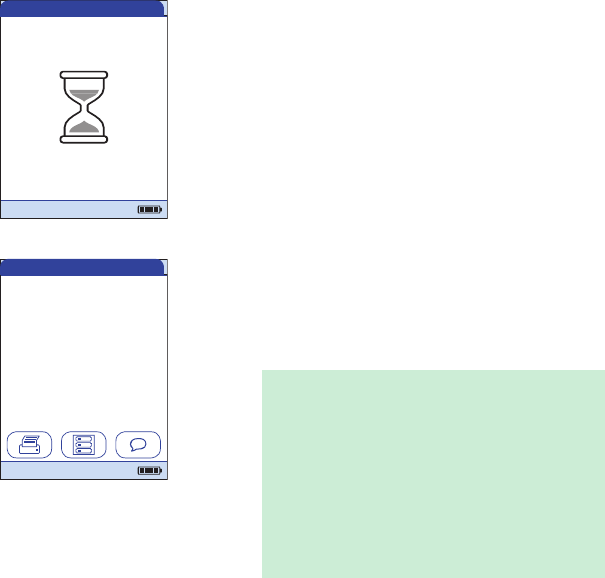
Control Testing and Quality Control
149
The hourglass icon is displayed and the (inter-
nal) measurement begins.
The result of this IQC quality control test is
displayed as Pass or Fail (default setting) or in
the format selected in the QC result format
setting.
There are three options for displaying an IQC
test result:
• Pass/Fail
• Value
• Value & Pass/Fail
For details refer to “QC result format” on
page 102 and “Settings summary” on page 47.
QC Test - Measuring
IQC IQC702Code:
JONES, TOM
Par:
Op:
Level: 1
04/19/2015
QC Test - Result
IQC Code: IQC702
JONES, TOM
Par:
Op:
11/04/2015 10:17
Level: 1
04/19/2015
83 %
(85 / 82 - 88 %)
Control Testing and Quality Control
150
This page intentionally left blank.
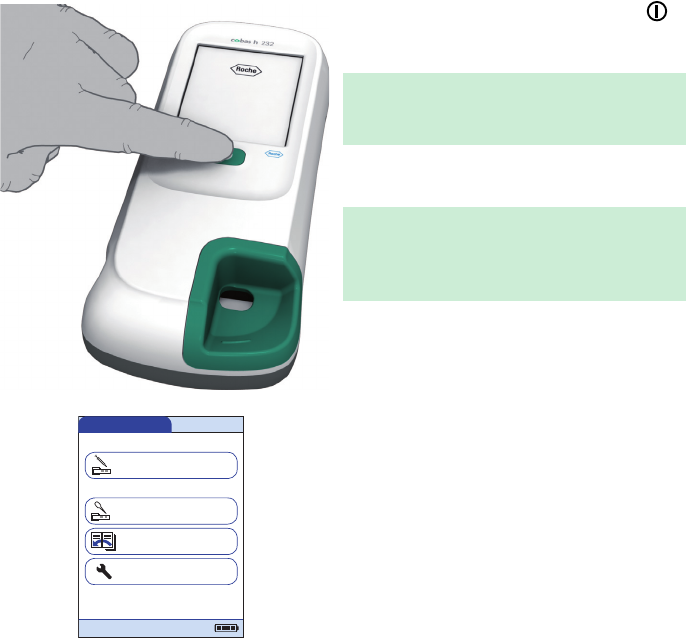
Review Results
151
6 Review Results
The cobas h 232 meter can save 2000 patient test results as well as 500 quality control tests to
memory, together with time, date, lot number and, if applicable, IDs and comments.
Reviewing test results
1Power the meter on by pressing the
button for approximately 1 second.
You can also power on the meter directly by
connecting the power adapter or by placing
the meter on the Handheld Base Unit.
Depending on the system settings the opera-
tor my have to log in and/or enter a password.
Follow the procedures as described on
page 121.
2Wait until the main menu is displayed.
Main Menu
Control Test
Review Results
Setup
Patient Test
04/19/2015
09:15 am
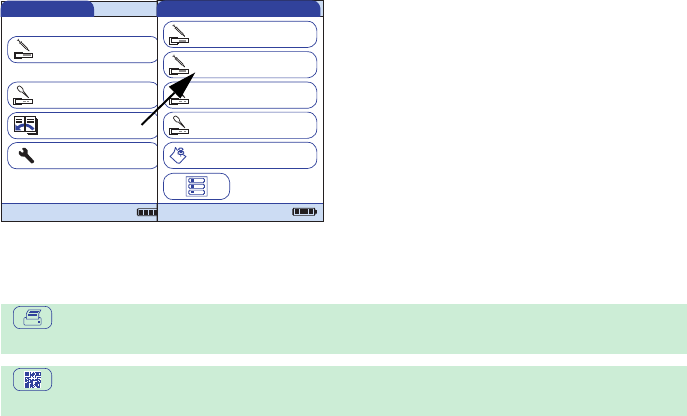
Review Results
152
From the Main Menu you have access to all stored results, sorted by selectable criteria:
■Patient History
■All Results
■QC Results (Quality Control)
■IQC Results (Instrument Quality Control)
■Maintenance History
3Touch Review Results.
4Select the function you want to perform in
the memory.
The print button only appears if the printer function is activated. Otherwise it is not dis-
played.
The QR code button only appears if the QR code display function is activated. Otherwise
it is not displayed.
Main Menu
Control Test
Review Results
Setup
Patient Test
04/19/2015
09:15 am
Review Results
All Results
QC Results
IQC Results
Patient History
Mainten. History
04/19/2015
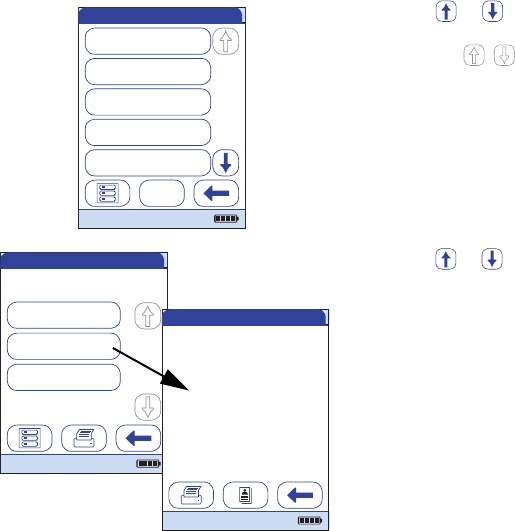
Review Results
153
Patient history
This memory area contains a list of all patients, sorted by Patient ID. From here, you can call up
results for any individual patient.
1Touch or to display the entry of
choice on the screen. If the arrow is just
an outline , you have reached the
beginning or end of the patient list.
2Touch the patient name whose results you
want to open.
3Touch or to display the test result
of choice on the screen.
4Touch the test result you would like to
view in detail.
Pat. History - Select ID
Scan
PID001GERTA123
Anders, Gert
PID001CHAPLINC123
Chaplin, Charlene
PID001BERNDH123
Bernd, Hans
PID001FRENZENA12
Frenzen, Alice
PID230ONEALJ1234
ONeal, John
04/19/2015
Single Patient Results
Pat:
proBNP 620 pg/ml
02/08/15 09:49
SCHULZ, MANFRED
PID111SCHULZM457
DDimer High
02/12/15 08:30
DDimer 1.3 µg/ml
01/21/15 09:15
04/19/2015
Pat. Test - Result
620
02/08/2015 09:49
pg/ml
proBNP PB1234
SCHULZ, MANFRED
JONES, TOM
Par:
Op:
Code:
PID111SCHULZM457Pat:
New Strip Lot
04/19/2015
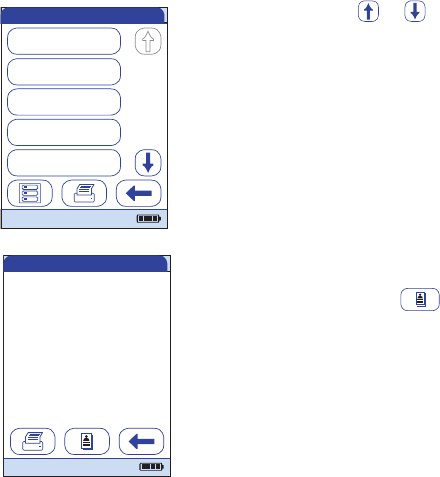
Review Results
154
All results
This memory area contains a list of all tests, sorted chronologically. From here, you can call up
results for specific times.
1Touch or to display the entry of
choice on the screen.
2Touch the patient name whose result you
want to open.
The selected test result dialog box will appear.
When you touch , a list of results for the
selected patient is displayed (see page 153).
All Results
Doe, John
02/15 10:52 Trop-T
Zend, Nora
02/15 09:40 DDimer
Smith, Adam
02/15 10:11 proBNP
Smith, Bob
02/14 11:40 Trop-T
Smithee, Aaron
02/14 10:50 proBNP
04/19/2015
Pat. Test - Result
620
02/08/2015 09:49
pg/ml
proBNP PB1234
SCHULZ, MANFRED
JONES, TOM
Par:
Op:
Code:
PID111SCHULZM457Pat:
New Strip Lot
04/19/2015
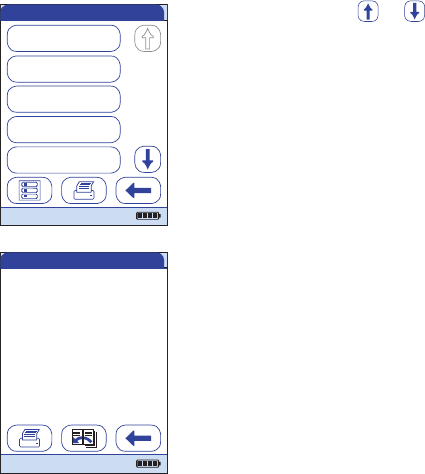
Review Results
155
Quality control (QC) results
This memory area contains all test parameter-specific quality control tests (QC, starting on
page 139) that were run, sorted chronologically. The most recent results are at the top of the list.
1Touch or to display the entry of
choice on the screen.
2Touch the entry you want to open.
The entry is displayed.
QC Results
DDimer L1
02/12/15 08:00
DDimer L2
02/12/15 08:30
proBNP L1
02/04/15 10:17
DDimer L2
01/10/15 07:30
DDimer High
01/10/15 07:05
04/19/2015
QC Result
329
04/18/2015 10:17
pg/ml
(350 / 300-400 pg/ml)
Level:
proBNP PB1234
PBC014
JONES, TOM
Par:
Op:
Code:
QC: 1
Pass:
04/19/2015
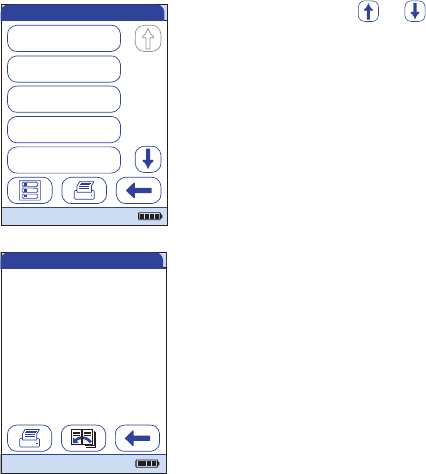
Review Results
156
Instrument quality control (IQC) results
This memory area contains all instrument quality control tests (IQC, starting on page 147) that
were run, sorted chronologically. The most recent results are at the top of the list.
1Touch or to display the entry of
choice on the screen.
2Touch the entry you want to open.
The entry is displayed.
IQC Results
IQC
04/11/15 Pass
07:59
IQC
04/07/15 Pass
08:16
IQC
04/07/15 Fail
08:01
IQC
03/29/15 Pass
08:30
IQC
03/29/15 Pass
09:02
04/19/2015
QC Test - Result
IQC Code:
JONES, TOM
Par:
Op:
02/08/2015 10:17
Level: 1
IQC702
83
%
(85 / 82 - 88 %)
04/19/2015
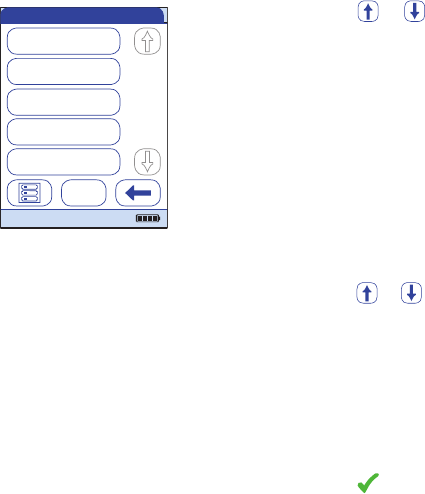
Review Results
157
Maintenance history
Maintenance History actually is a list of comments. Whenever routine maintenance or service is
done for the meter, this event can be stored in form of a comment. You may use the default
preset comments in the meter or enter a custom comment.
1Touch or to display the entry of
choice on the screen.
Once saved, a maintenance comment can not
be opened or edited. Maintenance History is
(like test results) a view-only list. You can,
however, add new entries:
2Touch New.
3Touch or to display the predefined
comment of choice on the screen.
4Touch the predefined comment you
would like to add to the Maintenance His-
tory or:
5Touch Custom to enter your own text
using the onscreen keypad.
6Touch to save your comment.
Maintenance History
Meter Cleaned
04/13/2015 08:00
Meter Cleaned
04/05/2015 08:20
Meter Cleaned
03/29/2015 09:00
New Battery Pack
03/21/2015 08:30
Meter Cleaned
03/14/2015 08:10
New
04/19/2015
Review Results
158
This page intentionally left blank.

Extended Functionalities
159
7 Extended Functionalities
Data handling
When used in conjunction either with WLAN (if the meter is equipped with WLAN) or with the
(optional) Handheld Base Unit from Roche Diagnostics, the cobas h 232 meter can conveniently
connect to a data management system (DMS). The main advantages of such a connection
between meter and DMS may include:
■Transferring patient lists, operator lists, and settings from the DMS to the meter. In this
way the setup for daily work as well as general meter setup can be performed (for one or
more meters) quickly and conveniently.
■Transferring all stored test results with the corresponding Patient ID, Operator ID, and
comments from the meter to the DMS. This transfer of data permits further evaluation or
proper archiving according to your needs.
Through the DMS the system administrator (such as the POC coordinator) may specify what set-
tings are to be applied to a set of meters within a site or unit (e.g., hospitals or wards). All meters
assigned to a specific site and/or unit would consequently share the same settings. The different
operator and patient lists (that match a site or unit) are then made available on their respective
meters. Other settings such as QC Lockout and Operator Lockout may easily be set (once) and
distributed to all meters.
Extended data handling functionality is dependent on the capabilities of the particular Data
Management System (DMS) being used and may vary.
The option of setting up an Operator Lockout is available only when operator lists are created
on the DMS, stored in the meter, and Operator login is activated. For more details on Operator
login see page 89, for details on Operator Lockout see page 95.
Extended Functionalities
160
Computer (Setup option)
For initial connection to a DMS, the ability to communicate within a network has to be set up as
follows:
■In the Setup menu, the Connection option must be set to Computer (see page 68).
■The Handheld Base Unit must be configured correctly. (For details please refer to the
manual of the Handheld Base Unit and the Technical Note stored on the Handheld Base
Unit itself.)
■Place the meter on a Handheld Base Unit that is connected to the network. The meter will
automatically be recognized by the DMS and may now be assigned to a site and/or unit
managed by the DMS (if your DMS has that functionality).
■Depending on DMS functionality available, the DMS may transfer settings and lists to the
meter as well as enable test results to be transferred from the meter to the DMS.

Extended Functionalities
161
Operator lists
After powering the meter on, an Operator login may be configured. If no list is available, the
options described on page 89 apply.
■Operator is set to Optional or Required:
The Operator can either log in via the onscreen keypad or a barcode scan. The use of the
meter is not restricted to a predefined Operator group, so Operator IDs are entered via the
onscreen keypad or read from the barcode and stored with test results for informational
purposes only.
■Operator is is set to Scan Only:
The display of the meter's onscreen keypad is blocked. The Operator can only log in via
a barcode scan as there is no onscreen keypad. The use of the meter is not restricted to
a predefined Operator group, so Operator IDs are read from the barcode and stored with
test results for informational purposes only.
Meters which are managed by a DMS may receive an Operator list.
■Operator ID is set to List, a list is available and displayed on the login screen:
The Operator selects the ID from the displayed list. If so configured by the Administrator,
the Operator may also be required to enter a password to log in.
■Operator ID is set to Hidden List:
The Operator can login via a barcode scan or the onscreen keypad. If so configured by
the Administrator, the Operator may also be required to enter a password to log in.
When working with operator lists: The use of the meter is restricted to the operators on this
list.

Extended Functionalities
162
Patient lists
When starting a Patient Test, there will be the option of either selecting a Patient ID from a
patient list, entering the Patient ID using the onscreen keypad or, if available, of scanning the
barcode with the Patient ID. The Patient ID, if entered on the DMS, comes with an additional
identification entry. Up to 20 characters can be used and assigned as a second confirmation
(e.g., name, date of birth).
There are four possible configurations for a Patient ID input:
■The Patient ID is set to Optional or Required, and there is no list available:
A Patient ID can be entered manually via the onscreen keypad or read in via a barcode
scan. The Patient ID is stored with the test result.
■The Patient ID is set to No, but there is a list available:
The list of Patient IDs is always shown when starting a test. You may now
– select a patient from the list;
– scan a Patient ID using the barcode scanner;
– create a new patient entry by touching New. Instead of an ID a consecutive number will
be assigned to this result.
■The Patient ID is set to Optional or Required, and there is a list available:
The list of Patient IDs is always shown when starting a measurement. You may now
– select a patient from the list;
– scan a Patient ID using the barcode scanner;
– create a new patient entry by touching New. You may either read the ID using the bar-
code scanner or enter a new ID via the onscreen keypad.
■The Patient ID is set to Hidden List (only possible with a data management system), and
there is a list available:
An empty list is shown when starting a measurement. You may now
– scan a Patient ID using the barcode scanner;
– create a new patient entry by touching New. You may either read the ID using the bar-
code scanner or enter a new ID via the onscreen keypad.
When working with Patient lists, you have the following options:
■A Patient ID does not have to be on the list to be scanned and used.
■The meter displays a warning that the Patient ID scanned is not on the list.
■The meter displays an error message that the ID was not found on the list of valid Patient
IDs. You must enter a valid ID to proceed.

Extended Functionalities
163
Barcode scanner
Using a DMS, the barcode scanner may be configured to accept only selected barcode symbol-
ogies. Furthermore, it is possible to define a barcode mask for Patient ID and Operator ID. With
masks being defined, the meter checks a barcode after scanning and rejects it, if it does not
match the mask. See “Example of barcode symbologies” on page 183 for further information.
Stored test results and comments
When performing a test, the test result will be stored along with additional information, including
the Patient ID, Operator ID, the kind of test performed, and optional Comments. The meter comes
with a default set of Comments that can be assigned to each test result. If you are working with
a DMS, these comments can be replaced by the comments in the DMS. The new wording will
then be available for selection from the Comments list in the meter.
Up to 3 comments can be assigned to each result.
The Comment function may be configured to be either optional, required for test results which
are out of range, or always required. If the user is required to enter/select a comment, com-
pletely empty comments will not be accepted by the meter.
Extended Functionalities
164
The default preset comments in the meter are:
Patient and QC Result comments Maintenance comments
■Symptomatic
■Asymptomatic
■Chest Pain
■Dyspnea
■Intermediate Zone
■Doctor Notified
■RN Notified
■Under Medication
■Will Repeat Test
■No Action
■New Strip Lot
■New Strip/Kit Lot
■New Lot Number
■Lab Draw
■Cleaned Meter
■Switched QC Vial
■Repeat Control Test
■Acceptable Control
■New Control Lot
■Procedure Error
■Meter Cleaned
■Samp. App. Area Cl. (Sample Application
Area Cleaned)
■Test Strip Guide Cl. (Test Strip Guide
Cleaned)
■New Battery Pack
Maintenance and Care
165
8 Maintenance and Care
8.1 Conditions for storage and shipping
Storage
■Store the system and test strips in the same environment in which they are used.
■Do not store the meter in direct sunlight or under extreme temperature conditions.
■Observe the limits for temperature and humidity when storing and using the meter (see
Chapter 10).

Maintenance and Care
166
Shipping
■If the meter is shipped or transported over long distances, always remove the battery pack
from the meter. This eliminates the possibility of the battery pack overheating due to a
short-circuit in the meter. It also prevents deep discharge and other damage to the bat-
tery pack or meter.
■Only ship undamaged battery packs. Damaged battery packs must be disposed of locally.
See page 18 for the risks associated with damaged battery packs and disposal informa-
tion.
■Package the battery pack for shipping so that it cannot move around in the packaging.
Also observe any other applicable national regulations.
■When shipping via third parties (e.g., by air or parcel service), work with the carrier to
check whether specific requirements need to be met in relation to the lithium-ion battery
packs on the basis of national or international laws on hazardous goods and, where appli-
cable, if special packaging and labeling requirements apply.
Observe the following safety information when shipping the meter and
battery pack. Failure to do so may result in injury to persons or damage
to the meter or battery pack.
For short distances - example between a facility’s sites - users may transport the battery packs
(either installed in the meter or separately) by road without having to meet further require-
ments.

Maintenance and Care
167
8.2 Cleaning and disinfecting the meter
Difference between cleaning and disinfecting
Cleaning is the physical removal of organic soiling (e.g., dirt, or other foreign material) from the
meter surface.
Disinfecting is the removal of most, but not all, disease-causing and other types of micro-
organisms (blood-borne pathogens) from the meter.
When should the meter be cleaned and disinfected?
■Clean the meter to remove visible soil and organic material for safe handling and/or prior
to disinfecting.
■You can use the Cleaning Lockout function (see page 106) to ensure regular checks are
performed.
What to clean and disinfect?
The following parts of the meter may be cleaned/disinfected:
■The visible area of the test strip guide
■The test strip guide cover
■The meter display (touchscreen)
■The meter housing (entire meter surface - front and back)
■Observe the disinfection guidelines of your institution.
■Use gloves.
NOTICE Follow the procedures below to clean/disinfect the meter. Failure to
follow these procedures may cause malfunction of the meter.
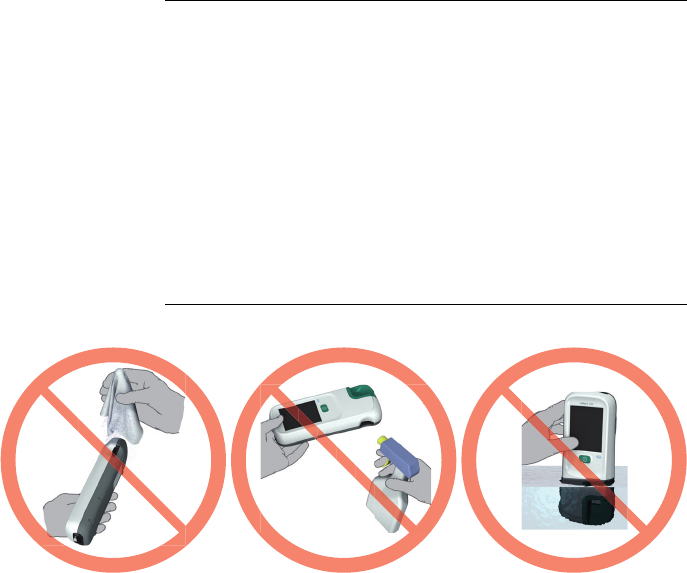
Maintenance and Care
168
NOTICE Instrument damage due to moisture
Ensure that no liquid enters the meter. If moisture enters the meter, it may
cause malfunction of the instrument.
■Make sure the meter is powered off. Unplug the power adapter.
■Do not spray anything onto the meter housing.
■Do not spray into the test strip guide.
■Do not immerse the meter in liquid.
■Use only ordinary lint-free tissues.
■Do not use cloths that are saturated. Squeeze off excess solution or
blot on a dry paper towel to remove any excess solution before wiping
the surface of the meter.

Maintenance and Care
169
Recommended cleaning/disinfecting agents
Before using a cleaning/disinfecting solution on the meter refer to the product labeling for
required contact time for cleaning/disinfecting and to ensure that the active ingredients are
acceptable for use. Prepare all solutions per the manufacturer’s product labeling.
Acceptable active ingredients are listed below.
Recommended cleaning agents
■mild soapy water
■70 % (or less) solution of isopropyl alcohol in water
■0.625 % (or less) solution of sodium hypochlorite in water (bleach)
Recommended disinfecting agents
■0.625 % (or less) solution of sodium hypochlorite in water (bleach)
■quaternary ammonium compounds up to 0.5 % (single compound or mixture) in isopropyl
alcohol (isopropanol) up to 55 %*
Cleaning/disinfecting the exterior (meter housing)
Use only the solutions recommended above.
Basic sequence of steps for cleaning
■First remove any blood and other dirt using water or soapy water.
■Then disinfect the meter's housing.
NOTICE Do not use any other disinfectants/cleaning agents on the meter
(housing or the test strip guide cover). Use of other disinfectants/
cleaning agents could result in damage to the meter.
Maintenance and Care
170
Cleaning after contamination due to mispipetting
Observe the following precautions to prevent instrument damage
■Do not move the meter to prevent liquids from creeping and penetrating the meter.
■Dab away all visible blood (also on the test strip, but not in the application area).
■Do not use the meter before the liquid/moisture has been completely removed. While it
is drying, the meter must not be moved as this may soil the optical components.
For detailed cleaning instructions (“how to clean…”) for the individual components of the meter,
see the following pages. The instructions below describe only the sequence of steps to be taken
in case of mispipetting.
■With the meter powered off, remove the test strip guide cover.
■Remove and dispose of the test strip.
■Clean the soiled parts of the meter with a moistened cotton swab/bud or tissue.
■Disinfect the meter.
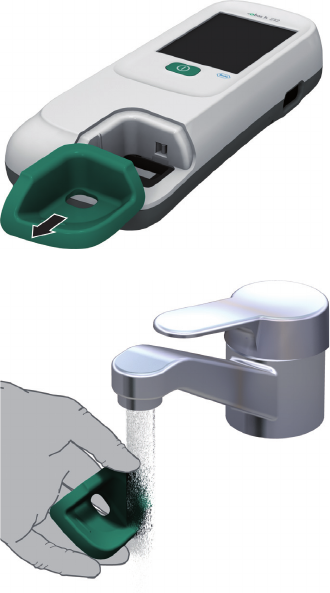
Maintenance and Care
171
Cleaning the test strip guide cover
1If required, remove the meter from the
Handheld Base Unit and place it horizon-
tally on a table.
2Remove the test strip guide cover by pull-
ing it forward horizontally (in the direction
of the arrow).
Move the cover safely away from the
meter and wipe it clean using the solu-
tions recommended above.
In case of significant soiling or contami-
nation, you can rinse the test strip guide
cover with warm water, dry it with a fresh
tissue, and then disinfect it using the solu-
tions recommended on page 169.
Always ensure that the test strip guide
cover is completely dry before re-attach-
ing it to the meter.
3Clean the outside of the meter with a
lightly moistened tissue. Then dry the
meter with a fresh tissue.
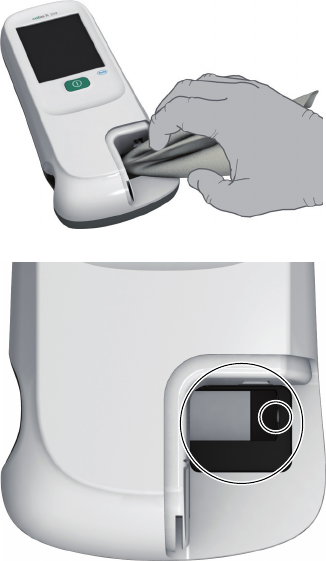
Maintenance and Care
172
Cleaning the visible area of the test strip guide
1Clean the easily accessible and visible
pipetting field area of the test strip
guide with moistened lint-free tissues.
Then dry the test strip guide with a fresh
tissue.
Adhere to the following:
■Clean only the visible area of the test
strip guide.
■Do not insert any objects into the con-
cealed areas of the test strip guide as this
will damage the optical components of
the meter.
■Do not use objects to try to scratch off any
dried contaminants in the test strip guide.
2Clean the membrane (small circle) in the
visible area at the end of the test strip
guide with a moistened tissue.
3Allow the inside of the test strip guide to
dry for about 10 minutes.
4After this time, re-attach the test strip
guide cover to the housing. Make sure
that the cover is properly attached. You
will feel it snap into place.
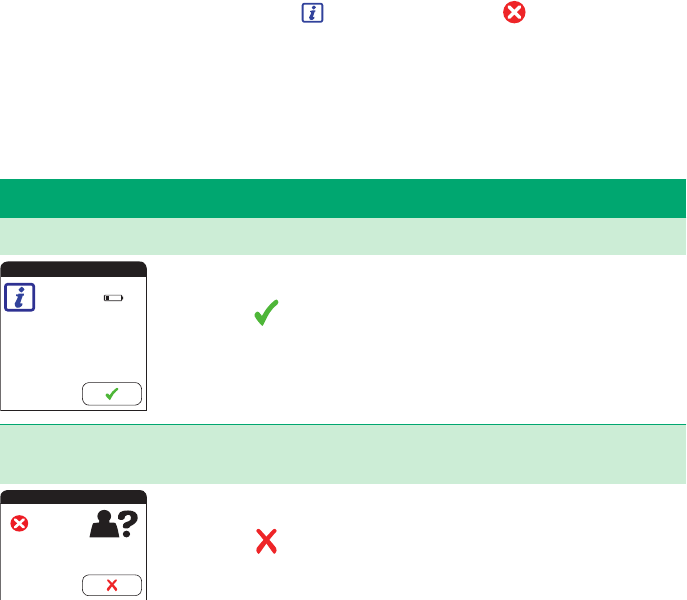
Troubleshooting
173
9 Troubleshooting
The cobas h 232 meter continually checks its systems for unexpected and unwanted conditions.
These may arise for technical reasons (defective components or consumables, environmental
factors) or due to handling and procedure errors.
Depending on the circumstances, a message may appear on the display of the meter. These
messages are marked with an icon, either for a status message, or for an error message.
All messages displayed by the system are accompanied by a description of the error and a pos-
sible solution.
Take the action suggested on screen to resolve the problem. If the error disappears, you may
continue using the meter as desired. If the problem persists, contact Roche (see page 197).
The two different message types are illustrated below:
Display/symptom Description
I-001: Battery Low
Status message
Touch to proceed with the next step.
E-101: Patient ID
Required
Error message
Touch to exit this message. Perform the suggested step(s) to
solve the problem.
Battery Low
The battery is getting low.
Replace or recharge battery
pack as soon as possible.
I-001
Patient ID Required
A patient ID is required.
Enter a valid patient ID.
E-101
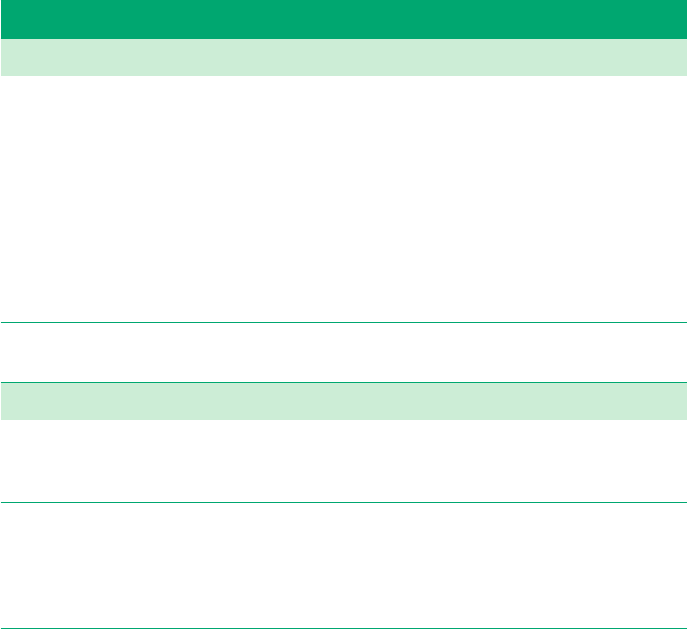
Troubleshooting
174
Errors and unusual behavior without error messages
Some conditions may arise that have no associated error or status message.
Display/symptom Description
No message or unusual behavior
Meter display does not
power on
■Wait 10 seconds and try powering on the unit again.
■Check that the meter has power.
• If you are using the external power adapter, is it connected
properly to the meter?
Or:
• Place the meter in the Handheld Base Unit.
Or:
• If you are using the Handheld Battery Pack, is it properly
installed in the meter?
Meter displays an
unexpected result
Refer to the package insert for the test strips.
Automatic shutdown
The meter powers off after a configurable time without activity (e.g.,
pressing a key, touching the screen) to conserve energy. Reactivate
the meter/screen as described in the following:
Shutdown after time spec-
ified by system administra-
tor (default is 5 minutes,
configurable by system
administrator)
■Press the On/Off button of the meter.

Troubleshooting
175
Communication Problems with the Data Management System via RF
The cobas h 232 meter is
unable to communicate
with the Data Manage-
ment System.
■Check WLAN functionality on the meter (see the Wireless
Setup screens in section “Diagnostics” starting on page 80).
■Dock the RF enabled meter into a hard-wired base unit to
transfer the data.
■Reset the meter (see page 176).
■If the error persists, contact your Roche representative.
Display/symptom Description
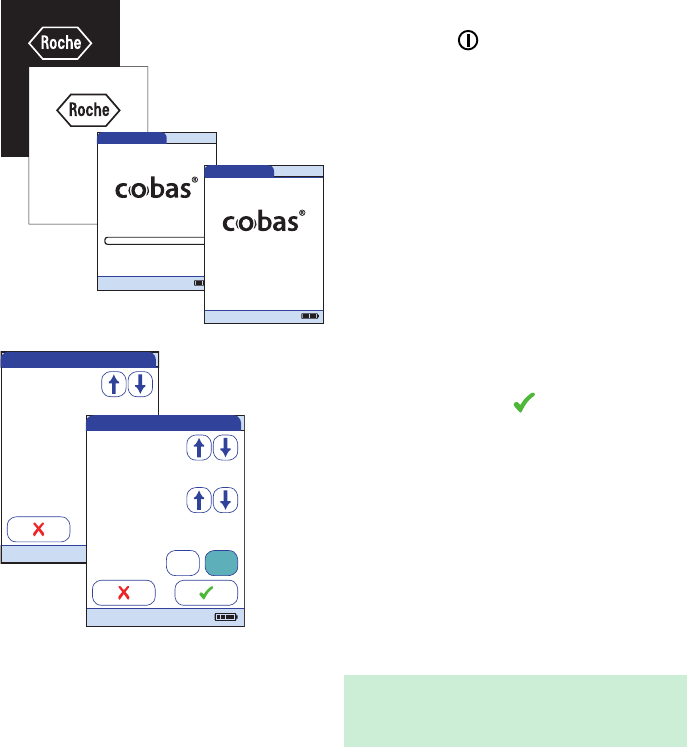
Troubleshooting
176
Meter reset
A meter reset should only be performed if all other remedies have failed.
1Place the meter on a level surface.
2Press the button for at least
12 seconds.
■The meter powers off and on again.
■The Roche logo is displayed.
If the Roche logo does not appear within
60 seconds, place the meter in the Hand-
held Base Unit for a minimum of
15 minutes to recharge the battery.
■The meter performs a system check.
■The screens for entering the date and the
time appear.
3Enter the date and time. After you have
entered the correct information, confirm
each screen with .
■Unless all lockouts are disabled (see
chapter 3.4), the meter will now be in QC
Lockout due to the manually entered
date/time.
4Synchronize the meter’s date/time with
the date/time of your facility via the Hand-
held Base Unit or, if working wirelessly,
wait at least ten minutes for the next
WLAN synchronization before performing
any further tests.
Even if your configuration does not require it,
we recommend always performing a QC test
after a meter reset.
Self-Check
Performing self-checks...
04/19/2015
09:15 am
SW Version: 04.00.00
Self-Check
Self-checks complete.
09:15 am
04/19/2015
SW Version: 04.00.00
Set Date
Month: 1
Day: 1
Year: 2015
04/19/2015
Minutes: 49
Hour: 3
Set Time
04/19/2015
AM PM
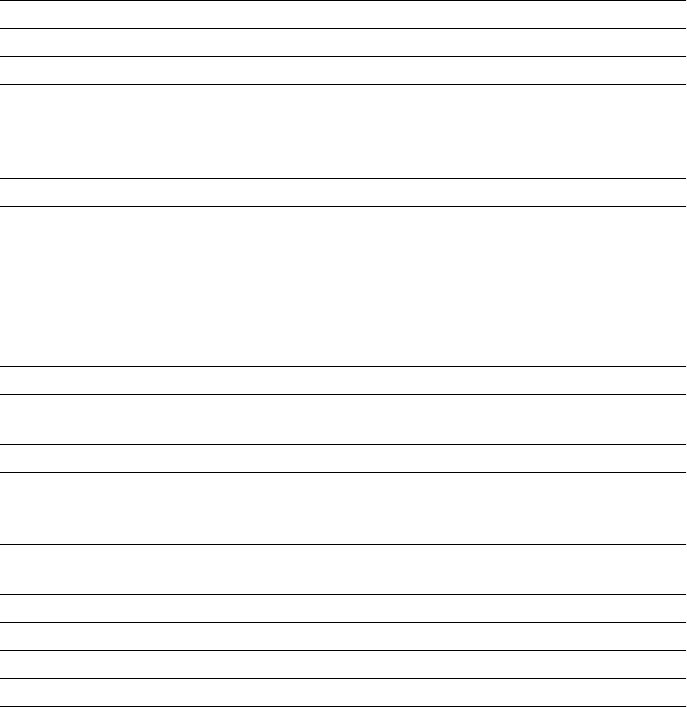
General Product Specifications
177
10 General Product Specifications
10.1 Operating conditions and technical data
Technical data
Temperature range 18-32 °C
Relative humidity 10-85% (no condensation)
Maximum altitude 4300 m
Position Always place the meter on a level, vibration-free surface when
applying the sample to the sample application area of the test
strip. Once the sample has been completely absorbed by the
test strip, you can move the meter.
Measuring range Depends on test parameters
Memory 2000 Patient Test Results
500 QC Test Results
200 IQC Test Results
100 Strip Code Chips
100 QC Code Chips
4000 Patient List entries
5000 Operator List entries
Interface Infrared interface, LED/IRED Class 1
Supported barcodes Code 128, Code 39, Code 93, EAN 13, Interleaved 2 of 5,
Codabar, QR Code, DataMatrix, PDF417, Aztec
Battery operation Handheld battery pack
Mains connection Power adapter:
Input: 100-240 V AC (± 10%) / 50-60Hz / 350-150 mA
Output: 12 V DC / 1.25A
Number of tests with fully
charged battery
approx. 10 tests
Safety class III
Automatic power-off Programmable 1 … 60 minutes
Dimensions 275 102 55 mm
Weight approx. 650 g incl. battery pack and scanner
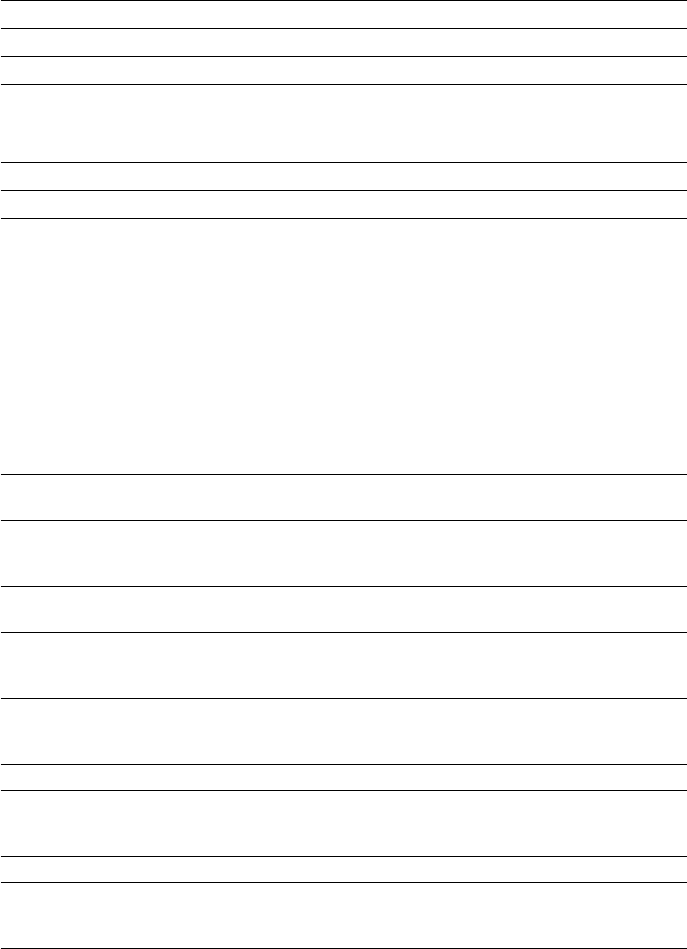
General Product Specifications
178
Sample material
Storage and transport conditions
10.2 Further information
Ordering information
Please contact your specialist supplier.
Sample type Heparinized venous whole blood
Sample size 150 L
Interactions Refer to test strip package insert
Temperature range –25 °C to +70 °C
Relative humidity 10 to 85% (no condensation)
Item Description REF
Roche CARDIAC POC Troponin T 10 tests for quantitative detection of cardiac
Troponin T
07007302190
Roche CARDIAC POC Control
Troponin T
Control set for use with Roche CARDIAC POC
(control set for 2 x 6 quality control checks, level
1/2, and code chip)
07089643190
Roche CARDIAC T Quantitative
(Troponin T)
10 tests for quantitative detection of cardiac
Troponin T
04877772190
Roche CARDIAC Control Troponin T Control set for use with Roche CARDIAC T
Quantitative (control set for 2 x 6 quality control
checks, level 1/2, and code chip)
04890515190
Roche CARDIAC Control Troponin T
(Germany only)
Control set for use with Roche CARDIAC T
Quantitative (control set for 2 x 6 quality control
checks, level 2, and code chip)
05453879190
Roche CARDIAC M 20 tests for quantitative detection of myoglobin 04877799190
Roche CARDIAC Control Myoglobin Control set for use with Roche CARDIAC M
(control set for 2 x 6 quality control checks,
level 1/2, and code chip)
04890469190
Roche CARDIAC D-Dimer 10 tests for quantitative detection of D-Dimer 04877802190
Roche CARDIAC Control D-Dimer Control set for use with Roche CARDIAC
D-Dimer (control set for 2 x 6 quality control
checks, level 1/2, and code chip)
04890523190

General Product Specifications
179
Note: Not all items are available in all countries.
Roche CARDIAC proBNP+ 10 tests for quantitative detection of NT-proBNP
(measuring range 60 - 9,000 pg/mL for meter
software version 01.04.01)
05533643190
Roche CARDIAC Control proBNP Control set for use with Roche CARDIAC proBNP+
(control set for 2 x 6 quality control checks,
level 1/2, and code chip)
04890493190
Roche CARDIAC CK-MB 10 tests for quantitative detection of CK-MB 04877900190
Roche CARDIAC Control CK-MB Control set for use with Roche CARDIAC CK-MB
(control set for 2 x 6 quality control checks,
level 1/2, and code chip)
04890426190
Roche CARDIAC IQC Set of two re-usable control strips (high/low)
including code chip. Needed for checking the
performance of the meter’s optical system
04880668190
Roche CARDIAC pipettes 20 disposable syringe pipettes (150 L) for blood
application
11622889190
Universal battery pack Rechargeable battery pack for cobas h 232
meter
04805640001
Test strip guide cover 04990315001
Battery compartment cover 04990307001
Power adapter 07006098001
Handheld Base Unit 04805658001
cobas h 232 meter Standard version without scanner 04901126190
cobas h 232 meter with
scanner Patient/Operator ID can be scanned from a
barcode
04901142190
cobas h 232 Operator’s Manual Printed manual (English) 07469101001
cobas h 232 Operator’s Manual Printed manual (German) 07532920001
cobas h 232 Manual CD Contains Operator’s Manuals and Quick Refer-
ence Guides in all available languages (PDF)
07469314001
Printer cobas h 232 (CMP-10)
ROW
for most North American, Latin American and
Asian countries
05404495001
Printer cobas h 232 (CMP-10)
EMEA
for most European, Middle East and African
countries
05404517001
Printer cobas h 232 (CMP-10)
JAP
for Japan 05404509001
Normal thermal paper roll 5 rolls per package, 50 mm diameter 03666751001
Thermal paper roll (self-adhesive) 10 rolls per package, 50 mm diameter 05412951001
Item Description REF
Warranty
180
Product limitations
Please read the information in the package insert supplied with the test strips for detailed
product data and limitations.
Information about software licenses
This product incorporates software modules developed under open source licenses. The source
code of this software can be requested on a standard data exchange medium from the manufac-
turer at the following address:
Roche Diagnostics GmbH
Sandhofer Str. 116
68305 Mannheim, Germany
The General Public License (GPL) licensing conditions are available (in English only for legal rea-
sons) as a text file (file name “License_txt.PDF”) on the CD supplied with this manual. The com-
plete license agreements are also stored as a text file (file name “license.txt”) on the Handheld
Base Unit. You can access this file by connecting the base unit to a PC with the USB cable. For
detailed instructions on how to do this, see the Operator's Manual of the Handheld Base Unit.
Everyone is permitted to copy and distribute verbatim copies of this license document, but
changing it is not allowed.
Repairs
Please note that repairs and other modifications to the meter may only be performed by persons
authorized by Roche.
11 Warranty
The statutory guarantee provisions on rights in consumer goods sales in the country of purchase
shall apply.

181
A Appendix
A.1 Working with barcodes
To reduce the probability of the barcode being misread, it is strongly recommended that you use
the configuration options for patient and/or operator ID validation as applicable to your specific
workflow. These options are:
■check ID against list or
■check ID for length1
■check if the scanned bar code type is allowed and activated in the DMS
■use barcodes with check digits
In combination with the above options or as a single measure, use an appropriate barcode mask
if this is compatible with the structure of your barcode content.
Always make sure that the entire barcode is covered by the green light frame when scanning.
WARNING
Risk of barcode read errors
If a barcode is read incorrectly, this may lead to patient misidentification
and therefore to inappropriate therapy decisions.
When creating patient or operator barcodes, always adhere to the
applicable international IEC/ISO standards for the respective barcode
symbology. In particular, ensure that barcode size and print quality (as
defined in ISO/IEC 15416 and 15415) are adequate. Inadequate print size
and/or quality may lead to erroneous decoding. In addition every user
must carry out a plausibility check on all data scanned into and displayed
by the instrument.
1. If no operator/patient list can be used, it is recommended that you at least set a minimum length for
the respective ID, even if your facility uses IDs of varying length.

182
A.2 Operator and patient ID barcode masks
Barcode mask character Definition
A-Z, 0-9 If not preceded by the Caret (“^”), the scan data character must be the
same as the mask character. This character is not saved as part of the ID. If
the characters are not the same, the scan data is not a valid ID.
Dollar (“$”) The scan data character in this position is kept as part of the ID.
Asterisk (“*“) The scan data character in this position is not kept as part of the ID.
Tilde (“~”) The scan data character in this position must be a number, 0-9, and it is not
kept as part of the ID. If the scan data character is not a number, the scan
data is not a valid ID.
Plus (“+”) The scan data character in this position must be an alpha character, A – Z,
and it is not kept as part of the ID. If the scan data character is not an alpha
character, the scan data is not a valid ID.
Caret (“^”) This mask character denotes that the scan data character must be equal to
the next character in the barcode mask after the “^”, and that the scan data
character is kept as part of the ID. If the scan data character is not equal to
the mask character following the “^”, the barcode reading is invalid as an
ID.
The allowed maximum length of a barcode mask is
■60 characters for 1D barcodes
■300 characters for 2D barcodes
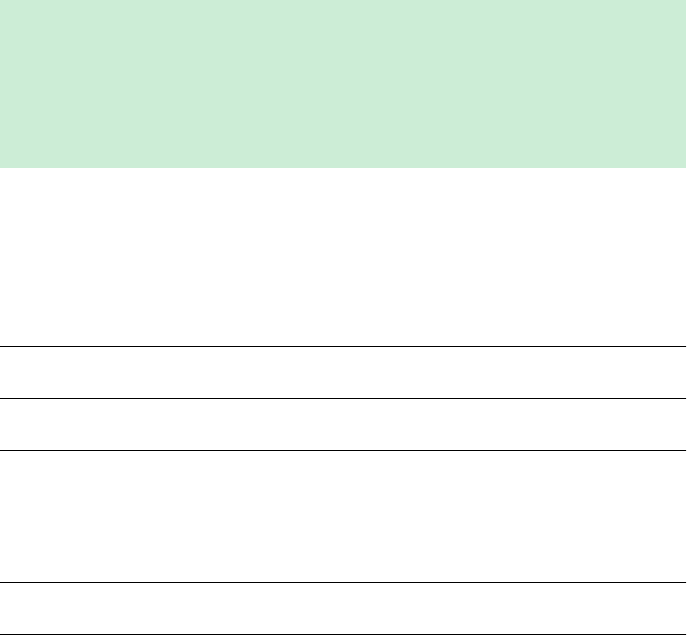
183
A.3 Example of barcode symbologies
The barcode samples shown here are for illustration purposes only. If printed out, they can be
used to check the barcode scanner. However, they are not meant to be used as a reference for
size or resolution of real patient or operator ID barcodes. When creating patient or operator bar-
codes always refer to the relevant standard ISO/IEC 15416 and 15415 for size and resolution
requirements and to the specification listed below.
EAN 13 barcodes, although widely used in retail, are less recommendable for patient/
operator barcodes. If used nonetheless:
■they demand the very highest quality standards of barcode creation and reproduction
■the start sequences 978 (ISBN) and 979 (ISMN) may not be used and will be ignored as a
part of any ID code
The use of Interleaved 2/5 barcodes is not recommended.
Recommended Specification Remarks
Print resolution 300 dpi preferred
200 dpi minimum
At 200 dpi issues with the wide-to-
narrow ratio may exist.
Reflective contrast 70% or greater Matte finish is preferred over gloss
finish.
Symbol grade Grade C or above
Grade B is preferred
Symbol grades are A-F based on
analysis of several quality elements.
Depending on quality grade
parameters for a specific bar code,
grade C may not be sufficient
when motion, reflection, or poor
lighting occur.
Module width
(minimum)
0.16 mm (linear barcodes)
0.20 mm (2D barcodes)
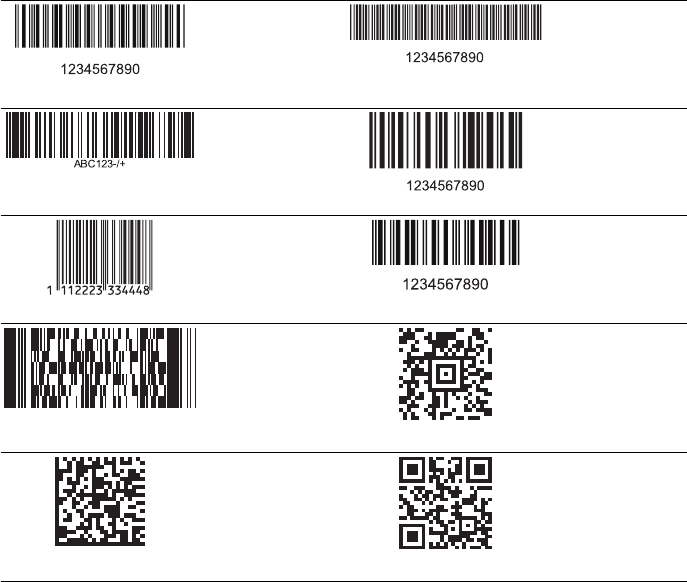
184
Codabar Code 39
Code 93 Code 128
EAN 13 Interleaved 2/5
without checksum
PDF417 Aztec
DataMatrix QR Code
Roche Professional Diagnostics
Roche Professional Diagnostics
Roche Professional Diagnostics
Roche Professional Diagnostics

185
A.4 Supported characters in 2D barcodes
The 2D barcode scanner is able to read characters from the following unicode ranges:
■Basic Latin (0021-007E)
■Latin-1 Supplement (00A1-00FF)
■Latin Extended-A (0100-017F)
The 2D barcode scanner does not support Asian characters.
186
This page intentionally left blank.
187
B Appendix
B.1 Option: Wireless network (WLAN)
Preliminary note
Appendix B has been developed to explain the wireless communication principles of the
cobas h 232 system1 and to help your facility’s information technology/management team(s) in
effectively deploying the cobas h 232 system on your wireless network.
Whether your meter has wireless capability or not depends on the system configuration that you
purchased.
Background
The cobas h 232 meter can only be configured through a data management system to communi-
cate wirelessly. The data management system is also used to set-up and configure the meter to
connect to one hospital specific Wireless Local Area Network (WLAN2). WLANs use electro-
magnetic waves in the 2.4 and/or 5.0 GHz frequency range to wirelessly transmit data3. The
cobas h 232 system adheres to IEEE Standard 802.11g (2.4 GHz range)4. The system is back-
wards compatible to 802.11b. During wireless communication to an Access Point (AP), the
cobas h 232 meter recognizes the existent AP WLAN protocol configuration (802.11b or 802.11g)
and automatically transmits data using the appropriate communication protocol5.
1. The cobas h 232 system is certified by the Wi-Fi Alliance.
2. WLAN is also commonly referred to as wireless LAN or Wi-Fi.
3. For the wireless functionality to work properly, the wireless module must first be configured by your
system administrator.
4. While the cobas h 232 system adheres to the 802.11g standard, it uses only channels 1-11. Channels
12-14 are not used by the system.
5. WLANs are organized in cells. A typical WLAN cell consists of Access Point(s) that are connected to
the (wired) Local Area Network and one or more clients, e.g., cobas h 232 meters along with other
clients such as portable computers.
188
The loss of signal or access to bandwidth of one particular client may vary depending on one or
more of the following situations: the type and number of other clients, the performance of the
Access Point, the presence of electromagnetic disturbances, and other potential interfering fac-
tors, e.g., concrete walls.
The cobas h 232 meter uses a burst-like communication protocol that will only consume band-
width if there is actually data to be transferred. Compared to other applications, such as Voice
over Internet Protocol (VoIP) or multi-media applications, the meter’s bandwidth consumption is
minimal. If the WLAN that the cobas h 232 meter seeks to connect to is degraded, the meter
design minimizes the impact on functionality.
Technical implementation
Prior to connecting any wireless device to a wireless network, it is recommended that a WLAN
site survey be performed. The goal of a WLAN site survey is to ensure that Access Points will pro-
vide enough coverage and performance to support any new radio frequency (RF) application or
device. The survey will also detail RF signals, including all existing WLANs along with any com-
peting RF signals and interferences (building structure related and other wireless equipment /
devices).
As part of an RF implementation of the cobas h 232 system, it is recommended that at minimum
one base unit be hard wired per floor. A networked base unit provides redundancy if a wireless
network malfunctions or loses service. If the cobas h 232 meter with RF is used in an area with
low signal or interferences, it is recommended to install a connected base unit for redundancy.
The redundancy of the connected base unit allows immediate transmission of patient results
when the meter is docked.
189
The current RF system consists of an antenna and a WLAN system-on-chip (SoC) along with
other components. The WLAN system-on-chip is the core of the WLAN system. The RF system
used in the cobas h 232 meter specifically adheres to the following specifications:
■Its WLAN system-on-chip supports IEEE 802.11b and 802.11g. It works seamlessly
together with other Wi-Fi certified transceivers. It also implements the Wi-Fi Protected
Access (WPA™ - Enterprise and WPA™ - Personal), Wi-Fi Protected Access 2
(WPA2™ - Enterprise and WPA2™ - Personal), and Wired Equivalent Privacy (WEP) secu-
rity mechanisms with Temporal Key Integrity Protocol (TKIP) and Advanced Encryption
Standard (AES).
In addition, the system supports the extensible authentication protocol (EAP) with
EAP-TLS, EAP-TTLS/MSCHAPv2 and PEAPv0/EAP-MSCHAPv2. The cobas h 232 meter
interoperability Wi-Fi certificate can be accessed at
http://certifications.wi-fi.org/search_products.php.
Further information including a glossary of terms, frequently asked questions, and other
topics related to Wi-Fi technology can be found on the Wi-Fi Alliance site
(http://www.wi-fi.org/).
■The used channels in the 2.4 GHz-band are channels 1-11. (Channels 12-14 are not used
by the cobas h 232 meter.)
■RF output power is approximately 15 dBm at a data rate of 54 MBPS.
190
RF specific functionalities and effective performance claims
The cobas h 232 system offers the option of wireless network connectivity (WLAN/Wi-Fi). If you
purchase a system with this option, the WLAN function is enabled during production.
This module can only be configured by a data management system (DMS), which activates the
meter’s wireless communication and data transfer capabilities. Wireless connectivity can help to
ensure that updates to information in the DMS are sent immediately to all networked meters.
Meters with an integrated and activated wireless option use the base unit for recharging and/or
as a redundant communication option to exchange data with the DMS.
The meter also has to be docked if the hospital changes security protocols. When this change
occurs, it may lock out all meters until docked and reconfigured with the new protocol.
As described above, the cobas h 232 meter supports the 802.11g standard. This translates into
the following RF specific performance claims:
■The cobas h 232 meter is capable of transferring to a suitable DMS, via WLAN, a data set
of up to 1000 result records, 100 reagent records, and 500 operator ID records in less than
15 minutes, when operated in a typical WLAN environment (correct WLAN administra-
tion, typical population of other clients present, any of the supported security models ena-
bled).
■A cobas h 232 meter with wireless connectivity enabled will communicate results after
every test or when the meter is idle; it will automatically attempt to communicate with the
DMS every 10 minutes. In line with the industry communication standard POCT1-A, the
DMS must acknowledge the meter’s request for connection and actively query for the
result. Only upon receipt of this DMS query, the meter will send the result. Hence the
effective time for transmitting results depends on infrastructure, DMS workload, etc.
Once the DMS sends a query, however, the meter will respond within a few seconds.

191
A typical range for direct connection between the cobas h 232 meter and the access point (air,
direct view, low disturbances) is up to 15 to 20 meters (49 to 66 feet). The actual range depends
on the positioning of the access point’s antennas and other topological properties of the space
between WLAN device and AP. Additionally, dynamic control of the transmitting power of the
access point may reduce the maximum distance between WLAN device and AP within which
communication can be guaranteed.
The cobas h 232 system is designed such that it coexists with other wirelessly communicating
devices. The cobas h 232 system does NOT include any real-time or even time critical wireless
functionality. It communicates exclusively single, digital data fields. It does NOT communicate
continuous waveform data.
Note: A degraded Quality of Service (QoS) of the WLAN communication will not impact the
functionality of the meter but may delay the communication of results to the DMS. Users
should be aware that real-time communication of test result readings cannot be guaran-
teed by the cobas h 232 meter.
192
This page intentionally left blank.

193
C Supplement for Observed Test Sequence
Observed Test Sequence (OTS)
The Observed Test Sequence (OTS) function allows an observer (supervisor) to assess and record
an operator’s performance (e.g., for recertification purposes). The observer monitors an operator
during a test to check that the test is being performed according to the recommended proce-
dures. He/she then evaluates the performance and passes or fails the operator. This assessment
is saved together with the test result and any desired comments.
Observed Test Sequence options can only be configured using a DMS. The availability of
electronic configuration options will thus vary according to the data management software
utilized by your institution. Consult your system administrator.
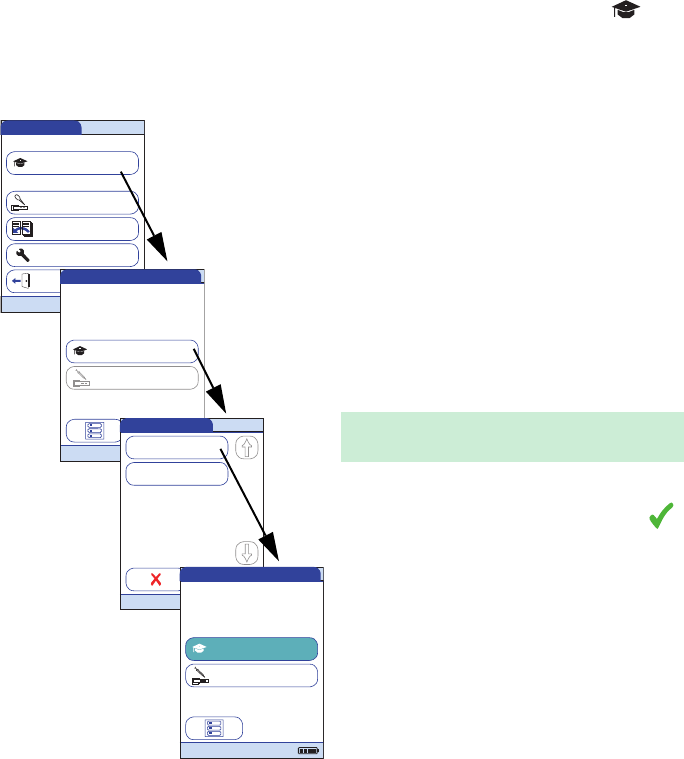
194
Using the OTS function
A request for an Observed Test Sequence comes from the DMS. The presence of the icon
on the Patient Test button indicates a pending OTS request.
Observer:
1Touch Patient Test.
In the Pat. Test -OTS menu, the Patient Test
button is grayed out (disabled) until the
observer has logged in.
2Touch Observer Login.
3Wait until the observer list is displayed.
4Select your observer ID by touching the
corresponding button, or scan your
operator ID (which is also your
observer ID in this case)..
Only operators with OTS observer rights are
listed in the Observer Login list.
5Enter the (optional) password.
6After you enter your password, touch
to log in. The Pat. Test - OTS menu is dis-
played again. The Patient Test button is
now active.
7Hand the meter to the operator who can
now perform the patient test under
supervision.
Main Menu
Control Test
Review Results
Setup
Patient Test
Logout
09:15 am
04/19/2015
Pat. Test - OTS
04/19/2015
Observer Login
Patient Test
OTS enabled
Observer 09:15 am
04/19/2015
Ann Casey
Alan Smithee
Scan
Pat. Test - OTS
04/19/2015
Observer Login
Patient Test
OTS enabled
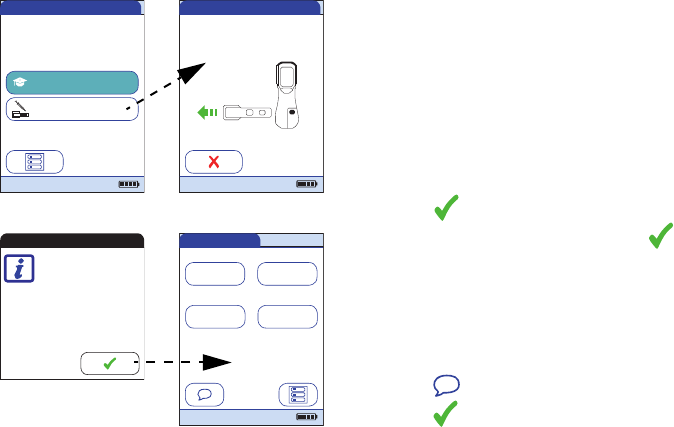
195
Operator:
1Touch Patient Test.
Perform the patient test as usual. Once the
test is completed, the observer has to com-
plete the next steps.
2Hand the meter back to the observer.
Observer:
3Touch to log in again.
4After you enter your password, touch
to proceed with the assessment.
5Assess the operator’s performance by
touching Pass or Fail.
6Assess the test result by touching Accept
or Reject.
7Touch to add a comment.
8Touch to return to the Pat. Test - OTS
screen.
The OTS information is saved together with
the test result.
Pat. Test - OTS
04/19/2015
Observer Login
Patient Test
OTS enabled
Observer Login
I-010
Observer ALAN SMITHEE,
please log in to proceed.
Otherwise the OTS test will
not be complete.
Observer
OTS passed:
Pass Fail
09:15 am
04/19/2015
Measurement Result OK?
Reject Accept
Comment:
Remove Strip
Remove Strip
04/19/2015
196
This page intentionally left blank.
197
D Contact Roche
For all questions about the cobas h 232 system that are not answered in this manual, contact
your Roche representative. If you do not already have contact details, visit our website on
www.roche.com. Select "Roche in your country" at the top of the page and then select your coun-
try to find the appropriate local office contact information.
The cobas h 232 system is manufactured for and distributed by:
Roche Diagnostics Australia Pty Limited
ABN 29 003 001 205
31 Victoria Avenue
Castle Hill, NSW, 2154
198
This page intentionally left blank.
199
Index
A
Administrator ..................................................... 83
Administrator ID
Change ......................................................... 87
Disable ......................................................... 88
Set up .................................................... 83–86
Application area ............................................... 29
Apply sample ...................................................129
Opening (meter) ....................................... 25
Auto off ................................................................ 62
B
Barcode ................................................... 121, 126
Masks .........................................................182
Symbologies .............................................184
Barcode (test strip) .......................................... 29
Barcode reader ................................................. 29
Barcode scanner .............................................. 25
Basics (setup) ............................................. 49–63
Battery pack ....................................................... 27
Installing or replacing ...................... 36–40
C
Cleaning .................................................. 167–172
After mispipetting ..................................170
Housing - outside ..................................171
Test strip guide .......................................172
Cleaning lockout ............................................106
cobas h 232
Contents of the pack .............................. 13
Introduction ................................................ 11
Operating conditions ............................177
Overview of meter elements ......... 24–26
Test principle ............................................. 13
cobas IT 1000 .................................................... 11
Code chip ......................................... 29, 116–117
Opening ....................................................... 26
Comment (custom) .......................................134
Comment result ..............................................134
Computer ............................................64–68, 160
Connection .................................................. 64–70
Contact Roche ................................................ 197
Contents of the pack .......................................13
Contrast .........................................................49–50
Control material .............................................. 138
Custom range ........................................103, 104
D
Data handling .............................................64–81
Data Management System
(DMS) ....................................73, 83, 91, 92, 159
Data transfer ................................................... 159
Date ................................................................53–54
Diagnostics ..................................................80–81
Display format .............................................57–58
Disposal ...................................................... 17, 115
E
Error messages ............................................... 173
H
Handheld Base Unit .........................................36
Handheld battery pack ............................25, 35
I
Icons: see Symbols
ID setup .........................................................82–93
Overview ......................................................82
Infections (safety instructions) ................. 115
Infrared interface .................................... 26, 159
IQC lockout ...................................................... 101
L
Language ......................................................51–52
Lockout ....................................................... 94–108
Cleaning lockout .................................... 106
IQC lockout .............................................. 101
New lot lockout ...................................... 100
Operator lockout ................................95–97
QC lockout ............................................... 100
200
M
Meter
Reset ...........................................................176
Meter setup
Administrator ID ................................83–86
Auto off ........................................................ 62
Basics ....................................................49–63
Cleaning lockout ....................................106
Computer .............................................64–68
Contrast ................................................ 49–50
Data handling ..................................... 64–81
Date ........................................................ 53–54
Diagnostics .......................................... 80–81
Display format .................................... 57–58
ID setup ................................................ 82–93
IQC lockout ...............................................101
Language .............................................51–52
Lockout ...............................................94–108
New lot lockout .......................................100
Operator ID .......................................... 89–91
Operator lockout ............................... 95–97
Optional screens ........................... 109–111
Overview ............................................... 44–48
Patient ID ..............................................92–93
Printer ....................................................69–70
QC lockout ................................................100
QC result format ........................... 102, 103
QR Code ............................................... 65–67
Reset test parameters ...........................105
Result confirmation ...............................111
Result display mode ......................... 78–79
Result login ...............................................110
Result memory ................................... 71–74
Result unit ............................................ 75–77
Sound ....................................................59–61
Start info ....................................................110
STAT test ...................................................107
Time ........................................................ 55–56
N
New lot lockout .............................................. 100
O
Observed Test Sequence (OTS) ......193–195
On/Off button .....................................................25
Operating conditions .................................... 177
Operating the meter .................................35–??
Operator ID .............................. 89–91, 120–122
Operator list ............................................121, 161
Operator lockout ....................................... 95–97
Optional screens ...................................109–111
Ordering information .................................... 178
Overview of meter elements ................. 24–26
P
Patient ID .................................. 92–93, 124–126
Patient list ......................................124–126, 162
Power adapter
Connection .......................................... 26, 30
Power supply ......................................................27
Contacts (Handheld Base Unit) ..........26
Powering on the meter .............119, 139, 151
Printer ............................................................ 69–70
Product specifications ................................. 177
Q
QC lockout ....................................................... 100
QC result format ....................................102, 103
Quality control ........................................137–149
Control material ...................................... 138
IQC (instrument-specific) ..........147–149
Pass/Fail .................................................... 149
Preparation ............................................... 137
QC (test parameter-specific) ....139–145
201
R
Reset ...................................................................176
Reset test parameters ..................................105
Result confirmation ............................. 111, 133
Result deletion (automatic) .......................... 74
Result display mode ................................. 78–79
Result login ............................................ 110, 132
Result memory ..................................71–74, 151
Result unit .................................................... 75–77
Review results ....................................... 151–164
All results ..................................................154
Data transfer ............................................159
IQC (instrument quality control) .......156
Maintenance ............................................157
Patient history ..........................................153
QC (quality control) ...............................155
RF (radio frequency) ..............................22, 188
S
Safety
Protection against infection ................. 15
User qualification ..................................... 15
Sample material .................................... 115, 178
Scan (button) ......................................... 121, 126
Self-check (powering on the meter) ......119
Software license .............................................180
Sound ............................................................ 59–61
Specifications ..................................................177
Start info ............................................................110
STAT Test ............................................................ 94
Perform ......................................................136
STAT test
Configure ..................................................107
Storage ...............................................................165
Storage and transport conditions ............178
Symbols
Code chip ........................................ 128, 141
Error messages .......................................173
Hourglass ...............................130, 143, 144
Meter ...............................................................5
Packaging ......................................................5
Pipette .............................................. 128, 142
Screen ................................................... 31–33
Thermometer ................................. 128, 142
T
Test ............................................................113–136
Performing .......................................123–136
Preparing .........................................115–122
Sample material ..................................... 115
Test area ..............................................................29
Test principle ......................................................13
Test steps (overview) ................................... 118
Test strip
Inserting ...........................................127, 140
Lot ..................................................................98
Test strip guide ..................................................26
Test strip guide cover .....................................25
Time ................................................................55–56
Touchscreen ................................................25, 43
Troubleshooting ............................................. 173
W
Wi-Fi ......................................................................22
WLAN ................................................................. 187
202
This page intentionally left blank.

0 7469101001 (01) 2015-XX EN
ROCHE CARDIAC, COBAS, COBAS H
and IQC are trademarks of Roche.
Roche Diagnostics GmbH
Sandhofer Strasse 116
68305 Mannheim, Germany
www.roche.com
www.poc.roche.com
